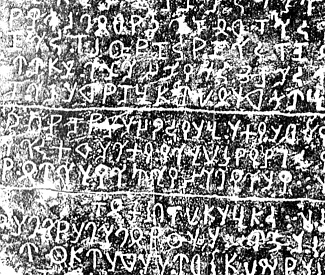

Zitierweise / cite as:
Payer, Alois <1944 - >: Quellenkunde zur indischen Geschichte bis 1858. -- 16. Quellen aus der Zeit des British Raj. -- 8. Zum Beispiel: The people of India : a series of photographic illustrations / India Museum, 1868 - 1875 <Auszug>. -- Fassung vom 2008-06-18. -- http://www.payer.de/quellenkunde/quellen1608.htm
Erstmals publiziert als:
The people of India : a series of photographic illustrations, with descriptive letterpress, of the races and tribes of Hindustan, originally prepared under the authority of the government of India, and reproduced by order of the Secretary of State for India in Council / edited by J. Forbes Watson [1827 - 1892] and John William Kaye [1814 - 1876]. -- London : India Museum, 1868-1875. -- 8 Bde. : Ill. ; 32 cm. -- In v. 1-3 the letterpress is by various authors; in v. 4-8, by Meadows Taylor [1808 - 1876]. -- Bd. 4. -- 1869. -- Nr. 182 - 207. -- Online: http://www.archive.org/details/peopleofindiaser01greauoft. -- Zugriff am 2008-06-17. -- "Not in copyright."
Erstmals hier publiziert: 2008-06-18
Überarbeitungen:
Anlass: Lehrveranstaltung FS 2008
©opyright: Public domain.
Dieser Text ist Teil der Abteilung Sanskrit von Tüpflrs Global Village Library
Falls Sie die diakritischen Zeichen nicht dargestellt bekommen, installieren Sie eine Schrift mit Diakritika wie z.B. Tahoma.
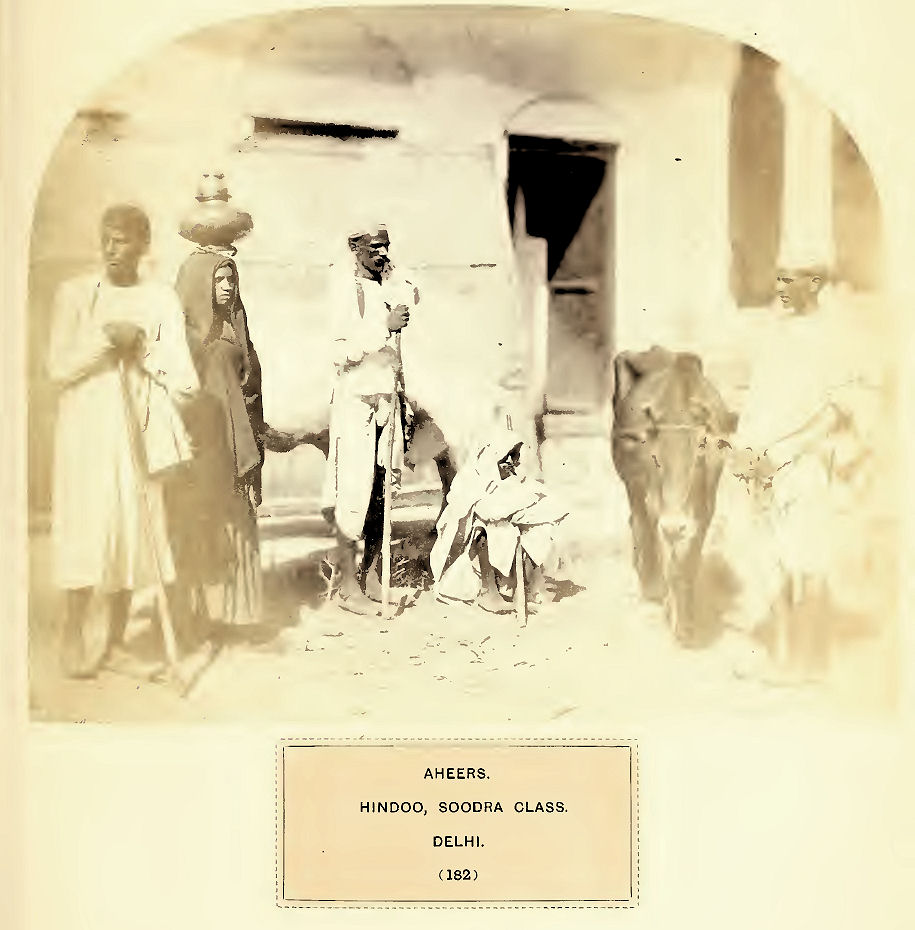
Abb.: Aheers. Hindoo, Soodra class. Delhi
(182)
The Aheers are one of the most ancient, as they are one of the most widely spread tribes in India. It is impossible to say, indeed, where they are not, throughout the length and breadth of the land. It is alleged by some, that they are Aryans of the lowest degree ; and this is possible, though there is no question that the race is now grafted, as it were, on aboriginal stock. The Aryans, originally a pastoral people, had no doubt large flocks of cattle, mikh cows and buffaloes, belonging to them ; and a particular class may have attended to them. It would hardly be as if India had supplied cattle, and a peculiar tribe or sect to manage them ; and yet it is perfectly possible that the sect may have arisen out of converts from the aboriginal classes, and the existence of the Aheers everywhere, with the same customs, but not the same language, goes far to prove this assumption.
Aheers are keepers and tenders of cows and buffaloes ; they trade only upon milk, and the preparations from it. They never keep goats or sheep, but breed and feed calves; selling them, however, as soon as they are fit to work as bullocks, or, indeed, generally as soon as the calves are well reared, to persons who train them for carriage or for drafts. There are not many preparations from milk in India. Butter, "ghee," and "dhye," or sour curd, are universal ; but cheese is only produced occasionally for Mahomedan customers. Hindoos do not eat it, and it is made of the consistence of cream cheese, to be eaten fresh. It does not keep. Butter is churned from the milk as soon as milked, in the early morning and evening ; but it is rarely used in this state, except by Europeans and Mahomedans. It is made into ghee—that is, the butter is boiled until all the watery particles and curds have been thrown off by repeated skimmings. When the liquid is clear oil, it is poured into a vessel to cool, which it does in a granulated form ; and will keep for years if originally well boiled, without taint. It is curious, perhaps, why this process has never been tried in Europe, as a much more certain and more cleanly method of preserving butter than salting it. Instances have been known of the discovery of old ghee vessels in forts and arsenals of India, the contents of which, reboiled, were perfectly good; yet these must have been two hundred years old, if not much more. Ghee is the chief manufacture of all Aheers, and is their chief object. In a hot country milk is a very perishable article ; but converted into ghee, is at once secured. The next product is dhye, or sour milk. It is the "yaoort" of the Turks, the "sauer mikh" of the Germans, and, except in England and France, is used as generally throughout Europe, as it is universally in the East. The Aheers make it of several degrees of sourness, to suit the taste of their customers, and the process of making it differs from the German method. A porous earthen vessel is rubbed inside with a little of the previous day's curd, and boiling milk is poured into it. This sets almost directly, and the watery parts are absorbed by the vessel. Such pots of dhye are reserved for special customers ; for the rest, the day's dhye is all mixed together, and is sold, like buttermilk, which it much resembles as it is shaken up, to all who need it, either in the maker's house, or hawked about the town, village, or camp, by the Aheer women. The morning and evening cry of "Dhye-a-a-a" will be familiar to every one who has visited or travelled in the country. Every native eats dhye. It is cooling and wholesome. It is used plain, with rice or bread, and in all sorts of cookery both vegetarian and otherwise, and equally by Hindoos and Mahomedans.
Aheers are agriculturists as well as milk dealers ; and are very steady, good farmers, where they take up the profession. But all Aheers are not farmers ; and, indeed, tilling the ground is generally a secondary consideration. In Bengal and the North-West Provinces they act as cart drivers, but not particularly in this respect in other parts of India. They often take large ranges of pasturage on the lower Himalayas, and especially in the Vindyas, Satpooras, and other mountains of Central India, to which they resort with their families and herds of cattle at the end of the monsoon, when the grass ripens, and the hills become healthy. They form small villages of grass huts for mutual protection ; and here cattle are fed, and ghee made, which is sold to merchants as fast as it can be stored.
There are eight clans of Aheers, the chief of which is the Nund-bunsee, which has a religious pre-eminence on account of having protected and brought up Krishna, the incarnation of Vishnu, whose worship is now so universal among Hindoos, and who is the hero of so many popular tales and legends. Krishna was born near Meerut, of the Yadava tribe of Cshuttrees ; though it is often doubted whether he came of so exalted a race. Kansa, the Rajah of Muttra, desired to put him to death, when Nund, and his wife, Jesodha, who were Aheers, took charge of him from his mother, concealed him, and brought him up. Krishna grew up a frolicksome youth ; and his amours with the milkmaids, his dances with them, and the like, form subjects of popular recitations and ballads of a prurient character, while the great acts of his life, and his religious precepts, are detailed in the Mahabharat.
The Aheers, at one period in the history of India, were ruled over by princes who possessed large territories, and they were the founders of many of the remarkable mountain forts. They are called Gwalas or Gaolies, as well as Aheers, and Gualior, Gawulghur, Gokonda or Gwala-conda, &c., and many other places, have been named by or after them. Aseerghur, the famous fortress in Khandesh, was called after Asa Aheer, a famous Aheer prince, who possessed Khandesh, Berar, and other neighbouring provinces. In the commencement of the fifteenth century the fort was taken by a treacherous stratagem, by Nusseer Khan Farookhy, Mahomedan king of Khandesh, who destroyed the family, plundered the fort of vast treasures, and annexed its dependencies to his own kingdom. Many centuries before this period, as Colonel Briggs states, the temple (fort) of "Asa," was celebrated as the residence of Aswathama, a local Hindoo sovereign.
The Aheers have now no chiefs or head men ; they have become completely absorbed into the Sudra class of India. They do not, however, marry out of their caste, and their ceremonies are performed by Brahmins in the Bhanwar, or first-class marriages ; but in the second class, or Darejha, there is a feast to friends and neighbours, which is sufficient. Widows can many under the second rank.
Aheers are vegetarians for the most part, and live much upon milk and ghee, but they do not object occasionally to eat kids or goats, which they have sacrificed. They refuse game and wild hog. Brahmins of some castes, not the highest, will take water from Aheers, on account of the purity of their caste and life. They are a sober quiet people, occasionally taking spirits, especially when they live in jungles, though not to intoxication ; nor do they indulge in opium, but smoke tobacco. They have no pretension to be called soldiers, though they sometimes enlist in the native infantry ; they are, however, in general, a fine strong race, capable of undergoing much fatigue, and in this respect do not vary throughout India. As might be supposed from their occupation of cowherds, Aheers are for the most part entirely uneducated. Very few can read or write, and they have little occasion to keep accounts, as they are never merchants. None among them are ever very rich, nor are any very poor. They make no pretensions on any score, and are everywhere a peaceful, contented race of people. They are always simply dressed, and their houses are very cleanly kept. The costume of the men is a white or chintz cotton jacket, or long tunic, quilted, or plain, according to the season, and a dhoti or waist cloth, also white, with or without a border. In the North-West Provinces the women wear the petticoat, bodice, and scarf, which have been adopted from the Mahomedans, and this costume is seen as far south as the Taptee river. In the south they wear the sari, or single piece garment, which is that of the ancient races. The figures shown in the Photograph show the costume of the Northern Aheers both for males and females very intelligibly.
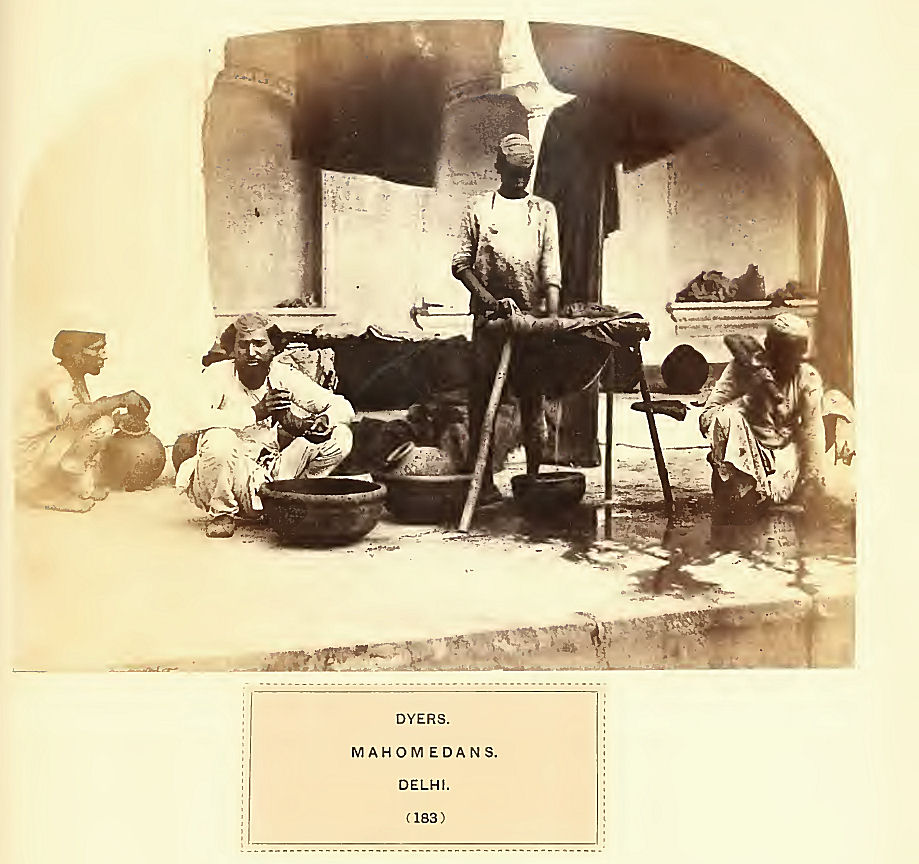
Abb.: Dyers. Mahomedans. Delhi.
(183)
The trade of dyeing is universal throughout India, and is carried on both by Hindoos and Mahomedans, apart, or in combination, as shown in the Photograph. In this picture, the standing figure, who is rubbing the mixed dye stuff through a cloth to strain it, is a Hindoo. The sitting figures—that is, the person who is wringing out a piece of cloth, and he who has a wooden mallet in his hand, beating a cloth, in order to equalize the colours—are Mussulmans. The materials for the trade, as will be perceived, are very simple. A few large pans for mixing the dyes, trestles for supporting the straining cloth, and a press, are all that are used in the simple operations of the craft. Hindoo dyers are of the Sudra class, on an equality with weavers and other similar artisans, and they are much more numerous than the ]Mahomedans, and, on the whole, better workmen. Tlie craft is hereditary ; and the secrets of mixtures of colours, methods of extracting the dyes, of the use of mordants, and of producing every variety of tint that may be necessary, descend from father to son, and have perhaps been little changed in the course of ages. It is evident that the art of dyeing is one of great antiquity in India. In descriptions of garments worn by males and females in the Mahabharat, colours are defined which could only be produced by dyes ; and in the pictures on the walls of the Buddhist cave temples of Adjunta, garments of many colours are shown, as well as coloured borders and ends to white cloths. These paintings, it is true, are of a much later date, even by a thousand years, than the poem of the Mahabharat ; but are still valuable specimens of the dresses and their colours in use in India from the second century before the Christian era, to the eighth or tenth century after it. Although not so brilliant, perhaps, as the dyes used in Europe, yet the colours produced by the Indian dyer are for the most part very pure and beautiful. They are of two kinds : one permanent, and used in fabrics which have to bear constant washing; the other fleeting, and intended for temporary use only. In the former category are the yarns for weaving both silk and cotton cloths ; in the latter, white cloths, such as muslin, any way. They are for the most part Sheikhs, and therefore Soonnies, and are a peaceful and industrious class of people, generally observant of the forms of their religion, and leading quiet, inoffensive lives, but esteemed of low grade. They do not rank as high as the Mahomedan weavers, nor are they so exclusive in their habits, or so bigoted in their religion. The Hindoo dyers are for the most part worshippers of Devi or Bhowani. They marry exclusively in their own gotes or divisions, and their profession is strictly hereditary. All their principal ceremonies, such as marriage and the like, are conducted by Brahmins •, but in some parts of India they have priests of their own, who regulate caste affairs, and read and recite translations of sacred works made into the local vernacular. They have in many localities a reputation for intemperance, and it is certain that the use of ardent spirits is not forbidden to them ; and they have, too, an indifferent character for morality. They are, however, a very useful, industrious, and inoffensive class ; principally inhabiting large cities and manufacturing towns, and exercising their vocation in peace.
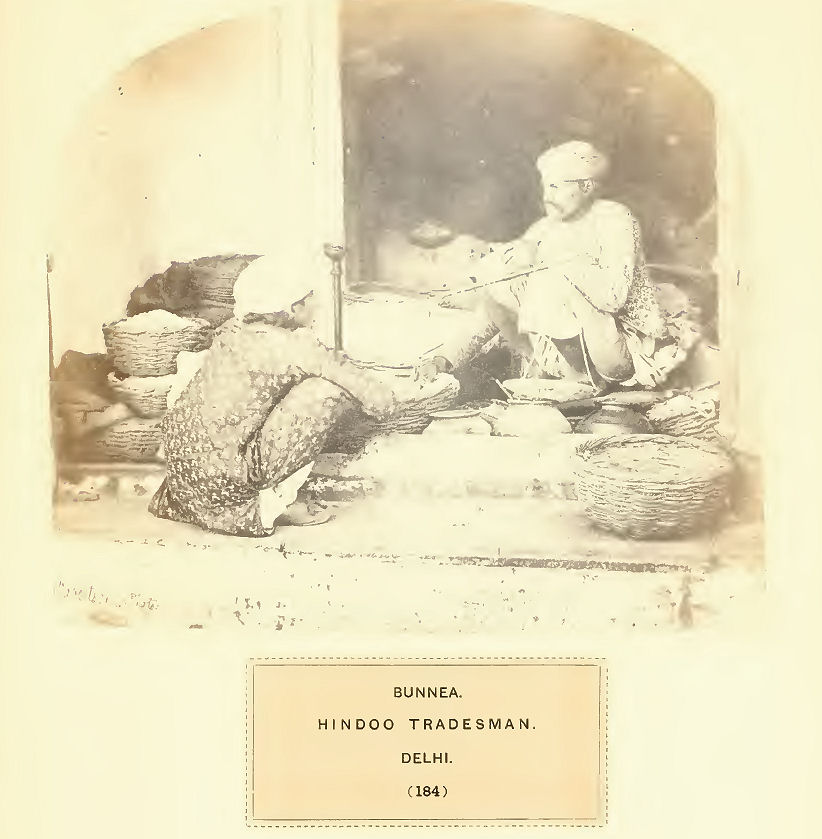
Abb.: Bunnea. Hindoo tradesman. Delhi
(184)
BUNNEAS are universal all over India. They are the hucksters or small traders of the people. A Bunnea's shop or stall contains meal and fine flour of wheat, with sogie or semoline, meal of millets and different kinds of pulse, rice, split peas, and pulse of many kinds ; for all these are used in the farinaceous diet of the people, which is almost universal. He sells also parched rice and peas, gram, or horse corn, and generally every article of food, except vegetables and meat, with which he has no concern. Beside these he has condiments, salt, chillies, black pepper, green and dry ginger, and garlic (but not onions), not omitting hing or assafoetida, which is used (a mere soupçon) with a peculiar lichen, by high caste people to purify and flavour made dishes. He has also a small store of spices—cassia, cardamoms, cloves, and mace ; sugar, too, of various kinds ; goor, or molasses ; and, in some instances, sweetmeats ; but they are never good. He sells also ghee, and many have some butter in the mornings for their Mahomedan customers ; but it is a perishable article, while ghee only becomes (if not well boiled) occasionally rancid in hot weather, and can be re-boiled. In short, the Bunn ea is grocer and purveyor in general in every village and town in India. Those who cultivate their own grain do not deal with him for meal and flour, and most likely make their own ghee; but for everything else above enumerated, and many other items left out, the Bunneas' shops are the resort of the people in villages and towns throughout the country. Travellers of all kinds, artisans, ordinary householders, and society in general, resort to the Bunnea, as we in England do to the grocer and huckster. The latter, with us, sells cheese and salted provisions, of which the Bunnea knows nothing ; but he has no objection to sell salt fish and dried prawns, whether from the coast or made in his own locality. All these articles are laid out in baskets plastered inside neatly with clay, or in small sacks and bags, as most convenient. What there is most demand for, generally "atta" or meal, ghee, and split pulse, is always before him with his scales ; but every thing else is within reach, and after the Bunnea opens his shop in the morning, he rarely moves during the day.
Although the Bunnea is a very useful, indeed indispensable, member of society, he is rarely a popular one. He is strongly accused of false weights, or, if the weights be true, of a peculiar and dexterous knack in managing the wooden beam of his scales, which have no centre pivot except a cord fastened to the beam, as shown in the Photograph, by giving it a cant in weighing, which is not detectable even by the sharp-eyed customer, and may make a difference of an ounce or two in the weight. He is considered an adept in sanding and watering sugar, and also in sanding flour, which has a peculiarly unpleasant effect upon his customers' teeth, and, not unfrequently, produces violent subsequent altercation. In short, he is suspected of adulterating, more or less—but in all cases as far as he can—everything that he sells ; and the amount of white pebbles in rice, and of dark stones in horse gram, are best known to those who have to sift them out.
The Bunnea also lends money, and exacts usurious interest : three per cent, a month compound interest is not, perhaps, extravagant, and is sometimes increased to four or five ; except in case of pledges of gold or silver, when the rate may be as low as twelve per cent, per year, or even less. He also lends money upon lands and houses, and is even ready to give advances upon crops, which he is to buy in payment of the mortgage when they are ready. On these points, indeed, he has the population of his village pretty well under his thumb, and poor folks dare not complain of sanded sugar, or rancid ghee. He is the purchaser in general of all the thread spun in his village, or buys what he can at fairs and markets. This he sells to weavers, and takes their produce in cloths pretty much on the same terms and conditions as he takes the produce of land. In this respect he exerts a particularly sharp influence on the Mahomedan weavers, who are more simple in general than Hindoos, and more easily cheated. In fine, the Bunnea wherever he is, in Bombay or Bengal, in Delhi or Madras, is essentially the same character, with very little variation of his business.
But if he has cheating propensities and indulges them to the utmost of his power, the Bunnea is a useful person, and contributes very largely to the furtherance of the general trade of India. If he gives usurious advances to cultivators, he is agent to some one else, in a large mart, for the purchase of local produce of all kinds, grain, cotton, hides and horns, ghee, and condiments ; and, having stored these, he forwards them as the season opens, or as often as he can. He little thinks perhaps that his bags of oil seed will go to Marseilles, or his madder, cotton, and sugar to Liverpool ; but they have yielded him a good profit, and he passes them on to others, who will make more than he has, in their progress to their ultimate destination.
It might be supposed, from the exclusive nature of their dealings, that the Bunneas would be a wealthy class ; but, as a class, they are on a mere average in this respect. Losses on produce and on bad loans may be heavy, and gains upon retail sales, the prices of which are so closely watched by the people, are comparatively very small. There is no trader more closely watched by the people than the Bunnea ; and in times of dearness of provisions or positive famine, he is an object of perpetual suspicion, and perhaps has his shop "looted" when distress comes to a head. Sometimes, when enriched by retail trade, the Bunnea becomes a sahukar, mahajun, or banker, and gives up "the shop ;" but this is rare. However large a fortune a real Bunnea may have made, he still keeps on "the shop," as his original source of "luck," and is not ashamed of "his father's calling."
Bunneas are Bunneas only ; few go into other professions or trades, and, though some have picked up education enough to serve as clerks, they have not ambition enough to rise, except to wealth ; as to education, it is of small account. Every member of the craft can " write and read, and cast accounts"—after a fashion ; and he can keep his books—also after a fashion, and that not a good one. For the most part, indeed, they are very illiterate, and care to know only what they must know.
As a class they are not esteemed, indeed, held in much contempt, which they bear meekly. As shopkeepers they receive much abuse, and are used to it ; nor is it a very unusual thing to see one of them suddenly throw down his tm-ban, leap into the street, and bawl furiously at the ill usage he has sustained from a customer ; which, after all, may have resulted from his attempts to cheat. But the wrongs of Bunneas receive little consolation from the bystanders, whose sympathies are with the indignant buyer ; and in turn the Bunnea can lord it over some one who needs money or credit for food. Thus Bunneas in general have no spirit ; they are cringing, and often very mean, as if they feel themselves to be of a degraded class. In caste, however, they occupy a respectable place, and are very particular as to religious observances, and are often very charitable. No wandering mendicant, be he who he may, ever begs without receiving a handful, or, at least, a pinch of flour or pulse. Many of them are Vaisyas, or of the third class in Hindooism, and the remainder of the fourth. They marry exclusively in their own castes, and their wives are very useful to them, and for the most part good women—though Bunneas are not esteemed good husbands—quite able to attend to the shop, if their husbands are absent at fairs or markets, or on local business. There is rarely more than one, and widows of the Sudra Bunneas are not debarred from a second marriage if they please. In the higher ranks they were famed in old times for becoming suttee with their deceased lords ; but that is impossible now. Bunneas are obliged to trust much to Brahmins for performance of religious rites ; and they have great faith in lucky or unlucky days, founded upon the expounding of the state of the planets by Brahmin astrologers. In most large towns they have a guild and a dean of guild, and many disputes are settled by the body ; but they are not unfrequently extremely litigious, resorting to the courts on every conceivable and inconceivable pretence. They were the origin of the Sontal war ; their exactions from that simple people having driven them into rebellion. "Jiska Bunnea yar, oosko dooshmun kya durkar ;" whoever has a friend in a Bunnea, what need has he of an enemy ; is a pithy Hindoostani proverb, which explains itself. "Too Bunnea ho ;" you are a Bunnea ; is a bitter term of abuse ; but the class is patient, and apparently yielding, and, in its way, long suffering ; and being by reputation, and in fact, arrant cowards, they resort to the coward's only protection—submission—until opportunity comes for retaliation. In native states they were often plundered, by exactions, and are still ; they are deemed fair game. In our own territory some of them have become millionaires, and the wealth of India, as a class, is with them. They rejoice in the contrast; and are one at least, of the classes of India, who gratefully acknowledge the protection they receive.
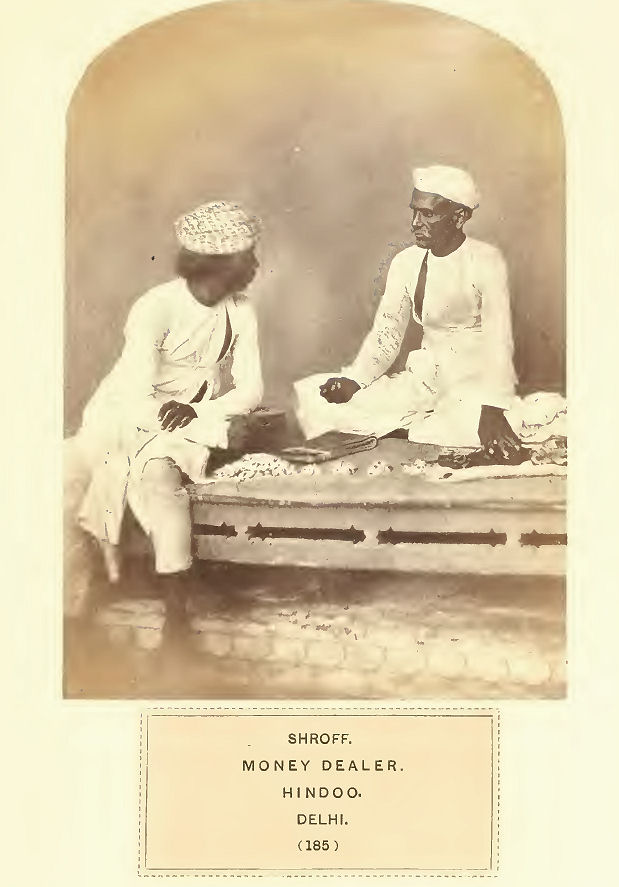
Abb.: Shroff. Money dealer. Delhi.
(185)
SHROFFS are not always Bunneas, though the person illustrated may have been one. They are not unfrequently Brahmins, who have adopted a secular calling, and deal in money—Khutris, and other castes, Vaisya and Sudra. Their trade is the exchange of money, the giving change for rupees in pyce or copper coin, and for pyce in cowries. There is generally an established rate for change. So many "gundas"—a gunda is four—of pyce for a rupee, and so many "gundas" of cowries for a pyce; and the rates depend upon the scarcity or otherwise of "change" in the local market. There are, besides, many former coinages, both English and native, still in circulation, each of which has its market value, and upon which the Shroff makes perhaps his greatest profit. He is possibly a shade more liberal than the Bunnea in the change he gives; and an intending purchaser of his daily food would rather accept the rate of a regular Shroff, than trust to the chance of the change of a Bunnea. In the latter case he would be sure to be cheated out of a few cowries ; in the former, he would get the bazaar rate for the day. In the Photograph the Shroff is represented seated cross-legged upon his bench, with piles of cowries before him, ready counted; and he is offering a handful of pyce to a Mussulman customer, who apparently doubts whether they are enough. Before him is his day-book, into which he enters the most minute transactions, and beside him his box and small bags of money. The stall of the Shroff is not unfrequently one of the gossip places of the local community ; for the Shroff has generally the news, whatever it may be.
In the higher branches of his calling, the Shroff discounts hoondees, or bills of exchange, bonds, and promissory notes, charging as much discount as he can get in all such transactions, which is often as sharp as it would be from a Jew broker of London or Paris. He deals also in bullion, in small or large quantities ; buys and sells ornaments, old and new pearls, and precious stones of all kinds, contriving to turn an honest penny by all. Finally, he lends money, generally on pledges of gold and silver ornaments, in small proportion to their value, but at moderate interest. He rarely perhaps makes advances on produce, as it is more in the line of the Bunnea than himself; but he lends money at high interest, and on the best security he can get. He is considered above the mean trickery of the Bunnea, and often ranks as a "Bhula-admee," a "good fellow," in popular estimation. It would be no reproach to be called a Shroff, but it would be unpardonable insult to be called a Bunnea. A Shroff may remain a Shroff all his life, if he have not luck. If he has been fortunate, however, he becomes a Sahoukar, or Mahajun, and enlarges his transactions. He now watches the money market, speculates in stock, and establishes agencies in other cities, upon which he can draw bills of exchange, or hoondees, the ordinary form of remittance in India. Thus in time he becomes, perhaps, a great banker ; and his transactions may rival those of a similar profession in Europe. Men who have thus risen, as it were, from the ranks, are by no means uncommon in India, and are proud of declaring that they have done so. Shroffs have, from constant experience, an extraordinary skill in detecting false or light coin. They will sit down patiently to count and examine thousands of rupees. One will merely count, and pass on the heaps ; another will pass each rupee through his fingers, and detect, no matter how skilfully it has been executed, a false coin, or one ''sweated" or short of weight. The milled Company's rupees are next to impossible of correct imitation by native coiners ; but the coin of native states, which in form and in impress is very rude, affords ample field to the coiner for the exercise of his skill, which only a Shroff could detect. He is an excellent judge of gold, testing its value by his touch stone, and deciding upon the colour, the grain it leaves upon the stone, and other indications. He can tell also how much good gold there is in a piece of jewellery, and especially, if he intends to be a purchaser, how much adulterated : how much lead has been run into apparently solid portions of it by the goldsmith, and where, to the disappointment, very frequently, of the owner, who finds out how deeply he has been cheated.
Shroffs are a steady, money-getting, class of people. While they are not educated in any intellectual sense of the word, they are not ignorant, and are good accountants and book-keepers. Their system is that of double entry, which is, at least, as old as the institution of Menu, and may be older. The Shroff keeps a day book and ledger, and is very particular about them, worshipping them as all bookkeepers do, at the festivals of the Dussera and Dewallee ; and at the latter he may gamble a little, just to test what sort of luck he is to have during the next year. The village Shroff is frequently the goldsmith ; but the town or city Shroff is above an artisan in social class, though not in caste. The village Shroff goes about to fairs and markets in a certain circle round the country. The town Shroff does not wander. The habits and daily work of all is, however, the same, and wherever they are seen all over India, there are the same small piles of cowries and of pyce, and their owner sitting above them.
Where the caste of Shroffs may be different, some Brahmins, some Vaisya, and some Sudra, it is impossible to give any definite description of religions beliefs as they follow their own caste rules, whatever they may be. Shroffs are needed in public treasuries, and often rise to the rank of native treasurers and head accountants. They do not enter into competition for other civil appointments, and, as a rule, prefer their own profession to service of any kind. If they attain wealth as bankers, Shroffs are generally very liberal, open-handed, if not, indeed, ostentatious; especially on occasion of marriages and social entertainments. They give largely to Brahmins, and more especially to those classes of religious devotees who belong to their caste ; though none are refused portion of the daily dole of meal and pulse which is given at the door, or of cakes of bread which are set aside from the family heap. With the Bunneas and other mercantile classes, the Shroff in British territories feels perfect security, and is thankful for it. In native states his position most likely was insecure, and a perpetual struggle how to avoid and escape exaction. He had also to protect himself against dacoits and robbers, until he grew rich enough to hire soldiers of his own, which, if a heavy tax upon his industry, yet afforded means for the coercion of debtors, with which the native state did not interfere, nor with the practice of "dharna" upon emergency. This dharna was a last resource to recover money from a powerful debtor, and was exacted in various forms. The lender sat fasting at the door of his debtors house, or he made cuts in his arm or breast at stated periods, defiling the threshold with his blood ; or he seized a son or a brother of his debtor, and kept him in durance, with many other ingenious devices of annoyance and positive torture. These are impossible in British territory now, under the provisions of special acts ; but in native provinces, where there are no courts of justice, the Shroff, or Mahajun, has often to take the law into his own hands, and get his money as he can.
The Shroff, or, more correctly, Suraff, is known all over the East; and from the solid phlegmatic Turk with the large turban, sitting gravely in the midst of his piles of small coin in a Constantinople bazaar, to the shrewd Copt of Egypt, and the keen Hindoo of India, his occupation and aim in life are precisely the same.
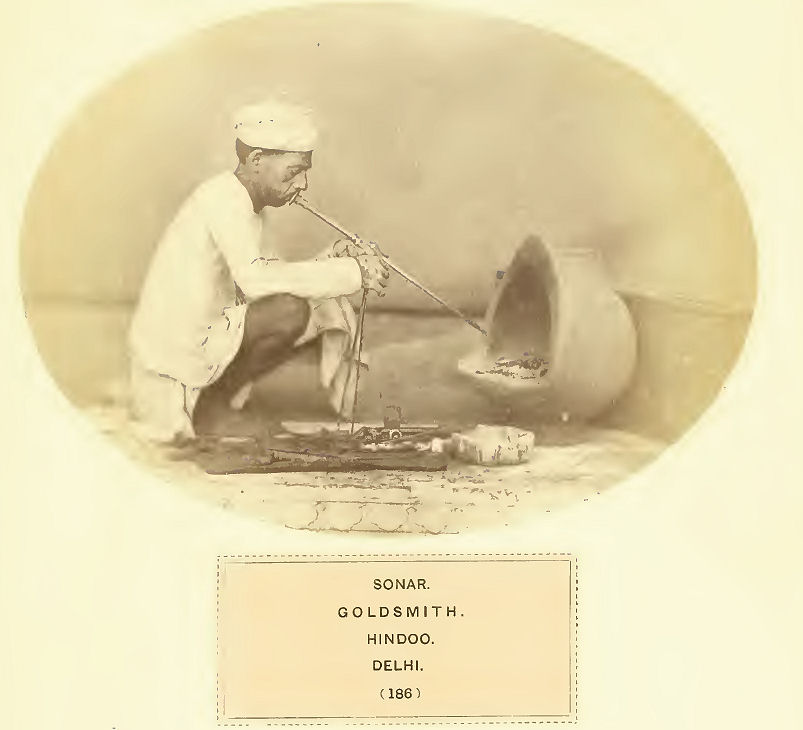
Abb.: Sonar. Goldsmith. Hindoo. Delhi.
(186)
This is a most useful and ingenious class of artisans all over India. Where there are no savings banks, or modes of local investments, and where if there are any, the people do not trust them, or are as yet ignorant of their use, they invest their gains or savings in gold and silver ornaments, which can be converted into money, or pledged at low interest, as occasion may require. This may be considered a rude condition of society ; but it is the fact, nevertheless, and the enormous amount of precious metals which India has absorbed during the last few years, and which is still there, hidden among the people in the form of ornaments, is a proof of the great prosperity and wealth to which the country in general has attained. It was stated of Berar, one of the great cotton provinces, that there were not Sonars enough to make up the gold and silver which flowed in a continuous stream into it during the English cotton famine ; and it is very certain none has flowed out again. Nor has this wealth been unproductive ; for most of it has been applied to the land, and every acre of culturable soil in that province is now under tillage.
The Sonar is, therefore, an indispensable member of the Indian social condition of life ; and he is to be found in every village, almost in every hamlet, as well as in all towns and cities. In the Deccan, where original national institutions are preserved in village communes, and wherever they are at present existent throughout India—the Sonar is a member of the hereditary village council, which includes the carpenter and blacksmith, the potter, and other useful and indispensable mechanics, and is twelve in number, presided over by the patell, the hereditary magistrate or head manager. For his services to the village and its people, the Sonar receives a share of established collections of grain and other produce at harvest, which is afterwards divided. He is also, in some cases, entitled to a new pair of shoes, a new turban, and scarf, from village funds ; and all these hereditary rights, which often include free land, are guarded with great jealousy.
A Sonar's occupation is hereditary, and is esteemed a most respectable calling. No son of a Sonar would turn to any other, except perhaps that of a Shroff, or a servant of Government. Many Sonars are having their children educated for this purpose, who in general turn out very well. Hereditary occupation by no means ensures improvement in work or execution, or fertility of design ; but the requirements of Hindoo and Mahomedan jewellery are simple. The patterns do not change for centuries and centuries, and the same classes of ornaments which were carved upon statues and bas-reliefs a thousand and more years ago, are still worn by the people. All these have separate names. An ear-ring or necklace in English does not express anything beyond the mere ornament; but every known pattern of every description of jewellery in India has its distinctive name. It cannot be confounded with anything else, and can be ordered of a Sonar without mistake. In Delhi, Trichinopoly, Vizagapatam, &c., the English ornaments made by Sonars have attained a deservedly great and extensive reputation throughout the civilized world ; and the delicate chasing of Cutch and Guzerat, the rose and other chains of the south, and the filagree work of the northern Circars, defy imitation by less subtle fingers than these Sonars.
The Photograph shows the Sonar at work. An earthen vessel of rude but very efficient form is his fireplace, which has a vent at top. His bellows a blowpipe ; his tools a hammer or two, a pair of flexible tongs, a few pincers of different sizes, and a few steel chasing tools, and steel, basalt, and soap-stone dies for patterns. His anvil is generally a piece of basalt or green stone. With these simple means he executes the most delicate work in the world, and perhaps the most durable. It would be wrong to say all are of equal excellence and finish. That depends upon the workman, and a good Sonar workman is never out of employ anywhere.
The Sonar works entirely by weight, at so many "anas" in the rupee, varying from one ana as the lowest, up to two rupees for one rupee as the highest. In silver and gold, the tola, and its division into mashas is used ; and the standard of intrinsic value is that of payment. The Sonar either finds gold and silver for his customers, or is found in them by them. The latter is the most general. Whatever weight is delivered to a Sonar, he must return in the ornament, and supply the same quality of metal he has received. But in this respect Sonars have an indifferent reputation, and by some, are, like tailors, considered entitled to "cabbage," over and above their wages for work. Thus, ornaments which look solid, are found filled with tiny pieces of lead. Gold is adulterated to a certain extent, as well as silver, with alloys ; but as the Sonar cannot work with metal which has any great amount of alloy in it, it never suffers in any very essential degree. His best work is with the purest gold and silver, and in these the metal is treated with quicksilver again and again, until it has become soft and perfectly ductile.
There are many gotes or divisions among the Sonars, some of which intermarry and others do not. Some Sonars are followers of Seva and Kali, others of Vishnu and Krishna; but the majority are in the former classes. They are a quiet inoffensive race, as might be supposed, rarely attaining much wealth, but always in comfortable circumstances. They rank according to their "gotes ;" some, probably the greater number, being Vaisyas, who wear the sacred thread, or junwa; the rest "Sudras" of good social standing. They are rarely or ever cultivators, nor do they enter into general trade, except that of money, with gold, silver, precious stones, and pearls. Some of the Sudra Sonars occasionally eat meat, and drink spirituous liquors; but, for the most part, they are strict vegetarians, and of very temperate habits. They marry only one wife, except in instances where there is no offspring, when another may be taken. Sonar women are accused generally of loose conduct ; but are most likely as chaste, on the whole, as their neighbours. Many of them are very good-looking, especially in the Deccan and Guzerat. From their fair complexions in these localities the Sonars would seem to be pure Aryans ; and it is most probable they, as one of the most ancient order of artisans in India, are of nearly unmixed descent. The art of working in silver and gold is one of the most ancient in the world, and existed in India far anterior, it is probable, to the Vedas and the institutes of Menu.
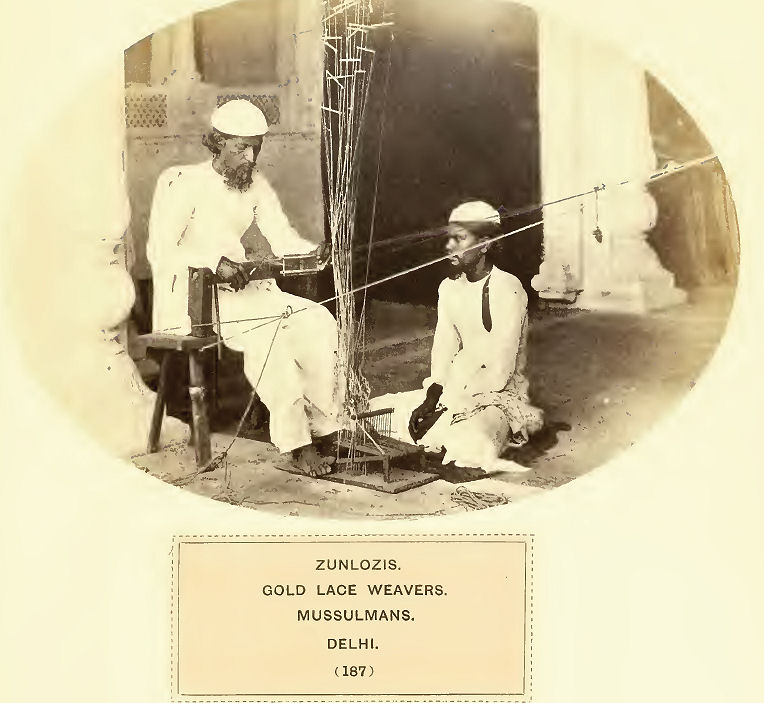
Abb.: Zunlozis. Gold lace weavers. Mussulmans. Delhi
(187)
ZUNLOZIS are not all Mahomedans ; but in the North-West Provinces they are so for the most part. The same trade is spread all over India, and is followed both by Hindoo and Mahomedan weavers. It is one peculiar to India, and is probably of great antiquity, extending far beyond the Mahomedan conquest, though it has most likely improved under the requirements of the gorgeous Mahomedan population of the country. The Photograph shows a man at work, with his assistant, who may be required occasionally, but who for the present is looking on. The workman is seated on a rude stool, which has a rest for his right hand. The treadles of his simple loom, worked by his feet, are seen below, and the cross pieces above are the heddles and strings which hold his materials for the pattern he is working, and which is effected by skilful manipulation. His simple loom can be set up anywhere—in his own house, or in a hall, or deserted mosque ; and very frequently in the latter, on account of its light and space. Thus are woven some of the most wonderful and beautiful fabrics in the world : tissues of gold and silver, plain and figured, with and without admixture of silk or cotton in flowers and patterns ; gold and silver tissue lace of all breadths and patterns, used for trimming scarves, and for bridal dresses ; larger scarves of muslin and tissue combined, as those of Benares; and that wonderful cloth of gold called kumkhab or kincob, which is without parallel in the ornamental manufactures of the world. All these are comparatively little known as yet in Europe ; but in the various International Exhibitions in England and France, specimens have been exhibited, which have excited alike wonder and admiration ; and in the Museum at the new India Office, in London, a collection of the choicest designs and fabrics from all parts of India, showing the varieties and requirements of the national taste, will always be accessible to those interested in its manufactures.
It may be possible that these manufactures of brocades and tissue laces, &c., have somewhat declied since the days of splendid Mahomedan courts, and, in particular, at Delhi ; and yet this is very doubtful. Gorgeous raiment is still, and will continue to be, a distinctive feature of the people of India of all ranks and classes who can afford it, whether Hindoo or Mahomedan. The poorest marriage trousseau is not without tissue of some kind as trimming to wedding garments, and the richer classes indulge in it to the utmost of their means. In Mahomedan families of rank it is in daily use, and it is the province of the mogulanee, or female milliner of the household, to remove the laces and tissues of scarves which "have to go to the wash," and sew them upon fresh ones. Sahoukars and Mahajuns, or bankers, make great use of brocade and tissue scarves, shawls, and turbans, and the same may be said of Zemindars, or landed proprietors of all ranks and classes, and soldiers, especially those in the service of native princes. The chief localities of production in India, and those in which the manufacture has been most perfected, are Benares, Moorshidabad, and Delhi, in the north, Boorhanpoor and Aurungabad in the Deccan, and Arcot and Mysore in the south ; but above all those of Benares are the most beautiful, though those of Boorhanpoor and Aurungabad are the most substantial.
The great beauty of these superb fabrics is owing, as well to the skill in weaving them, which is well nigh incomprehensible, as to the gold and silver thread which is woven into them in combination with silk or cotton as a basis. The gold thread is made from a bar of the purest silver richly gilt, then beaten out until it can be drawn into wire, which is flattened by being drawn, in its finest state hardly thicker than a hair, over a steel anvil, where it is struck sharply as it passes by a polished steel hammer, and wound on a reel. The delicacy and certainty of this operation is hardly to be described, but is certain and invariable. The wire is then either wound upon silk thread or used plain, as may be required, and the silver wire is used in the same manner. The practice of the craft among Mahomedans is not considered a low one by any means, and the occupation, in most instances, is hereditary. Women are not employed in it, except as winders of the silk and tissue thread, which, in the latter, to avoid knots and kinks, requires peculiar dexterity.
In the brocades of Lyons, the Irish poplins, and other rich European fabrics, gold and silver thread is frequently introduced; but its employment bears no comparison with Indian manufactures, either in the delicacy of the work or its durability. In Indian cloths the gold or silver never tarnishes, while in the others it is very liable to discolour, and is perishable ; and this is no doubt attributable to the absence of all alloy in the Indian thread.
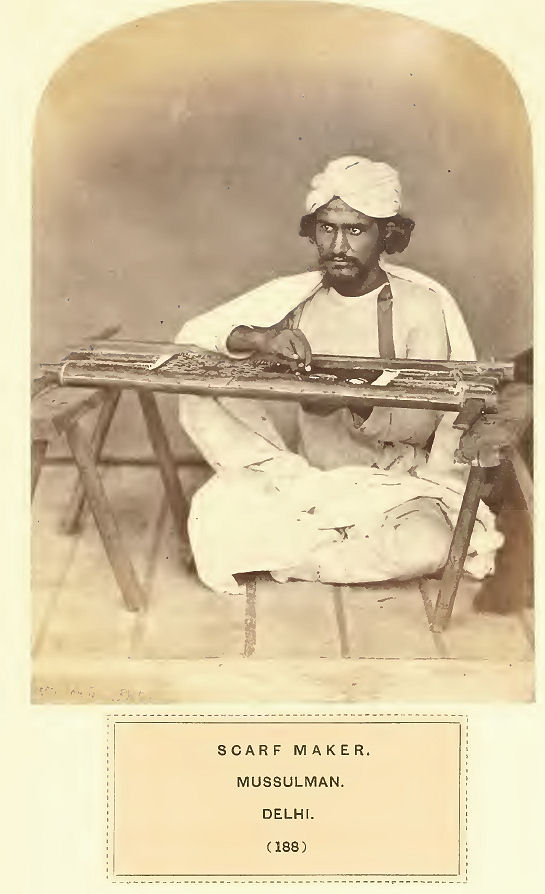
Abb.: Scarf maker. Mussulman. Delhi.
(188)
This occupation is not a caste, but a trade, and one of comparatively recent origin. It is followed chiefly by Mahomedans, though Hindoos occasionally practise it, and was originally introduced into Delhi and Lahore, where it is chiefly followed, by Cashmere mechanics, who have emigrated from their own country. Delhi scarves are famous, and there are few to whom they are not known. They are of Cashmere cloth, or of net, embroidered with silks of various colours, and in all imaginable designs. Some, as those of black cloth or net, embroidered in white or gold coloured floss silk, are perhaps the most chaste and beautiful ; while there are others, to suit all tastes, of coloured flowers and designs, which are hardly less remarkable. The process of embroidery is very simple, only requiring patience and skilful manipulation. The outline is traced carefully on the material to be embroidered, which is stretched upon a frame supported by trestles, as seen in the Photograph. The worker is seated on the ground beside it, and fills in the pattern with floss silk by means of wooden needles, like those used in the embroidery of Cashmere shawls. A very chaste effect is produced by using a shade of silk or braid of a somewhat darker tint than the ground ; and our readers will most likely be familiar with jackets, robes, waistcoats, and shawls, in which this method has been employed with great taste and effect. There is a considerable variety of this species of manufacture at present in the India Museum, and some of the specimens are strikingly elegant and beautiful. It is not a description of manufacture which is used in any great degree by the native population, even of the North-West Provinces, though an occasional embroidered vest or tunic may be seen in wear by the upper classes ; and in the central and southern portions of the peninsula it is quite unknown.
As the scarf makers belong to no particular caste, sect, or tribe, they present no particular features for remark.
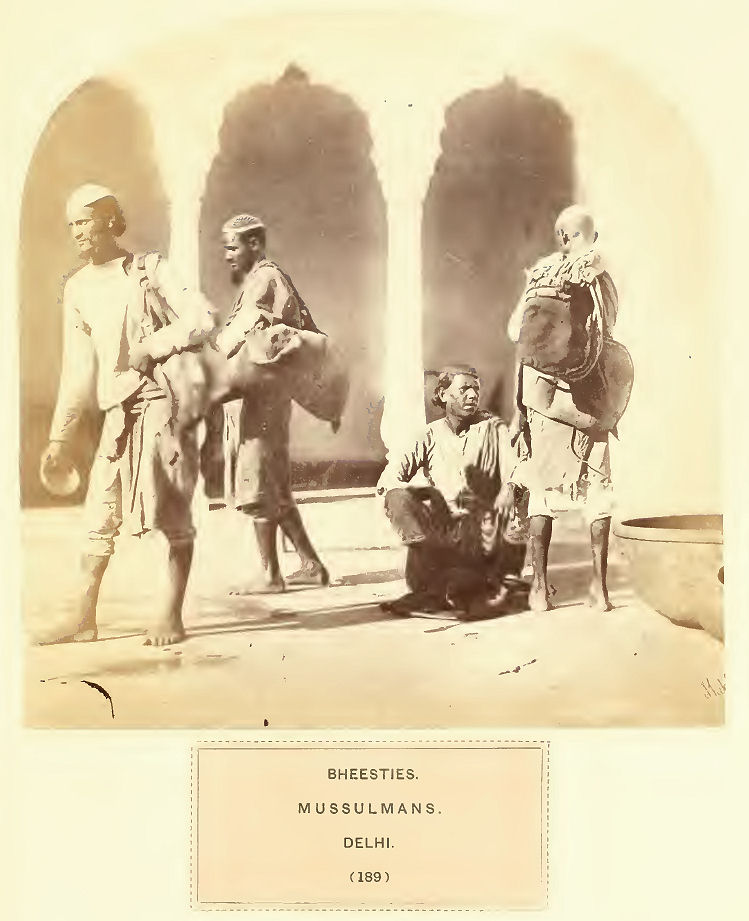
Abb.: Bheesies. Mussulmans. Delhi.
(189)
BHEESTIES are of two classes. That shown in the Photograph carries water in a skin bag, called a mussuk, on the hips. The other uses a bullock for the purpose, over whose back is suspended on each side a pair of much larger skin bags, called "pukkal." Men who carry water in skins are invariably Mahomedans ; but there are other water carriers who are Hindoos, and serve Hindoos only, who use large copper vessels, slung at either end of an elastic bamboo staff. Water carriers of these classes are found all over India. The Mahomedan Bheesties can hardly be said to form a caste or sect ; but they rarely, if ever, marry out of their own class, and a Bheestie's son is a Bheestie, for the most part, as his father was before him. For the mussuk, or hand bag, the skin used is that of a goat or sheep. It is carefully tanned whole, and closed in a peculiar manner, the neck or one of the legs being left as an aperture to let out the water. The larger bags are made of buffalo or bullock hide, and are much stronger. If of sheep skin, they are pieced very strongly and ingeniously. In both cases they are carefully prepared for use by a mixture of lime, sweet oil, sour curds, and turmeric, which removes all taint of the tanning process. These skin bags, and a small leathern bucket for filling them, forms the equipment of the Bheestie.
A Bheestie or Pukkalli is a domestic servant in every Mahomedan household in India which can afford to keep one. In wealthy families several may be kept, and in English families, regimental messes, and the like, the same custom prevails. Where a special servant cannot be afforded, Bheesties deliver as many potsful or skinsful as may be needed during the day, and are paid in proportion. They also serve in the regular army, both in the infantry and the cavalry, &c. In the infantry one or two are attached to every company, European and native, as it has also its barber and washerman. They accompany the regiment on its march, filling their bags from running streams or cool wells as fast as they are emptied by the thirsty soldiers. They also go into action with their corps, supplying water under the hottest fire. Many a wounded or dying soldier has been relieved in his agony of thirst by these gallant fellows, and their devotion and singular coolness under fire has often been very conspicuous. In cavalry regiments a Pukkal Bheestie or Pukkalli, as he is termed, is also on the establishment of every troop, in the proportion of one to twenty-five or thirty horses. It is his business to water them both in stables and after a march, and, no matter how long it may have been, the water is soon brought. The Pukkalli is very fond of his bullock, and takes great care of it. It is generally adorned with bells on its knees, and round its neck, which make a pleasant clashing sound. Its horns have gay tassels, and the leather work of the "pukkal" is ornamented with cowrie shells and brass very handsomely. For the support of the bullock the Pukkalli is allowed a handful out of each horse's daily grain, which forms in itself a handsome perquisite, and with this, and small payments from the families of soldiers, all military Bheesties are in very comfortable circumstances. They are considered fighting men, and receive pensions for wounds and for service.
In the hot weather, city Bheesties, who are not private servants, carry water about for sale, which, for a drink, is served in a bright brass cup, as shown in the Photograph. They supply the purest drinking water to be had, as well as ordinary water for cattle, for household use, and for watering court-yards, or the streets before houses, gardens, and the like, and thus earn very good wages. Indeed, there is never want of work for the class ; and, owing to the seclusion of females, the distance at which water may be procurable, and other causes, there is scarcely a family which does not pay more or less for this necessary of life.
In the North-West Provinces Bheesties consort greatly with Hindoos, they have even Hindoo names, and some castes do not scruple to take water from their skins ; thus they are sometimes supposed to be partly Hindoos in caste or belief. This, however, is not the case. They are exclusively Mahomedans, and observe the rules and practice of that faith as far as their knowledge of it goes, which is not very great. As a class they are entirely illiterate, and are not likely to improve in this respect. They are not remarkable for any particular costume ; but they affect in general a smart jaunty skull cap rather than a turban, and wear a strong red cloth round their loins, covered by a piece of leather at the back to keep out the wet. Their women, who are not secluded, are frequently as hard working as their husbands, carrying water into zenanas, and other household regions where men cannot enter, and taking charge of the mussuk, or the bullock, as occasion needs ; but it is only a strong woman who can carry a bag, except for a short distance, and women are therefore more frequently seen with bullocks. As the men are trained from youth to carry the skin, they are usually a fine stout race, capable of great endurance, and frequently very good looking. Though their occupation is a hard one they frequently attain a great age, and are a healthy class in general. In character they are simple, cheerful, and good natured, taking great pride in their established good character ; crime or offence of any kind is very rare among them. They are seldom seen in village communities, except when they are large, or contain a great proportion of Mahomedans. In others, women are less secluded, and water is more abundant and accessible, so that the service of a Bheestie is not needed ; nor are they in any form attached to purely agricultural people or their pursuits. Bheesties, in fact, are the faithful and untiring servants of the great masses of the people throughout India, and, as such, are perhaps of all, the most indispensable and industrious.
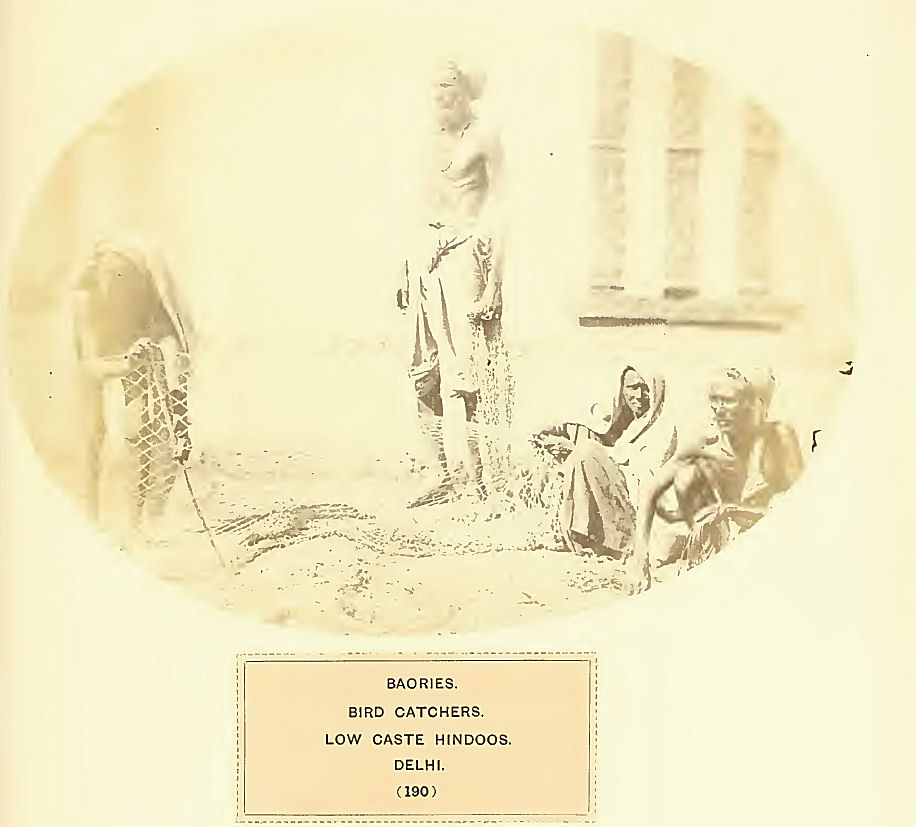
Abb.: Baories. Bird catchers. Low caste Hindoos. Delhi.
(190)
This is a very low race, and scarcely a caste among Hindoos, by whom the members are considered Chandalas, Mlechas, or outcasts. They are of the same rank as Khunjurs, Bayees, and others of similar habits; no doubt remnants of aboriginal tribes who have never been entirely converted, either by Hindoos (Aryans) or Mahomedans. As a rule they worship Devi, or Bhowani ; but it is a propitiatory worship only, and includes demons, ghosts, and evil sprites, of whom Baories live in abject fear. They also worship snakes at particular periods, and leave food for them near their holes. By profession they are snarers of game, and are very expert at it. The figure in the Photograph has just set up his net for hares ; and in fields or uncultivated places he would fasten one end of a long net to a bush while his wife would hold the other under cover, the middle being supported by sticks. He would then alone, or with companions, drive the game into the net, which, being but slightly supported, falls down upon and secures it. The sitting figure on the right hand holds a bundle of snares attached to wooden pegs, which are set to catch partridges or quail ; they are very neatly made of catgut, or finely twisted hair for birds, and of a stronger character for deer. It is almost impossible for a bird or animal to escape them. The Baorie is a capital imitator of the calls of all kinds of birds, especially partridges and quail. He can imitate them calling their hens, or challenging to fight, and is master also of hen language in its turn. Having carefully spread his nooses in a secluded place, he gets into a bush, or sits behind a screen of leaves, and begins to crow or chuckle, which attracts the game, and he soon makes his bag ; or, failing this accomplishment in his own person, he trains decoy partridges, which will follow him like dogs, and which are more certain of success than his own voice. It is curious to observe how one of these trained birds will lure on others to destruction, and apparently enter into the sport with his master. Quail are not susceptible of such training ; they are kept in cages, which are placed near the nooses and covered with grass or leafy twigs ; but quail are, if possible, more pugnacious than partridges, and the Baorie sells them to Mahomedan gentlemen, who train them for fighting. The same kind of nooses, or snares, are used for bustard, cranes, and other large birds. The Baorie watches where they feed and is prepared for them. For all live game he finds a ready market among Mahomedans ; dead birds, or hares, &c., he eats himself, and, like the Khunjurs, has no objection to iguanas, or foxes, while he is suspected, or more than suspected, of taking flesh from a dead cow or bullock when he can find one.
As a class the Baories are very poor, and though they occasionally get a good deal of money, they spend it in drink, or in feasts to their caste fellows, which are sad orgies of gluttony and drunkenness. The Baories are migratory, like all similar classes in India, and belong to no settled community. They come chiefly from Marwar; but are found all over the North-West Provinces and Rajpootana, in small companies, living in wretched blanket tents at all seasons, or in rude huts of leaves and grass, which they abandon when they leave the neighbourhood, a measure usually determined by the abundance or absence of game. They are generally possessed of a few asses, which carry their household goods, and a goat or two, or a cow or buffalo, for milk. They employ themselves sometimes as fishermen; but it is as snarers of game and sportsmen that they are most successful. They are also watchers and trackers of tigers, and do good service in this respect to English sportsmen, for whom they obtain the best information.
Very little is known of the customs of this caste in social matters. They do not employ Brahmins at marriages, and these ceremonies are managed at assemblies of caste fellows, which are concluded by a feast. They have no connection with other tribes of the same character, and, on the whole, have a better reputation than many ; inasmuch as they are not accused of habitual acts of theft, cheating, and pocket picking, or the graver crimes of Thuggee, Dacoity, or poisoning. As yet they are utterly unreclaimed, and wander where they will, as they have done from the earliest ages ; nor, does it appear that any attempt has been made to reclaim or settle them in any more reputable calling. Sooner or later the Government of India will perhaps put special means in action to attain this end ; at present, the number and condition of these semisavage tribes are a reproach upon its civilization.
The Baories have not unfrequently several wives ; for women are valuable, as well for domestic assistance, as in the pursuit of game, and the manufacture of the implements for the purpose; but they profess to limit themselves to one, except where there is no offspring. Owing to the exposure of their children, and improper food, a large proportion of the children die early. As to clothing, they have little till they grow up, beside that which nature has provided for them, and in bad and cold weather they suffer very severely. The costume of the women is the ordinary one of North-Western India—a petticoat, a bodice, and a scarf, small, of the coarsest material, and generally of coloured cloth ; and, like the men, they are meagre, and repulsive in feature, ragged, and dirty in their persons. They are believed to possess secrets for charms, and medicines; and sell herbs and roots, which they collect in the jungles. They also make up patchwork quilts with some ingenuity, from rags and old garments, for which they beg, or for which they exchange game or drugs; these quilts are used by some of the lower orders, and are said to be very durable. However poor they may be, or however miserable the place in which they live, the Baories have always a rude bedstead or "charpaee" to lie on, which can easily be carried across the back of the household ass or bullock as they wander, and forms a seat for children unable to walk, or a place for cocks and hens, which are tied on it by the legs. The Baories appear to be aware that lying on the bare ground would be impossible in all seasons of the year.
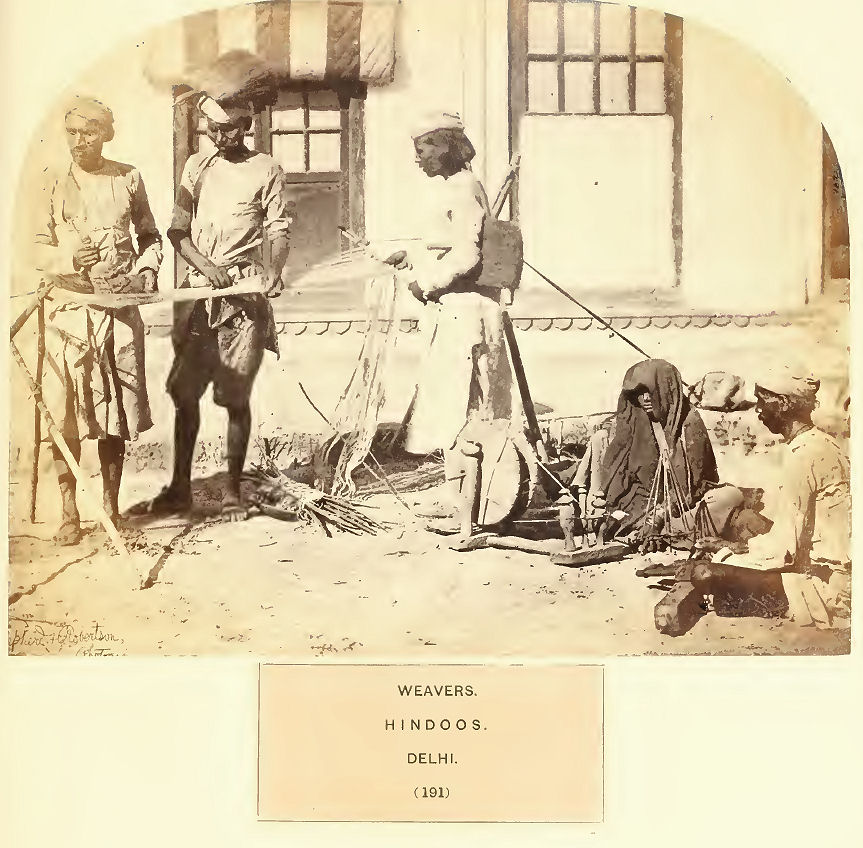
Abb.: Weavers. Hindoos. Delhi.
(191)
The Photograph exhibits a family of Hindoo weavers at work, and, perhaps, needs some explanation. They are preparing the warp, apparently of a turban or narrow scarf, for the loom ; and the operation is performed in the open air, in the court-yard of their house, or of a mosque or temple, or anywhere that they have space, and can obtain permission. The end of the yarn passes over a cross stick or trestle, and is being arranged evenly by the man in the tunic—the central figure—who has a brush under his arm ; the next figure is continuing the proper distribution of the thread, and his brush is on his head ; the third figure is brushing the thread, an operation which is very necessary, and requires a good deal of dexterity. The brushes used are made of cocoa-nut fibre, or the root of the khus grass, and are slightly charged with thin rice water for starch ; they are then moved backwards and forwards with long sweeps of the arm, as well to starch the thread slightly as to stretch and separate it, and remove all superfluous cotton down, or unevenness in the yam ; and this operation is performed several times, until the warp yam is fit for weaving. It will then be wound upon a roller, which fits into the foot of the loom, and the weaving process by the shuttle and action of the treadles begins. The woman seated near the centre figure is spinning with the common wheel of the country, which is rude in construction, but which is on the same principle as all other spinning wheels, that is, a catgut cord passes over the large wheel to a spindle, which it turns with proportionable velocity, and the thread, as fast as it is drawn out and spun, is reeled upon the small spindle at the end. The thread, or yarn, spun by this means is never very fine, but suffices for the lower order of manufactures, and spinning forms part of the daily work of almost all Hindoo and Mahomedan females of the lower classes throughout India. When women have finished their household duties, and the men are absent in the fields, or on ordinary occupations, groups of spinners may always be seen in every village, sitting on the ground, or on low stools, under the shade of a tree or a high wall, busily employed with their wheels and enjoying a comfortable gossip, while their children play about them. The wheel is worked by the hand only, the foot treadle being as yet unknown in India, and the quantity of yam produced is enormous, finding a ready sale with itinerant dealers, or at the village markets or fairs of the neighbourhood. English machine-made yarn is employed to a great extent ; but for many of the softer articles of ordinary wear, such as turbans, scarves, and waist cloths, the native yarn is still, and most likely always will be, preferred. It bears daily washing better, and never becomes stiff or harsh, as the more closely twisted machine yam is apt to do.
Weavers are of many classes, both Hindoo and Mahomedan. The Mahomedan weavers, who are termed "Momeen," or the "orthodox," or "faithful," produce plain muslins, such as turbans and scarves, or loongees, which are waist cloths worn by Mahomedans only, and coarse cloths called jote and khadi. They seldom weave coloured yarn, except for loongees and pieces of soussi, a useful class of fabric, of a somewhat coarse but very durable character, which is used by women for petticoats and trousers, and also for the covering of cotton mattresses, and other like purposes. Mahomedan work is rarely of a fine character ; but it is honest and durable, and the Momeens enjoy a good reputation for quality as regards durability of texture. For the most part they are very bigoted religionists of the Soonee sect, meeting in their mosques for morning and evening prayers, and observing all the requirements of dress, demeanour, shaving the "orthodox" portions of their hair, &c., and never wearing mustachios. They also observe the Rumzan fast, and other "orthodox" ceremonies, with great strictness, and are much more particular as a body in these respects than the Mahomedans of other classes. Many of them can read the Koran and the commentaries upon it, as well as other religious works, and some are fair Persian scholars ; but they are not affected, as yet, by any of our educational measures, and affect to despise them as heterodox. Their occupation is an hereditary one; and they state that they are the descendants of Arabian weavers, who accompanied the Mahomedan armies of invasion, which is not improbable. Many of them are very fair, of a decided western Mahomedan cast of feature, not unfrequently with grey or blue eyes; and their women, who are secluded, are reputed beautiful. They do not marry with other Mahomedan sects. By some they are looked upon as low in grade ; but they themselves arrogate a religious superiority, and they have always been extremely exclusive in their connections. On account of their bigotry, they are probably not a particularly well affected class to our Government ; but they are free from crime, and strictly decorous in their relations of life.
Hindoo weavers are very diversified in character, and in divisions of sect or caste. In the North-West of India they would appear to be of very low class, scarcely ranking above "Chumars," or leather-dressers, who are among the Chandals, or outcasts. The weavers are perhaps in a somewhat higher grade, but can hardly rank even as Soodras, or, if within that class, stand very low. They are termed Korreyas or Korees, and there are several divisions of them—Morwal, Bhomuneeya, Nigoorejal, &c. In the latter clan or division there once appeared a religions devotee or fukeer, who preached a doctrine of his own, made many converts, and died at Benares, where his tomb is still an object of reverence and pilgrimage. Korees eat meat and drink spirits, and are given to over indulgence in the latter. As a class they are not very reputable, but are not accused of habitual crimes or lawless conduct. They many in their own grade only, and are worshippers for the most part of Devi or Bhowani, with the addition of some demon worship, derived perhaps from their aboriginal condition. They always bury their dead. It is most probable they were partially converted to Hindooism by the Aryan invaders, and made slaves, as many other servile classes were, and from this condition they have never emerged. The figures in the Photograph are Korees or Korreyas; and it is not at all improbable that the word Koree is, in fact, Kolee, an aboriginal tribe reclaimed from their savage condition, some portions of which have become weavers, and are found practising that vocation in other parts of India. These Kolees, like the Korees, do not weave fine cloths; and in other respects their manner and condition of life have great similarity. On the other hand there are honourable classes of Hindoo weavers, much purer in caste, who are termed Joolaees, and are found all over India, which the Korees are not, but only in detached groups. The Joolaees are Sudras of good but not high grade. They rank perhaps next to Sudra Bunneas, and with dyers, and other artisans ; but some of them claim the rank of Vaisya, and are invested with the sacred cord. All these classes are weavers of fine goods, turbans, scarves, bodice pieces of silk, or cotton, or mixed fabrics ; saris, or womens' cloths, and dhotees, or mens' waist cloths. They do not weave khadi, or coarse calico, or soussi; that is the work of the Momeens, or lower castes of Hindoo weavers. They produce plain as well as coloured fabrics, and the manner in which they arrange their colours, and weave stripes and checks, with broad borders of figured silks, evince great practical knowledge of, and perfection in, their art.
To those interested in descriptions of Indian weaving, a work lately published by Dr. Forbes Watson, reporter upon Indian products to the Government of India, will afford much valuable and interesting information ; and an inspection of the fabrics of Indian weavers, from the very finest to the coarsest qualities, as arranged in the India Museum by Dr. Watson, cannot fail to gratify every eye, as well from the chaste and harmonious arrangement of colour as from the intrinsic worth and beauty of the fabrics. Many attempts at imitation of these fabrics for the Indian market have been made in England, and continue to be made ; but the work of the Indian weaver cannot be equalled, much less surpassed. It is more chaste and harmonious in colour, the texture is more durable and better suited to the climate, and the colours improve with wear and washing ; while those of the imitations fail sadly. The English imitation may be cheaper than the Indian original ; but the people know by experience that the original will, in the end, be the most economical. There is a fair rivalry, however, in progress, and room enough for the rivals for many a year to come.
In silk fabrics the Indian weavers, who are for the most Joolaees, fail in finish beside the weavers of Lyons or Spitalfields. Their colours are not so bright or delicate, nor is the work as fine or glossy; but it has one advantage over the European, inasmuch as the colours and texture, stand the test of ordinary washing, which the others do not. There are many kinds of body clothes worn by Hindoos which are of silk only : women's and children's saris, and men's pitamburs, or waist cloths. A Brahmin may not eat in a cotton waist cloth, except it be wet or damp ; but he may eat in a dry woollen or silk one. Woollen cloths, therefore, are used by the poorer classes, and silk by those who can afford it. In respect of these fabrics the Indian silk weavers have as yet no competitors or rivals.
There is no question of the very great antiquity of the art of weaving in India. Whether the Aryans brought it with them, as is most probable, or whether they found it existent among the aboriginal classes, some of which were, no doubt, rich and powerful, is a question which can never be decided ; but in the book of Menu there are many texts regarding it, the weaver, for instance, who has received ten "palas" of thread is not to increase the weight to more than eleven by rice water. In the Mahabharat, the most ancient epic poem of India, antecedent perhaps to Menu, and for which the Hindoos claim an immense antiquity, we find that, at the great tournament, or passage of aims, at Hastinapoor, the capital of the Aryan race, "all the chieftains of the royal house, and all the ladies of Hastinapoor, were arrayed in many coloured cloths, and garlands of flowers When all was ready, Drona, the preceptor, and Aswatthama entered the area in pure white garments ; the young princes also had garments of various colours."* And there are many passages of a like nature, with descriptions of flags and banners, in Mr. Wheeler's excellent abstract of the Mahabharat. These are all proofs that there were in those remote times, weavers and woven cloths in India ; and from the strictly hereditary character of the occupation, while the form of the garments and manner of wearing them has not changed, it is probable the colours and the fabrics are the same also, or but slightly varied.
* History of India. By J. Talboys Wheeler. P. 87.
The subject of weavers will, however, occur again in the course of these illustrations of the people of India, and will then be resumed.
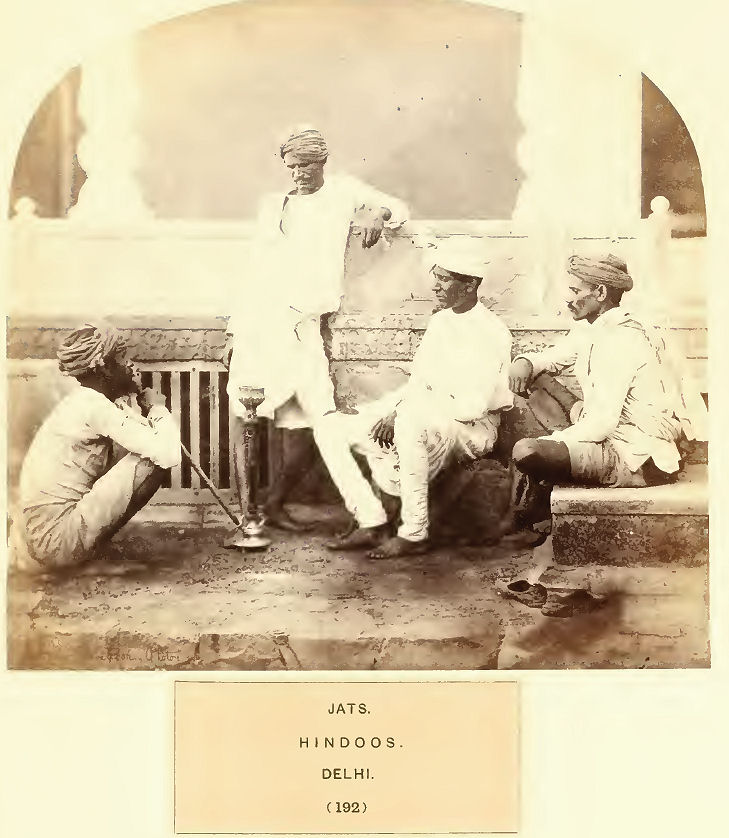
Abb.: Jats. Hindoos. Delhi.
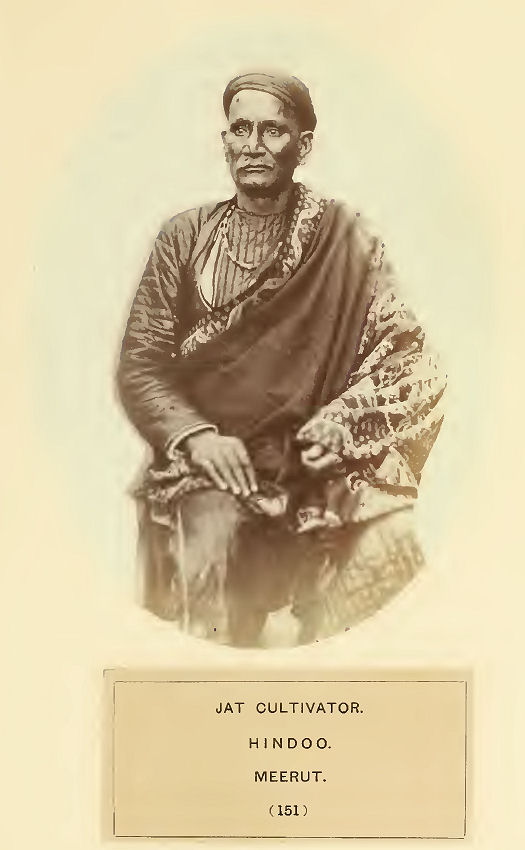
Abb.: 151. Jat cultivator. Hindoo. Meerut.
[a.a.O., Bd. 3]
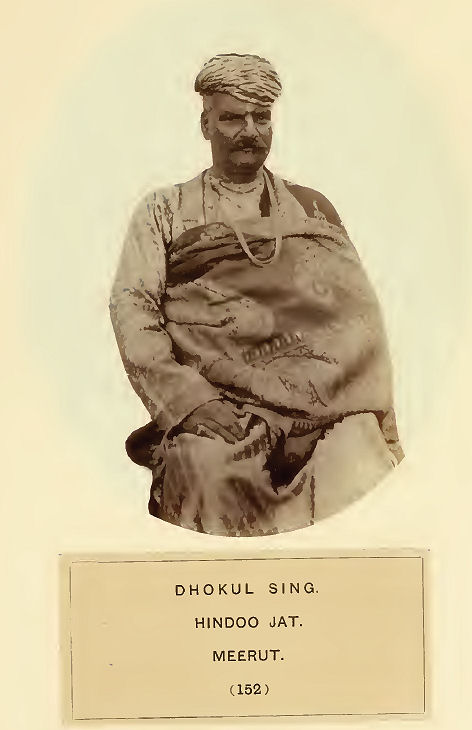
Abb.: 152. Dhokul Sing. Hindoo Jat. Meerut.
[a.a.O., Bd. 3]
(192)
In the course of previous illustrations, Jats have occurred in Nos. 151 and 152 (ante), but those were of superior members of the tribe, and the present Photograph is of a group of the lower orders, who, nevertheless, preserve the same characteristics of fine soldierly figures, and strong, but simple, features. In the North-West Provinces there are two grand divisions of Jats : one which has become Sikhs, and is very numerous ; the other, the original stock, to which the persons in the Photograph belong. The two divisions do not intermarry, except on rare occasions, and their social customs differ in many respects. The Jats, for instance, smoke tobacco ; to the Sikhs it is forbidden. Blue is the national colour of the Sikhs, which to a Hindoo Jat is unlucky. The Sikhs profess to have abjured Brahminism and idolatry, and are followers of the simple doctrine of Nanuk ; the Jats are still idolaters, and believe in Hindoo gods ; pay some, though not much, reverence to Brahmins, and worship the Ganges very particularly. They are, for the most part, votaries of Krishna ; but they follow the precepts of their spiritual directors, or gooroos, and their purohits, or family priests, in whatever religious rites they may be directed to perform. Among themselves they have no education, and have a general contempt for schooling of all kinds. There are few who can even read or write ; and to the Brahmins, Khuttris, Khayets, and other educated classes, are committed all their accounts, and other transactions of mercantile and household exigency. Not, indeed, that any of them are merchants, except as regards the sale of the produce of their farms. They hold all trading and dealing in money as merchants in much contempt ; and to call a Jat a "Bunnea" would be one of the greatest of insults.
All records of the Jats describe them as a fine, manly race of men, frank and true in all their relations of life and its engagements. They enter into the regular military service of our Government, and make good steady soldiers, both in the infantry and the cavalry. In the rebellion of the year 1857, the Jat population did not join in local excesses like the Goojurs, the Wattees, and other tribes; but were loyal, and decidedly on the side of order. The 14th Bengal cavalry is composed solely of Jats, and did excellent service throughout that eventful period, without the faintest suspicion of disloyalty ; and, if they had been needed, the tribe in general were ready to assist the British Government to the utmost of its power. Many attempts were made to overawe the Rajah and people of Bhurtpoor, and induce them to join the disaffected movement in progress ; but their allegiance and good faith were proof against all such proceedings, a circumstance which was of the highest importance in the local transactions of that critical period.
Jats are divided into clans, the most important of which are the following :—Poonya, Suisinwar, Nuwokeya, Shang-Mull, Dhaya, and Dallal. They are not restricted in marriage to their own clan, but prefer connections in it, if possible. They marry only one wife, for the most part ; but, in case of having no offspring, may, perhaps generally do, marry another. They can also take the wife of a deceased brother, if she has had no offspring, and raise up offspring to him. Jat widows are not restricted from a second marriage, but it is not of so honourable a degree as the first. Most of them, however, as a point of family honour, remain single. In regard to illegitimate children, there is no denial of rights among the Jats. They are received into the tribe, and entitled to shares of the family property, in proportion with others. They have no prejudices in regard to cooking and eating their food, as is the case with most other castes of Hindoos ; their fireplaces require no particular purification, nor do they object to eat out of their precincts, or to use food, as bread, &c., which has been put by. A Jat can take baked bread with him on a journey, for instance, with a little dressed pulse, chutnee, cold vegetables, &c., and eat where he can, or pleases to do so. In this respect their efficiency as soldiers is much enhanced. In all official reports they are described as the best agriculturists in Northern India. They plough and clean their fields efficiently; they understand the rotation of crops; and their agricultural implements, if rude in form, are efficient for all purposes. They understand the qualities of soils, the best methods of developing them, and the application of manures. In short, Jat agriculture possesses a completeness and thorough acquaintance with the local science of the pursuit, which forms a favourable contrast with that of other classes of local farmers. They are excellent cart drivers ; and men not wanted at home, or who possess carts and bullocks, hire themselves for journeys, or even for long periods between the rainy seasons, which they usually pass at home. They are the great earners of the cotton, madder, oilseeds, and other produce of Bundelkund, by which the railways and boats on the Ganges are supplied ; and, in return, they bring back salt or British manufactures. In all these transactions they are esteemed perfectly honest, and merchandize is intrusted to them to any extent of value. These cart carriers generally travel in companies, and their hardy drivers not only watch their cart camps at night, but are quite able to defend them against any attacks by robbers, even if any should be attempted. But the character of the Jats preserves them from molestation. They never become artisans in any capacity. Such pursuits are considered low and degrading, and the clannish pride of a Jat is great. In their own society they are frank and hospitable ; independent, but not rude or boorish in their demeanour. They drink spirituous liquors freely, but are not intemperate. They eat flesh of goats, sheep, and pigs, wild and tame; but not of cows or bullocks, and not habitually; their usual diet being millet or wheaten bread, with pulse and vegetables, milk, &c. Their women are strongly made, and capable of sustaining great fatigue. They are not secluded, except among the higher grades, and are faithful and modest, well made, but without positive beauty, except in rare cases and during youth. After middle age they become hard-featured and coarse. They are very assiduous in their domestic affairs, and keep their houses neatly, while they are cleanly in their persons. Neither men or women have any particular, or, as it may be termed, clannish costume. That of the men is shown in the Photograph ; and the women universally wear the ordinary petticoat, bodice, and scarf of Northern India.
The Jats consider they were a powerful race in former days. "Jatshaie ya Badshaie," is a common expression to denote that they were rivals to sovereignty ; but the history of the period in which they attained any amount of local standing does not show this distinctly. It has been sketched (ante No. 151) ; and before the period of Rajah Chooramun, that is, in the latter part of the reign of Aurungzeeb, they were little distinguished from the Goojurs, and other turbulent tribes of the North-West Provinces, who were with difficulty controlled by the effete Mahomedan Government of Delhi. During the troubled times which followed that Emperor's death, the Jats became more united in what may be termed a national resistance against the Mahomedans, and in the establishment of local independence; but beyond the principalities of Bhurtpoor, Gohud, and a few others of a minor character, they made no progress. They were too weak, in a numerical sense, to oppose or control the action of the Mahrattas, and suffered in contentions with them ; and though at times they were in alliance with them, it was never of a cordial character, and this was resented as opportunity occurred. When "the Abdallee," at the head of the Afghan nation, invaded India in 1759, the Jats, under their great leader and Rajah, Sooraj Mull, were in alliance with the Mahrattas, who had put forth their utmost power to oppose the Mahomedans, and to retrieve the disastrous defeats of Sindia and Holkar. Not only had the whole available armies of the Mahrattas been united, but the Rajpoot princes and the Jats had furnished large contingents. Sooraj Mull had joined them with a force of 30,000 men, chiefly his best cavalry ; but he did not approve of the constitution of the Mahratta army, with its large train of artillery and other field encumbrances, and urged the employment of the national and heretofore successful method of irregular warfare, as more effective against the enemy. But the Mahratta commander, Sudasheo Kao Bhow, who had taken up his position on the field of Paniput, was elated to the highest degree ; the counsel of the Jat leader was dismissed with contempt, if not, indeed, with positive insult ; and the day before the battle, which was fought on the 7th January, 1761, and ended in the total ruin of the vast Mahratta host, he departed from their camp, and returned to Bhurtpoor. Subsequent struggles with the Mahrattas occurred during the period when Sindia was consolidating his own power after separation from the general Mahratta confederacy ; but they did not affect the independent position which the Jats had secured, and which they have since maintained.
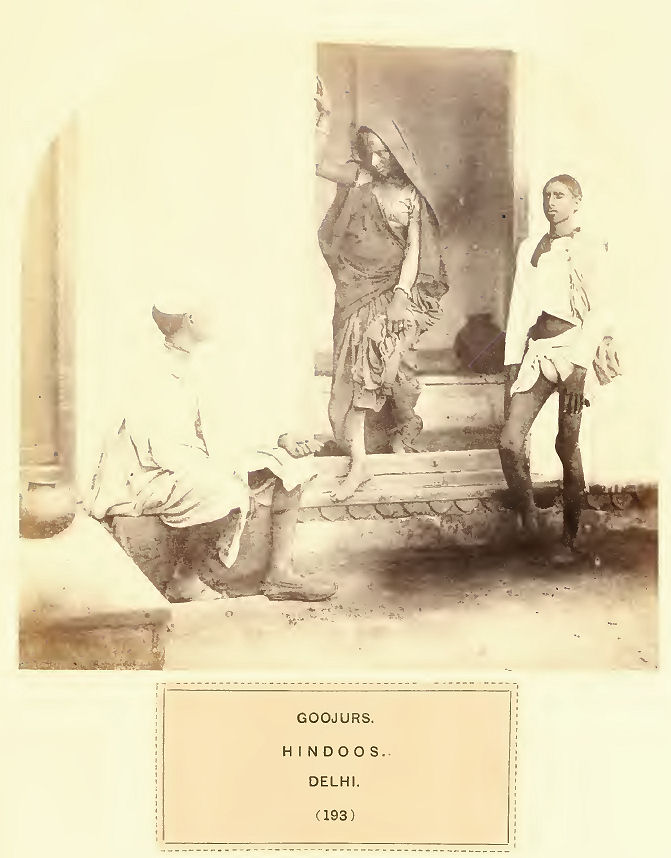
Abb.: Goojurs. Hindoos. Delhi
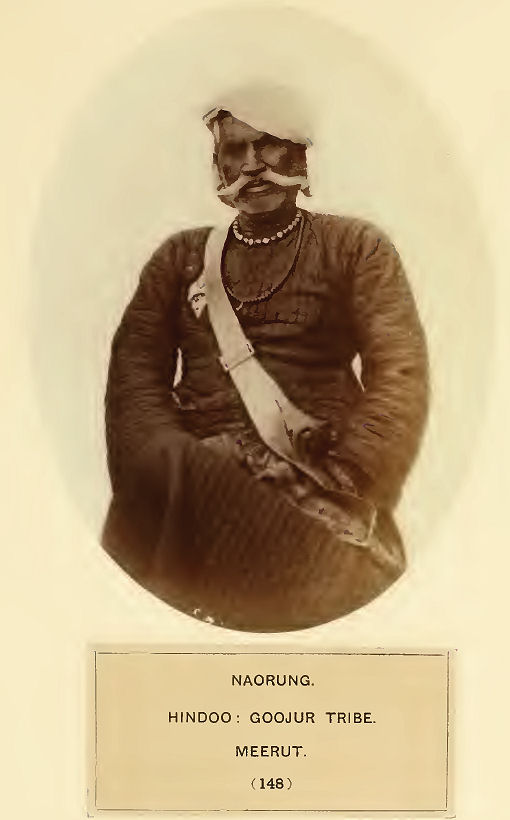
Abb.: 148. Naroung. Hindoo: Goojur tribe. Meerut.
[a.a.O., Bd. 3]
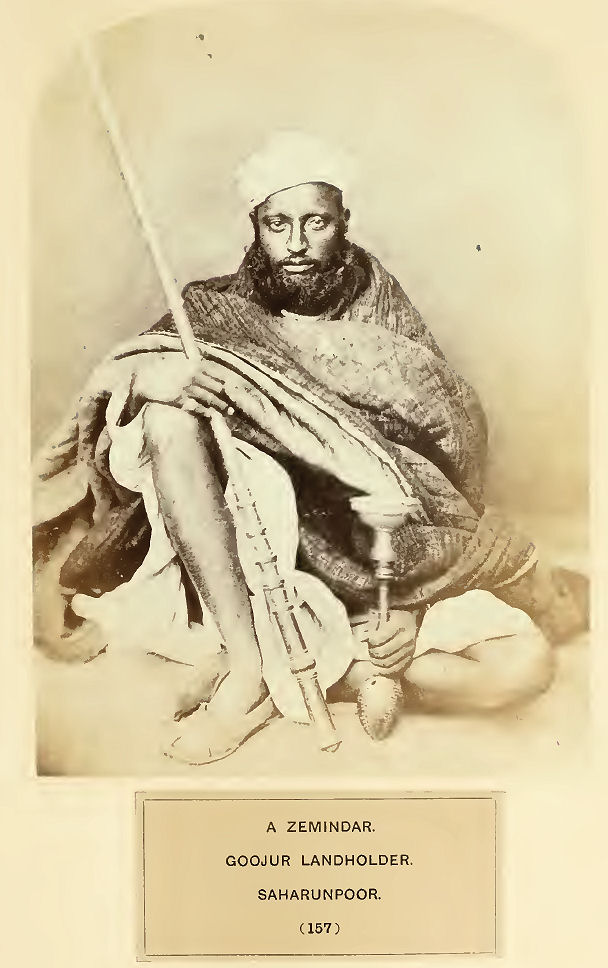
Abb.: 157. A Zemindar. Goojur landholder. Saharunpoor.
[a.a.O., Bd. 3]
(193)
In the Photographs Nos. 148 and 157, individuals of this tribe are represented. In the present instance two young men, and a woman who is evidently a widow, and perhaps their mother, form an appropriate group. Her head is shaved, she has no marriage token about her neck, and two plain silver rings or bangles have taken the place of the glass rings worn by married women and unmarried girls. There is little to remark upon in regard to their costume : the woman wears the petticoat, bodice, and scarf; and the young men the mirzaee or jacket, and the dhotee or waist cloth of ordinary Hindoos.
All local reports agree in giving the character of this tribe as described ante No. 148. They are dishonest, untrustworthy, and lawless in a high degree; and require constant and unremitting supervision. They are notorious and successful cattle lifters, pursuing this branch of robbery with determination and skill. Scouts are dispatched, who find out an unguarded locality at some distance, and in a neighbouring district. Men are stationed on the road to be taken on return, at certain distances ; and when the robbery has been effected, the cattle are driven along by night, the drivers being relieved by the several parties on the road. By these means as much as fifty miles will be covered in a night, and all traces of the cattle lost, by their immediate division among the members of the gang, and admixture with their own large herds. Goojurs take great pride in these lawless achievements, and this spirit is maintained by the elders of the tribe and by the women, who preserve traditions of past exploits ; and it will require much time for eradication. A common saying is applied to them. "Aheer (cowherd), Gurrerrya (shepherd), Goojur—yeh tinon chahen oojur :" "these three prefer the desert ;" that is, an open and waste country ; and is characteristic of their occupations. Cowherds and shepherds are not, however, habitually lawless classes ; but, indeed, much the contrary. The notorious conduct of the Goojurs about Meerut and Delhi, in 1857, has been before noticed. They suffered sharply for it, many of their worst leaders having been tried and hanged, or transported for life ; but it is questionable whether this has had any permanent effect upon the class in general, who would be ready to resort to plunder on any favourable occasion, and no local report details any satisfactory proofs of general amendment. Their agriculture does not improve in character, nor do they betake themselves to other occupations than those followed by their forefathers.
In many respects the Goojurs resemble the Jats. They are indeed a handsome tribe, and both men and women are remarkable for powerful figures and fair complexions. The women in particular are remarkably good looking, and have a bold free carriage and demeanour not usually seen among Hindoos born in Northern India, and are in these respects superior to the Jats. The two tribes can eat together, and use a common hookah, take water from each other, and the like ; but they do not intermarry. While the Jats are honest, frank, and trustworthy in all respects, the Goojurs are lawless, mulish, revengeful, and wrong-headed, professing no loyalty to any one. Thus, by the relative character of the tribe, one has reached the dignity of an independent state for the largest proportion of its members—which is a subject of never failing pride—while the other has remained in its original condition, distracted by small feuds, man against man, and village against village, thus preventing any cohesion for a common purpose.
In addition to their agricultural pursuits, the Goojurs are herdsmen like the Aheers, but not shepherds. They breed and rear cattle very successfully, supplying their districts with sheep and pack bullocks, and the cantonments and cities of the North West with animals for slaughter. They also make and sell ghee in large quantities, and these are perhaps their most successful pursuits. They are divided into several clans, Kasees, Nagrees, Bhuttees, &c., and in some districts they are very numerous. Shekawuttee, Goorgaon, and Buwanoo, near Hardwar, contain large proportions of them. In their social customs they differ very little from other Hindoo castes of the same rank ; they are Sudras, though they affect a higher station, on account of their presumed descent from Rajpoots. If they ever had, which is doubtful, any particular tribal customs, they have disappeared. They employ Brahmins for their religious ceremonies, that is marriage, naming of children, purification, and the like, and they burn their dead. Their widows are allowed to remarry, if they please, by the Danecha rite ; but this marriage, though it does not affect the legitimacy of children, is only of a second rank ; and women who have had children rarely if ever remarry. In this respect, as indeed in most others, they resemble the Jats and Aheers. Like the Jats they eat all flesh, except that of cows or bullocks, and are particularly fond of wild hog. They drink spirits also, and smoke tobacco and ganja, or hemp leaves, and their women use opium as well for themselves as their children. The Goojurs are by no means so thrifty or so rich as the Jats, which may be accounted for by their differences in character, nor are they by any means so industrious. They live in a poorer class of dwellings, and the clothes and ornaments of their women and children are of an inferior character, nor do they take employment like the Jats ; they probably cannot obtain it on account of their indifferent character. Some of them, however, have enlisted in the local Shekawattee corps, and do good service, but they do not enlist in general service regiments, and have an objection to go to any distance from their individual localities. Like the Jats they have had one celebrated religious teacher, Dya Ram, who is buried at Jungsalla, and his memory is still held in great reverence. As may be supposed, the Goojurs are entirely uneducated, and affect to despise learning as unmanly. Very few of them can write or read, and they do not avail themselves of local means of education.
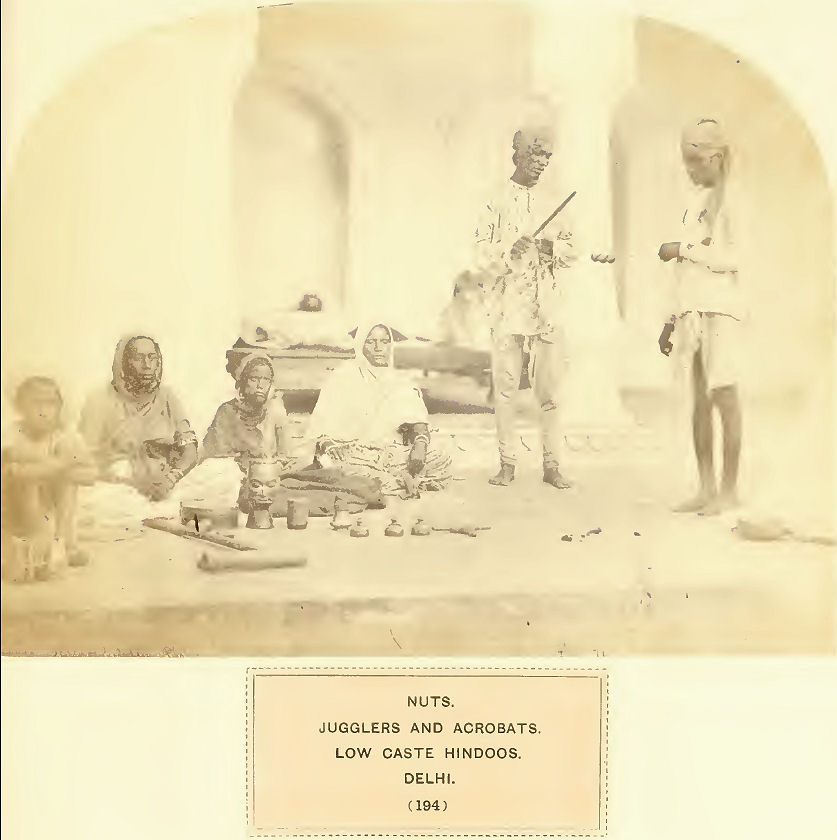
Abb.: Nuts. Jugglers and acrobats. Low caste Hindoos. Delhi.
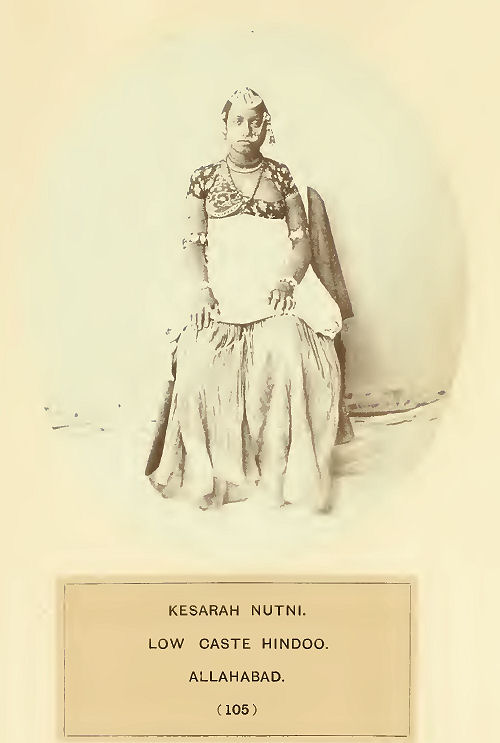
Abb.: 105. Kesarah Nutni. Low caste Hindoo. Allahabad.
[a.a.O., Bd. 2]
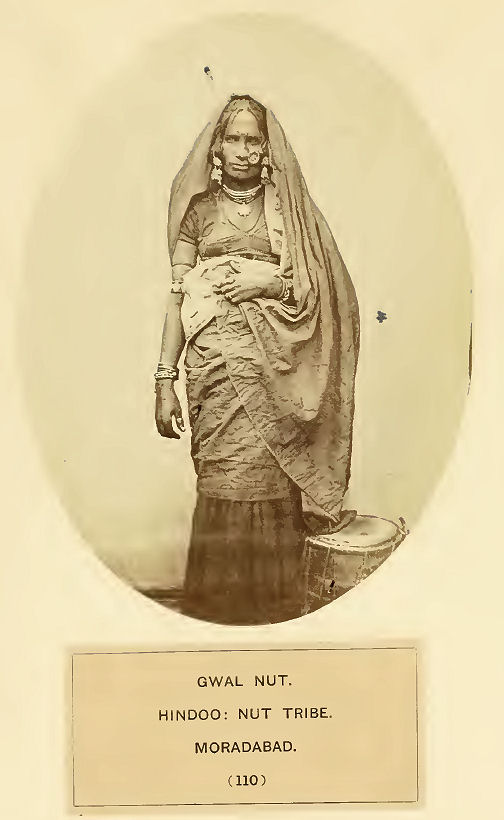
Abb.: 110. Gwal Nut. Hindoo: Nut tribe. Moradabad.
[a.a.O., Bd. 2]
(194)
In Vol. II., Nos. 105 and 110, two representations of females of the Nut or Nuth tribe have been given, and with them the character and occupation of the class have been described. The present Photograph has been selected because it shows a group of Nuts, in the act of performance of legerdemain tricks, in which they are very expert. The trick under performance is a clever and pretty one. The balls on the string are made to vary in number, and finally to disappear without any apparent process ; and the mode of operation is simple and unpretending, so as to disarm suspicion. On the ground are three cups, used very much on the thimble-rig principle. A white pebble or a wooden ball is employed instead of the pea. The performer takes up one cup after the other till he finds the ball. He tells it to stay where he has put it ; but the ball is erratic, and appears now in one, now in another, always the least likely of the three. No one appears to touch them, and the cups are on the bare ground. The earthen pot, with a human face, is made to speak, and a variety of tricks are done with it, and with the other simple articles lying before the group. The performance is always in the open air, in a village street, before its gate, or on the gravel walk of a garden. No attempt is made at assistance by screens or other properties, and its success depends upon the real dexterity and cleverness of the operators. Many of the tricks of Nuts have been introduced lately into English exhibitions ; but the Nuts' performance of the growth of mango trees, and the basket trick, are not as yet by any means equalled by their European fellow exhibitors.
The latter is made a very amusing performance ; and the scene being a village street, with a crowd of people around, the performer, after telling absurd stories about his sword and his own prowess, which provoke laughter, seizes an urchin who has laughed the loudest—most likely a confederate—holds him down, and places a large basket, which is lying by, upon him. The audience is thereby satisfied that the boy, who is howling under the basket, and making frantic efforts to push it away, is really there, and that there is nothing for the basket to rest upon but the earth. Now ensues a dialogue between the boy and the performer, who finally determines that he ought to put the boy to death for having insulted him. Then he brandishes his sword, and plunges it into the basket, jobbing it in all directions. Horrible screams are at first heard, which subside into groans, and these at last cease. The performer then shows his sword in triumph, apparently red with blood. "Ah !"' says he, wagging his head, "he's dead ; now, let's look at him." The basket is kicked away, but there is no boy, and the urchin is discovered laughing in the crowd. This is generally the last feat performed, and is rewarded by the pyce and cowries of the bystanders.
The Nuts are tight-rope dancers also, and some of their feats are extremely curious, displaying great strength. A man will tie the four legs of an ass together, and put his neck through them, allowing the beast to hang at his back. Upon the ass, and across his own shoulders, he will mount one of his daughters. At each end of his balancing pole are baskets, in one of which are two or three small children ; in the other, as many kids, or a goat, or dogs, to balance them. Thus equipped, he walks up one slope of the rope, settles himself firmly upon its forked supports, and proceeds across the centre, sometimes steadily, sometimes standing on one leg, then on the other, and again pretending to fall. In the centre the girl on the ass jumps up, stands on one leg, makes a salaam to the audience, and cries lustily for largess. The man then proceeds, and runs down the further slope, into the arms of the people who catch him.
Nut girls also perform many wonderful feats. One is, to climb a high bamboo pole, perhaps thirty feet high, which is fixed upright by stays. On the top of this the girl places a brass dish. She then lies out at full length on the dish, her face downwards, and her legs and arms stretched out. Suddenly she sets herself spinning round with great velocity, which is the chief feat of the exhibition, and is repeated several times.
But their most wonderful performance, which few can do, is by a man, and is called the frog trick. He borrows all the swords he can collect from the bystanders, usually as sharp as razors, and drawing each, places the whole irregularly on the ground, the edges being uppermost, and the swords held in their position by the hilts and the points being settled in the ground. When an area of perhaps twenty square yards has been covered, spaces being left between each sword, the performer leaps into the middle, rapidly performs some reverential postures to his tutelary divinity, then bends down till his hands and feet, outstretched, touch the ground. In this posture he leaps from place to place irregularly, barely, as it appears, avoiding the upturned edges of the swords ; and when he has covered every space, the play is over. It Is really, however, a very dangerous feat, nor will even good performers attempt it without demanding a large reward.
It is difficult to determine any probable origin for the Nuts. They are not, perhaps, pure aborigines, yet have a strong aboriginal element among them in demon and snake worship, and in peculiar and very secret ceremonies, to which they attribute their success as performers, and their protection in their dangerous feats. Such ceremonies are only performed in their own camps, and in desert places where no one can see them ; and they form the initiatory rites of young beginners, who necessarily preserve the secrets, whatever they may be, with perfect faithfulness. Sacrifices of animals and fowls take place on these occasions, nor is demon worship in any form unaccompanied by blood shedding. In Nut families the best looking girls are chosen for performers. These are not married, except to a dagger, and ordinarily become courtesans, being instructed in dancing and singing. In later life they become the concubines of men of the tribe, or contract second class marriages with them ; but some females are always set apart for regular marriage. They are not taught performances of any kind, and their duty to the tribe is to bear as many children as possible. Some of the Nut women are very handsome ; all, particularly the performers, are fond of gay clothes and ornaments, and Nut females are sometimes possessed of considerable wealth in jewels and gold. If a performing girl should bear a child, she is withdrawn at once from performance. Such a proof of her fertility is too valuable to be wasted.
Nuts belong to no settled community ; they wander as they will from town to town, or village to village, living in tents after a true gipsy fashion, or in tents made of reed screens, which are weatherproof, and can be removed at will, rolled up, and carried away. They use asses for carriage, with bullocks, and ponies, which are ridden by the women. Reasons have already been given why they have to be watched carefully by the police ; but of late years their feats in dacoity have been sharply suppressed, and it is probable that the crime is now rarely practised by them. At one period, however, before the department for the suppression of dacoity was established, the Nuts were among the most daring and notorious dacoits of India.
Although Nuts profess to be Hindoos, and, for the most part, bear Hindoo names, yet Mahomedan names are not unknown among them, and they are all votaries of some Mahomedan saints. Of these Shah Madar, of Mukkinpoor, in Bengal, is perhaps the greatest, but there are other shrines in various parts of India to which equal reverence is paid. Nuts also observe some Mahomedan ceremonies, but they do not practice circumcision. In marriages they do not employ Brahmins. Their ceremonies are performed in their own camps by elders of the tribe, who are held in great reverence. The Nuts eat meat, but not beef, and drink frequently to excess. Those who perform dangerous feats have to train themselves for them, both men and women, and their gymnastic exercises are very severe. During the period of training all intoxicating liquors are forbidden. There are many divisions of the Nut tribes : Inglas, Bamunwal, Naheewal, &c. ; and particular feats are, as it were, the hereditary property and occupation of each tribe, with which the others do not interfere. Parties of them accompanied the Mahomedan armies into the Deccan, and settled there ; and some of them had, and may still have, formal grants from Aurungzeeb of certain rights, of collections of grain, and other perquisites, from village communes of certain districts enumerated. Many of these famihes exist in the Deccan and Berar, chiefly in the Nizam's territories ; but proper Nuts are rarely found south of the Krishna. There they are met by other Tamul and Teloogoo performers, who are possessed of equal, and perhaps superior accomplishments.
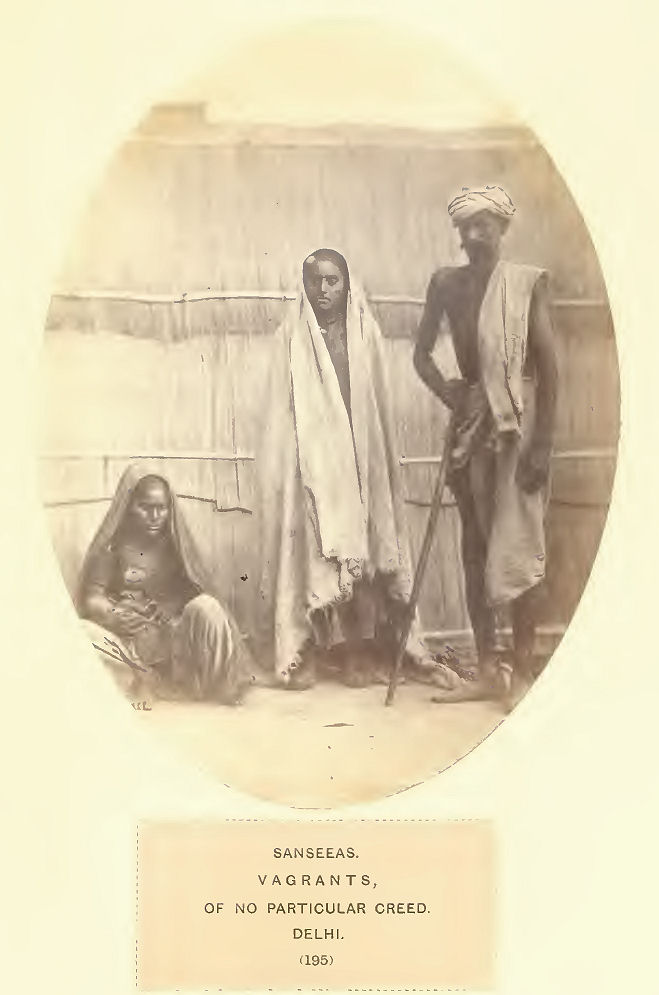
Abb.: Sanseeas. Vagrants, of no particular creed. Delhi.
(195)
The wandering tribes of India form a very remarkable feature of its population, and among them are found professors of normal hereditary crime in every possible shape, from the remorseless Thug and Dacoit to the cheats, pickpockets, and petty thieves who follow their calling in every bazaar or fair of the country. There may be criminals in other classes of respectable and settled habits ; the love of crime may tempt many to indulge in it ; acts of crime may be committed without much premeditation, from corruption by evil company, or from actual want ; but the crime ends with the person who commits it, it is not perpetuated by his class, nor does it descend to his children. The wandering classes of India, however, show a complete reversion of this ride. They have been vagrants from the earliest periods of Indian history. They may have accompanied Aryan immigrants or invaders, or they may have risen out of aboriginal tribes; but whatever their origin, they have not altered in any respect, and continue to prey upon its population as they have ever done, and will continue to do as long as they are in existence, unless they are forcibly restrained by our Government, and converted, as the Thugs have been, into useful members of society.
Among these tribes the Sanseeas occupy a place of pre-eminent notoriety. They are neither Hindoos nor Mahomedans in reality, but profess to be Hindoos, and do not practise circumcision, by which rite alone they could become Mahomedans. They are essentially outcasts, admitted to no other caste fellowship, ministered to by no priests, without any ostensible calling or profession, totally ignorant of everything but their hereditary crime, and with no settled place of residence whatever; they wander as they please over the land, assuming any disguise they may need, and for ever preying upon its people. When they are not engaged in acts of crime they are beggars, assuming various religious forms, or affecting the most abject poverty. Their women and children have the true whine of the professional mendicant as they frequent thronged bazaars, receiving charity, and stealing what they can. They sell mock baubles in some instances, but only as a cloak to other enterprises, and as a pretence of an honest calling. The men are clever at assuming disguises ; and being often intelligent and even polite in their demeanour, can become religious devotees, travelling merchants, or whatever they need to further their ends. They are perfectly unscrupulous, and very daring in their proceedings. As Thugs, many of the leaders of their gangs were the most destructive on record ; as Dacoits, they were the most merciless and the most desperate. They have not the slightest compunction in committing murder, but they do not commit it from motives of revenge, only in the exercise of their hereditary calling, by which they and their forefathers have supported themselves from time immemorial, and of which the legends live among them. Any one could become a Thug or Dacoit, and the societies had as many Mahomedans as Hindoo professors ; but to be a Sanseea Thug or Dacoit was impossible to any one but a Sanseea, and the mysteries of these callings have been thus preserved throughout generations.
The Sanseeas are not only Thugs and Dacoits, but kidnappers of children, and in particular of female children, who are readily sold, even at very tender ages, to be brought up as household slaves, or to be educated by professional classes for the purpose of prostitution. These crimes are the peculiar office of the women. Nor are they all. The kidnapping of children, when they have any ornaments on them—and it is almost an universal practice in India, for those who possess them, to load their children with gold and silver articles of jewellery—leads in most cases to their immediate murder. For this purpose the Sanseea women are said to carry about on their persons a thin cord, for the purpose of strangulation ; and the name of the tribe is stated to be derived from the Hindi words, Sans-lena, "to take away breath," which has been contracted into Sanseea. Members of the tribe, generally a few families in company, wander over the whole of Northern India, but are found also in the Deccan, sometimes by themselves, sometimes in association with Khunjurs, or a class of Dacoits called Mooltanes, who have perpetrated some of the most daring gang robberies on record. In travelling, the Sanseeas often assume the disguise of Hindoo pilgrims to celebrated shrines, carrying with them baskets containing pretended Ganges water, to sell to ignorant people, or on pretence of offering it at the shrine to which they assert they are proceeding. In the Deccan and Malwah they are known under the designation of Bhāts, or Bards, a profession to which they have no pretension, and under which the worst dacoities are committed.
The daring boldness with which such deeds used to be perpetrated, was worthy of a better cause. In one affair on record, and in which a banker in a military cantonment was robbed of a large amount of money, the gang, as transpired from the confession of its leader, afterwards apprehended, first reconnoitred the locality, then, under pretence of changing money, ascertained where the banker's money chest was kept. At the time appointed, a chosen band repaired to the appointed station just before the evening lamps were lighted, entered the house, and speared a man who resisted, securing the treasure ; while the military sentry in the bazaar near the guard house was also speared and killed on the spot, as he turned on his post in the direction of the house attacked. The gang was not disturbed, and got clear off with its booty, travelling rapidly to a place where ponies had been posted for them, and afterwards joining their camp, which was at a distance of forty miles. No one had seen the robbers come, no one had seen them go. They were never traced, and the perpetrators would never have been discovered, but for the confession of their leader.
On another occasion a few Sanseeas, with some others, attacked a rich banker's house at Gudduk, in the Deccan, speared him and his son in their house, and carried off booty to a large amount without alarm in the town. It was only by chance that a trace had been obtained of the actors in this tragedy, of the perpetrators of which no local clue existed, and in regard to whom the local police were utterly at fault. Most of the gang were apprehended, and it was proved that they had gone more than one hundred miles to commit the deed, from a foreign territory, in which they relied upon not being traced. It was no wonder these men were formidable. Foreigners themselves, vagrants, unknown and uncared for, they could arrange and carry out, with perfect success, expeditions such as these, without much chance of detection ; and, no doubt, for centuries past, they had exercised their vocation almost without check. In native states there was no pretence of police. The local authorities were venal, and very readily hushed by a fair proportion of spoil. If, here and there, crimes became unbearable, some one caught red-handed, had hands or feet lopped off, as a warning to others ; but such instances were rare. It required the perseverance and intelligence of English officers to get at the root of this hereditary evil, and to crash it out, and much has been effected. The most mischievous leaders of the Sanseeas, and other hereditarily criminal tribes, have been disposed of, and crime has been checked ; but the germ of it remains, and it would be taken up by classes like the Sanseeas upon any opportunity. The secret rites of the tribe are still practised, and its traditions, to them glorious, of by-gone affairs, survive among them ; opportunity is all that is required for the practice of their hereditary crimes, and if they have become impossible in British territory, who is to check it in native states, or follow classes like the Sanseeas wherever they wander? It is, perhaps, a difficult question for Government to deal with ; but it is not impossible that they might be collected and settled as a colony in some locality, instructed, as the Thugs have been, in useful and even profitable arts, and thus reclaimed from pursuits in which they have never known in regard to others, the same instincts of humanity which exist among themselves.
It would be a motive of curiosity alone that would follow the Sanseeas into their secret rites and social customs. The rites are propitiatory, being sacrifices to Devi or Bhowani, on the blessing of the spear heads, for the dacoity, or the torches which are to light the gang to its work. Strict observance of omens, lucky or unlucky, and under some disguise perhaps, a feast to Brahmins, or caste-fellows, if much plunder has been secured, constitutes their religion, if such it may be called ; yet which is practised with faith in the means employed, not for any motive of veneration, but to insure entire success.
Sanseeas have as many wives or concubines as they can support. With the first is a caste marriage, with the rest but scant ceremony. Some of their women are good looking, but with all classes, women and men, exists an appearance of suspicion in their features, which is repulsive. Sanseeas bury their dead, and wear the lock of haai on their heads common to most Hindoos. They never wear beards but for purposes of disguise. They are, as a class, in a condition of miserable poverty, living from hand to mouth, idle, disreputable, restless, without any settled homes, and, for the most part, without even habitations.
They have no distinct language of their own, but speak a dialect of Rajpootana, which is so disguised by slang, or Argot terms of their own, that it is unintelligible to other classes.
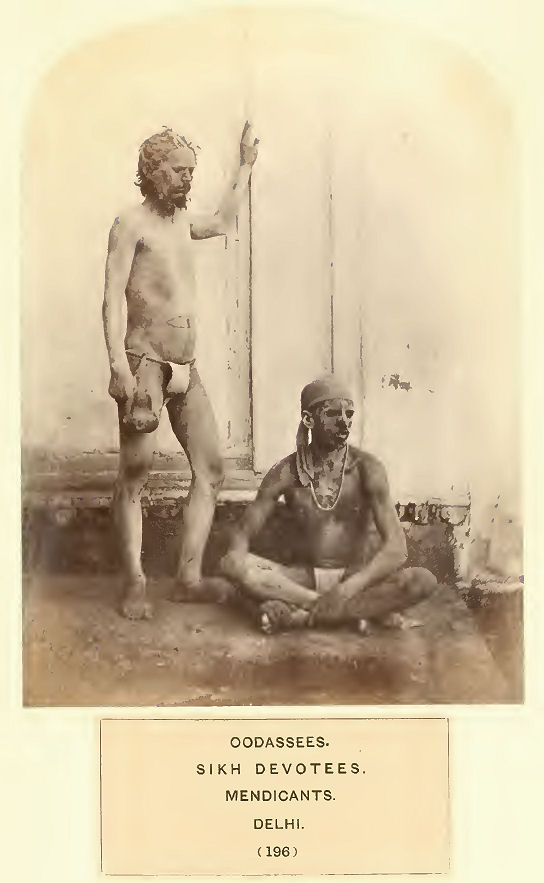
Oodassees. Sikh devotees. Mendicants. Delhi.
(196)
The word "oodas" signifies "unsettled," "melancholy," or "sad," and has been adopted by these devotees to distinguish their class or sect. What the Bairagees are to the Hindoo classes, the Oodassees are to the Sikhs. They are followers of Nanuk, the great Sikh teacher and founder of the national Sikh faith, and observe his doctrines and precepts. In many respects their profession is of a more austere character than that of the Bairagees, inasmuch as they wear no clothes, but only a rag, which barely serves the purposes of decency ; and they are not unfrequently seen in a state of absolute nudity, when perhaps they are most reverenced. They profess to own no property whatever, not even brass cooking or drinking vessels, and a cup made of a gourd is all they usually carry, trusting to charitable people either for cooked food, or for the means of cooking the flour, meal, &c., which is given to them. They have no prejudices as to food, and will eat anything that is cooked by Sikh or Hindoo families, except meat, which they have abjured. They do not smoke tobacco, but have no objection to opium. In some instances they shave the head ; but, for the most part wear their own hair tied up in a knot on the crown of the head, and it is always matted and uncombed. Their total absence of clothing is, in some degree, compensated by wood ashes, which they smear over their bodies from head to foot, and are preserved by them from the effects of heat in summer and cold in winter ; but the privations they undergo, from the ill effects of which they believe they are protected by the sacred nature of their calling, are almost beyond conception. In this respect they rival, if they do not exceed, the Hindoo Bairagees. Their profession is not hereditary, and is assumed by all classes of Sikhs in pursuance of vows, of disappointment in life, or religious fanaticism. When it is taken up, the Oodassee abjures all ties of kindred and worldly possessions, and betakes himself voluntarily to the course he must lead until death. He can make no claim upon his kinsfolk, for all bond of union has been severed between them. In the guise in which he is depicted in the Photograph he wanders where he will, without covering night or day, trusting to charity for his support, and fasting if alms are not given to him. Occasionally he is found singing or reciting the doctrines of Nanuk ; but very frequently a vow of silence has been voluntarily imposed, under which he does not even beg. So long, however, as Sikhs are to be met with he is in no fear of starvation, and the humblest food suffices for his wants.
Ooclassees visit Hindoo shrines as pilgrims, and follow Sikhs in their established localities. Thus they are found all over the Punjab and North-Western Provinces, and as far south as Hyderabad, in the Deccan ; where, as also at Nandair, on the Godavery, there are colonies of military Sikhs in the service of the Nizam's government. They are not numerous, however, being the offshoots of a single sect ; and are by no means to be compared, either as regards number or estimation, with the Bairagees, Jogies, and Goosains of orthodox Hindoo belief, whom they resemble. They can give no clear account of the original establishment of their sect, but allege that its first professors were told by Nanuk to go naked into the world, and preserve their purity, as a proof of their devotion to his doctrine, and as the means, by these austerities, of attaining eternal bliss. They allege that Nanuk himself was, in fact, an Oodassee; and they affect to despise the present condition of Sikh priests, and their luxuries, not only as contrary to the spirit of their order, but as leading them back into Brahminism, which, to a certain extent, is very true.
Oodasses, as Bairagees, Goosains, &c., do not return to the world. If the former cannot rejoin then families, and resume their old occupations, they can at least join mutts or monasteries, and partake of the worldly pursuits which are carried on therein. But Oodassees have no such institutions ; their life is one of unrest and privation, which never alters ; nor, once they have embraced it, are they ever seduced from their vows. As an order, the Oodassees live harmlessly and inoffensively among the people. They are not tainted by crime, nor have ever, like many wandering devotees, been suspected of the practice of it. They have usually the title of Bawa, or Father, and the "Oodassee Bawa" is often a welcome guest in Sikh or Hindoo villages or families, reciting his sacred texts, or telling to the wondering ears of listening matrons and children the marvellous scenes of large religious fairs and gatherings, of gorgeous Hindoo or Sikh ceremonies, and his own personal adventures. Runjeet Sing was, it is said, a great patron of Oodassees; and among the splendours of his court, it was not unusual to see members of the fraternity, stark naked, and covered with ashes, in company with courtiers and commanders, dressed in cloth of gold and Cashmere shawls. Sometimes one of the class might even receive a handsome shawl, as a tribute to his sanctity, which was thrown for a moment over the emaciated naked body, and given away as recklessly as it had been carelessly received.
Such are Oodassees ; thrown up, as it were, from, in many respects, the purest monotheistic faith in India; the only one which has had the effect of exciting patriotism, and creating a national spiritual dominion; a tribute, as it were, to the Hindooism from which it emerged, and of which it could not be entirely divested.
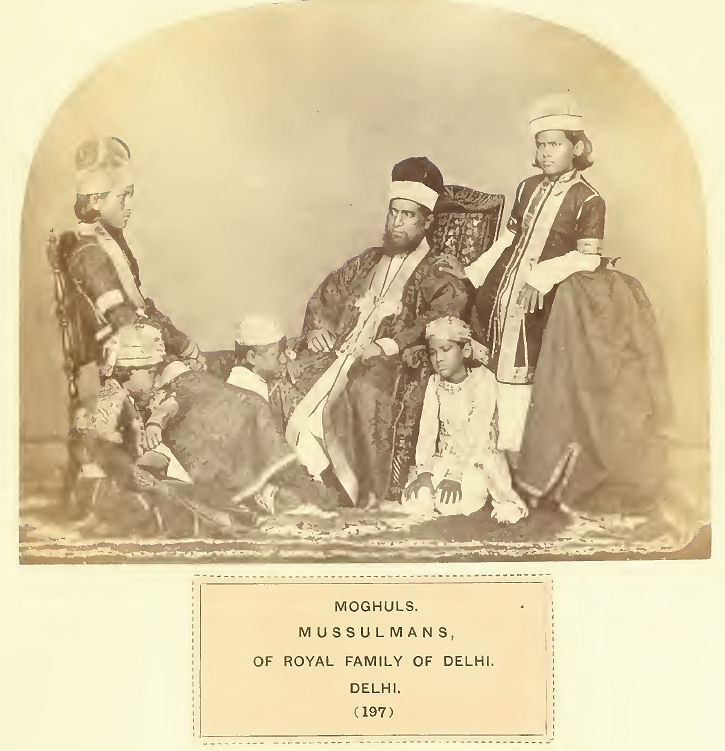
Abb.: Moghuls. Mussulmans, of Royal Family of Delhi
(197)
To none of the many Imperial dynasties of Delhi have belonged members so illustrious and remarkable, in many respects, as to that of the Moghuls. On the 17th December, 1398, Tamerlane, the great Tartar chieftain, who had rapidly overrun Northern India, and defeated the armies of the existing Imperial dynasty of Toghluk, was proclaimed in the city of Delhi as Emperor of India. On the last day of that month, having sacked the city, and glutted his hordes with plunder and the massacre of its inhabitants, he left it, never to return. Like his progress into India, his departure from it was marked by cruel, almost indiscriminate slaughter and pillage, and beyond the mere proclamation as emperor, he had no further connection with the empire, which remained without a government for many years. After Tamerlane or Teimour's death, the kingdom of Trans-Oxania fell to the share of his son, Meeran Hoossein; and after two successions, that kingdom was divided into three—Budukshan, Cabul, and Samarcand. In the year 1519, one hundred and twenty years after the proclamation of Teimour as emperor of India, his descendant, Baber, son of the king of Samarcand, taking advantage of the distracted condition of the existing dynasty of Lodi, invaded India with a large army, and took possession of the Punjab, which he claimed as a portion of the province of Cabul, belonging to his own kingdom. He was not at first successful in his designs ; but the prize was too great to be abandoned without further efforts, and, finally, on the 20th April, 1526, he defeated the Imperial army on the famous battle-field of Paniput, near Delhi, and was proclaimed emperor in the royal city on the 22nd of the same month. It was thought probable that, like his ancestor Teimour, Baber would content himself with the honorary title of emperor, and retire to his own proper dominions ; but he never left India. By a series of masterly combinations, he recovered province after province which had revolted from the dynasty he had supplanted ; and at his death, which occurred on the 24th December, 1530, he left to his son Hoomayoon the undisturbed possession of the most magnificent empire of Asia. Baber was the sixth in descent from Teimour; but the Moghul Imperial dynasty of Delhi can hardly be said to have commenced with the former, and it was from Baber that the succession continued without interruption to the last titular monarch, who reigned till 1857. Thus the dynasty had lasted three hundred and thirty years—considerably longer than any of its predecessors ; nor has there been any other Mahomedan dynasty of India to compare with it in this respect, or with the remarkable characters of many of its members.
Yet it had a nai#rrow escape of extinction in the person of Hoomayoon, the son and successor of Baber, who, after a series of misfortunes, left India as a fugitive in the year 1542, having reigned sixteen years. He did not return as a conqueror to Delhi till the year 1555, the intermediate period having been filled by an Afghan dynasty named Soor ; but after his second reign, the Moghul dynasty received no other check until its close.
To Hoomayoon succeeded Akbur, the most noble, as, indeed, the most enlightened of the family. He was placed on the throne on the 15th February, 1556, immediately after his father's death, when he was only thirteen years old ; and he reigned in great glory and power until his death, October 13, 1605—a period of fifty-one years and a few months. Under him the imperial power culminated to its greatest effective condition ; and the events of his reign display an enlightened policy, which, for the period, was as remarkable as it was benevolent. Before his reign the Hindoos had been treated as infidels and enemies by the bigoted Mahomedans. Akbur not only displayed sympathy for, and with them, but was the first to make use of them in public capacities as servants of the state. It is strange now to read of his abolition of suttee, and of the permission for the re-maniage of Hindoo widows ; measures only fully carried out in recent years by our Own Government. During his reign all landed property, whether public or private, was surveyed and assessed for the payment of revenue ; and its registration in all the wide-spread provinces of the empire was a work which excites wonder as well as admiration, and has been followed by a similar act on the part of the Government of India. In religion he was perfectly tolerant, and is not without suspicion of scepticism in regard to the Mahomedan faith, and an admiration of, if not an actual belief in, Christianity, with the doctrines and precepts of which he was perfectly acquainted. It was to this great monarch that the first British ambassador, Sir T. Roe, was accredited ; and from his account of the court, and that of Bernier, the French merchant and traveller, it is evident that the magnificence, the power, and the practical wisdom of Akbur were in no degree exaggerated. When it is considered, also, that, at his succession, the dynasty can hardly be said to have been securely established, that every department and element of administration had fallen into the last degree of disorder, and had to be created anew, it is the more wonderful, that, in a comparatively few years after he had attained his majority, the reforms, which emanated entirely from himself, were either securely established, or in sure progress. He was described by English gentlemen who were at his court, as "affable and majestical, merciful and severe ; skilful in mechanical arts, of sparing diet, and sleeping but three hours a-day." Such was the Emperor Akbur ; by far the noblest, as he was the most intelligent and glorious of his family.
To him succeeded his son Selim, who took the proud title of Jehangeer, or conqueror of the world ; and for twenty-two years the splendour of the empire continued undiminished. The conduct of Jehangeer was not, however, formed on the liberal foundation of his father ; and in some respects there were relapses into the customs of the old regime. Jehangeer was, however, a magnificent monarch, but not a statesman, and nothing of an original character marks the prosperous continuance of his reign. His court, however, was the resort of men of all creeds and races, and Jehangeer himself was believed to have had a stronger leaning to Christianity than even his father.
His successor, Shah Jehan, fully maintained, if he did not increase, the splendour of the empire and its unity. It is even probable that the magnificence of his court exceeded that of Jehangeer, as well as the vigour of his character. In most details of administration, the institutes of Akbur were still the guides of the executive officers, and the efficiency of their conduct nowhere appears doubtful. Although his expenditure in public works, in gorgeous expeditions to Cashmere, and in the maintenance of the court, was greater than that of even his father. Shah Jehan left in his treasmy twenty-four millions sterling, besides a vast treasure in jewels and precious metals—a fact which speaks well for the fiscal administration. During his reign the imperial troops had gamed many advantages over the independent kings of the Deccan ; and it was in the events of the next reign, that of Aurungzeeb, that the lamentable results of that policy became apparent. Shah Jehan reigned thirty years, and was deposed by his son Aurungzeeb in June, 1658. He lived some years afterwards, but had retired into strict privacy. The benefits of the reign of Shah Jehan have been little exaggerated by contemporary historians. The accounts of Tavernier, the diamond merchant, also, who travelled through the country, attest the good order, prosperity, and content that everywhere prevailed. The city of Delhi had been built anew, and the noble mausoleum at Agra completed. Six and a-half millions had been spent on the peacock throne, and great numbers of other public works, palaces, aqueducts, caravansaries, and the like, executed ; yet, as has been already mentioned, he left twenty-four millions sterling in cash in his treasury.
The events of the reign of Aurungzeeb were very chequered. After his brothers, who contested his succession, had been disposed of, and his reign had fairly begun, he was drawn gradually into the Deccan, as well to carry out his intention of subduing all the independent monarchies there, as to perfect his ambitious project of uniting all India under one government. This policy eventually proved the real cause of the destruction of the Mahomedan empire. As the local Mahomedan strength after each kingdom had fallen, was, in fact, reduced, the Mahrattas, hitherto unknown, rose under their celebrated chieftain, Sivajee, and gradually gained power, while they weakened that of the empire; and Aurungzeeb's last military campaign ended in a retreat before rebels, whom a comparatively few years before had been utterly despised by the proud imperial soldiery. Before his death, and for several years, symptoms of a general decay of imperial power had set in. They were hastened by the policy of the emperor ; and at the time of his death, in 1617, the elements of disorder and general disorganization had gained a strength and consistency which could not be repressed. Aurungzeeb was a bigot of the real narrow-minded Mahomedan type. He persecuted all Hindoos, made many forcible conversions, set a tax upon them, and denied them public employment. This, and his insatiate ambition in the destruction of the Mahomedan kingdoms of the Deccan, are the two salient points which influenced his ruin of the empire. Aurungzeeb succeeded in uniting, during the last few years of his life, the whole of India under one government, but only in a nominal degree. The ill-founded edifice was ready to crumble to pieces ; and as the emperor's life closed, after fifty years of reign, and eighty-nine of age, the whole collapsed, and became a struggling mass of conflict and scramble for power, in which the locally strongest got the greatest shares. In this struggle, viceroys became kings, feudatories of the empire independent princes ; above all, the Mahrattas, in power and numbers unknown before, began to ravage and to desolate the empire, and to levy tribute and plunder in every province without molestation.
Bahadar Shah, Jehandar Shah, and Ferokh Shere followed in succession to Aurungzeeb ; and their reigns are but records of increasing distress and irredeemable confusion. To the last, in September, 1719, succeeded Mahomed Shah, during whose reign India was invaded by Nadir Shah, and the events of the visit of Tamerlane repeated at Delhi. The imperial treasures were carried off, and the people of the city ruthlessly plundered and massacred. In April, 1748, Mahomed Shah died. He was the last emperor who preserved any semblance of power, and what remained was dissipated very speedily after he had passed away. Ahmed Shah and Alamgir II. followed in turn; witnessing daily defections of their servants, and the ever growing power of the Mahrattas now thundering at the very gates of the capital. Oude, Bengal, the Deccan, and the Carnatic had been usurped by local Mahomedan governors, and were now independent kingdoms. Cabul, and all imperial provinces west of the Indus, had reverted to the local native chiefs. The Sikhs had driven the Mahomedans out of the Punjab ; the Mahrattas had possession of Central and Western India; and, in place of an empire which had stretched from Assam to Herat, and from the Himalayas to Cape Comorin, there remained only a few provinces near Delhi for the emperor's support. To complete the ruin, Delhi was again sacked by Ahmed Shah Abdallee in 1751, and the horrors of the outrages of Nadir Shah again repeated upon its miserable people. By this time, another power, destined to subdue all conflicting interests, and unite them under one bond of civilized influences, appeared in the English ; and the last memorable exercise of the imperial power was by the unfortunate Shah Allum, on the 12th August, 1765, when, seated on some dining tables, put together to form an extempore throne in Colonel Clive's tent at Buxar, he granted to the East India Company in perpetuity the Dewanny or fiscal government of the whole of Bengal.
It was not long after this, after a variety of vicissitudes of fortune, that the emperor fell into the hands of Gholam Khadir, a cruel monster, who put out his eyes ; and he was a prisoner in the hands of the Mahratta chieftain Sindia, when he was released by Lord Lake, who found, as recorded by the Governor-General, Lord Hastings, "the unfortunate and venerable emperor, oppressed by the accumulated calamities of old age, degraded authority, extreme poverty, and loss of sight, seated under a small tattered canopy, the remnant of his royal state, with every external appearance of the misery of his condition." The emperor was allowed to retain a small private estate near Delhi, and an ample provision in the form of a yearly pension was made for him.
In this condition the royal family continued to exist, increasing very rapidly ; each member claiming his or her share of the royal income, until its amount became seriously affected. The Photograph gives a representation of the style of these persons. They were, for the most part, vicious and dissolute, idle and ignorant ; too proud to seek employment, and too discontented to abstain from plots and intrigues, as futile as they were foolish. For many years the King of Delhi was recognised as the nominal head of Government in India. His name was upon the British, as all other coinage, and the British Governor-General styled himself his servant. On occasions of successions in the native states, the customary offerings were made to the king, who, in return, sent dresses of honour and letters of congratulation and confirmation ; while, to the last, the farce of pretending to seek distinction and titles from the king, was kept up by the rulers of states who had shaken off all allegiance to Delhi, and in the days of its great misfortunes had carefully avoided all connection with, or assistance to it. This, indeed, might have been considered a harmless exercise of royal privilege, which could not, under existing circumstances, be interfered with ; but, as it subsequently transpired, the palace of Delhi became the focus of all the deep-lying discontents of the Mahomedans of India, and when the native portion of the Bengal army broke out into actual mutiny, and, as far as possible, rallied round the king, there seemed to arise a well-founded hope of a renewal of actual sovereignty. But it existed for a very brief period only; and for the outrages committed under his personal knowledge, if not actual direction, the king, after his apprehension, was tried by a commission and found guilty. His life, for many reasons, was spared ; but he was sent into a dreary exile—perhaps worse than death—and he died at a very advanced age, at Tounghoo, an obscure town of British Burmah. So perished the long and noble dynasty of Tamerlane, which, during its existence of three hundred and thirty years, had ruled India with a splendour and vigour before unknown, and furnished a succession of monarchs, to whom may be justly accorded prominent places in the world's history.
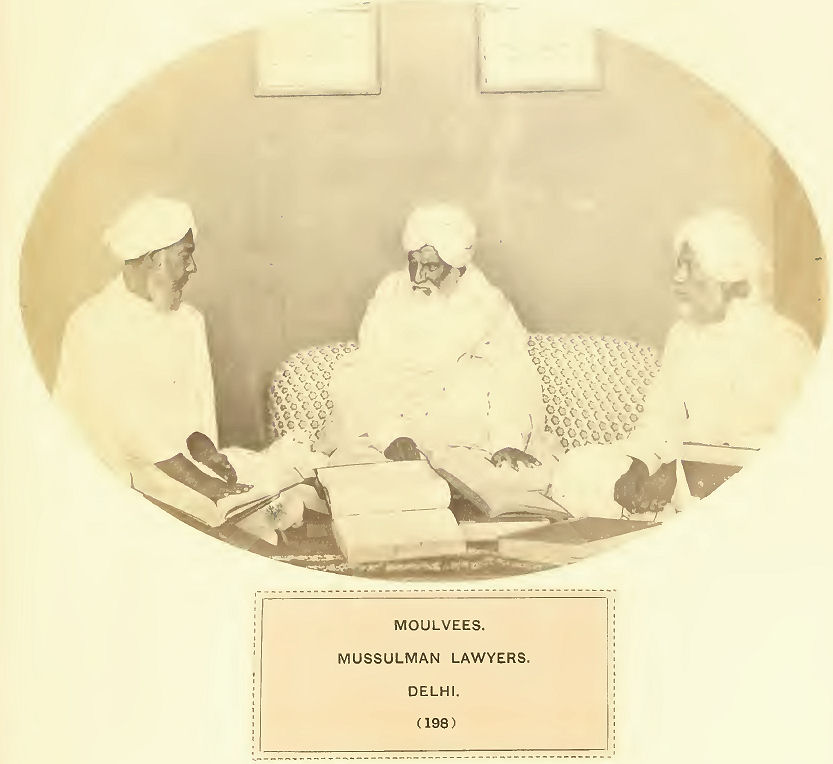
Abb.: Moulvees. Mussulman lawyers. Delhi.
(198)
The Photograph represents three doctors of Mahomedan law, or Moulvees, in discussion, perhaps on some knotty point in the text, on which the figure on the left has placed his hand, while the other two are listening to what he has to say. They form a very characteristic group of a class of learned men, who are perhaps decreasing under lack of patronage and exercise for their talents and knowledge, which is a necessary result of British Government. As a class they cannot be supposed to hold our administration in any particular regard or esteem, since they are necessarily deprived of the extensive advantages they would have possessed under their ancient Mahomedan rule. Under our own administration of the country, however, Mahomedan law still occupies a prominent place, and all property belonging to Mahomedans is inherited, divided, or litigated, under that law. Thus marriage settlements are drawn up by Moulvees, and the separate shares of widows, sons, and daughters, of all families of Mahomedans are defined by them. Wills are written by them, and conveyances and deeds of gift in special cases ; in short, the civil law business of the Mahomedan people of India is in their hands. English judges are supposed to be conversant with Mahomedan law ; but there are many points in which the general direction of a competent law officer is needful, and a Moulvee who has passed a prescribed examination is attached to every civil court. To him the judge can refer in doubtful or intricate questions ; but the Moulvee is not responsible for the result if the award does not coincide with his opinion. These situations are very honourable, and are well paid ; but they are necessarily limited in extent. The criminal Mahomedan law has been entirely expunged from English procedure in India. It was cruel, vindictive, and uncertain of application. It did not admit of the evidence of "unbelievers," that is, of Hindoos and Christians. The punishments laid down were excessive and capricious ; yet for many years after the commencement of the local administration of Bengal, &c., indeed, to a comparatively late period, the opinion of the Mahomedan law officer was recorded as to the nature or ground of the punishment to be inflicted, while the actual sentence was passed by the judge in reference to that opinion.
In the recent extension of employment of educated and qualified native gentlemen, the Moulvees, and other learned classes of Mahomedans, have been appointed to the judicial rank of Ameen, and Sudr Ameen, and to be judges of local courts of an inferior degree to those presided over by English judges. These also are very distinguished stations in life, and are well paid. The classes employed are honourable men ; very few instances of misconduct having occurred among them in ordinary times. During the mutiny and rebellion there were some sad instances of disloyalty, and the temptation of assisting a movement to recover national greatness was too strong to be resisted by all ; but, on the other hand, there were many noble instances of good faith and devotion, and, on the whole, there resulted no reason for the future avoidance of this class of Government employees, but much the contrary—which is in progress of fulfilment. These learned classes of Mahomedans have never been independent, even during the existence of Mahomedan power. There was never what might be called a "bar," in which advocates could rise to any distinction or wealth ; and though litigants might have their "vakeels," they were little better than mere agents. In the British provinces, however, there is what may be termed a "bar," which is rising from year to year in public estimation, and the members of it are Mahomedan as well as Hindoo lawyers. There is not as yet any well-defined distinction between attorneys and pleaders ; but this is in progress, and will no doubt be decided in time, perhaps, by an act of legislature. In the ordinary civil duties of Government, there are many offices open to Mahomedan gentlemen of education. The police, for instance, employs men of a semi-military character, and the collection of the revenue has many valuable and important situations—as tehsildar, or collector of a sub-district ; assistant collector, &c.—offices of high trust and responsibility. In non-regulation districts, Mahomedan gentlemen are advanced to the rank of assistant commissioners, and fill other subordinate offices with great efficiency, and advantage to the State. It is probable they are preferred to Hindoos by those under whom they serve. They are quick and firm in their decisions, very frequently excellent men of business, and extremely persevering and industrious. They are more independent in manner, and in their method of business, than the majority of Hindoos ; but perhaps less patient and minute in investigation, and certainly by no means such good accountants. While each great division of the people is therefore represented, the Mahomedans have no reason to consider themselves neglected.
And yet they do. The hereditary lawyers, who can trace their families up to the most magnificent of the Mahomedan dynasties, and whose ancestors may have been imperial satraps, with the destinies of whole provinces at their disposal, must feel the continuous pressure of a firm Government, worked upon modern principles, to be intolerable. There are no revolutions which could raise a man of mark from an inferior to a superior position in a day. There is not even the capricious influence of patronage, to raise fortunate men at once to the highest ranks of life. Instead, there is the dull level of seniority, the vexations of competitive examinations, the certainty that nothing more than a subordinate post can be reached, and the loss of the prestige which once attached itself to Mahomedanism in India, as it does now to the once hated and despised "Franks" of the West. The rebellion of 1857 was a fitful attempt to regain a lost position, which had a miserable failure ; and the class of gentlemen represented, as they pass away, will, it is hoped, give place to a more truly loyal race of descendants ; one which, abandoning all hope of the reinstating of imperial dominion, will be content to take its place honourably and faithfully in the local administration of the country, and in the advancement of general civilization. It is to be feared, however, that national and sectarian bigotry will oppose this for many years to come. Wherever Mahomedans prevailed for a time, during the rebellion of 1857, their national peculiarities stood forth in distinct terms. They commenced persecution at once. Priests and Moulvees arose among them, as they had done among the original invaders of old, preaching the fierce "jehad," or religious war; and while English were massacred as at Delhi, the persecution of Hindoos began in Rohilcund. A little more delay in the final contest for supremacy, fought, as of old, at Delhi, and the land would have been deluged with Hindoo blood as well as English. Hindoo temples would have been desecrated, and the faith of Islam proclaimed—not, as before, mildly and peaceably, but with the fierce enthusiasm and fanaticism of a people long debarred from the exercise of what were once cherished privileges. Happily for all, this could not be. It was restrained by a firm and merciful Christian power, which holds all in its hand, and governs without distinction of creed.
There are no more strict or bigoted professors of the Mahomedan faith than the Moulvees of India. They surpass in these respects, in a great degree, the Ulemas of Turkey and Egypt, who occupy an equivalent position in social life. They are, as they believe they ought to be, consistent opposers of, and enemies to, all infidels ; else they read the Koran and other holy books to little purpose. They believe there ought to be no rival to the creed of the prophet, and they tolerate none. It is not in regard to the departed glories of an imperial government only that they grieve, but that rival religions exist and progress. If possible, Hindooism may be tolerated, but Christianity never. The reforms, the admission to national privileges of Christians granted by the Sultan of Turkey, are by them considered heretical and abominable. He was no true man of Islam to make them, but a tool of the Christian princes of the West whom, they would cry, "may God confound." By this class, therefore, and by the women, what remains of the old traditional and hereditary feeling of grim enmity is kept alive ; and it can only be hoped that it may gradually die out, as it cannot be otherwise modified or extinguished. To education in any English form these classes are deeply and consistently opposed. Any system that has not the Koran for its base is foul and unorthodox. The Koran and kindred books were taught in imperial colleges and universities, and sufficed for glory and honour. What is taught in English schools is latitudinarian, as much for Hindoo infidels as for Mahomedan true believers. Is it possible they can be assimilated ? As a consequence, the learned classes of Mahomedans do not use our schools. They adhere to then own traditions ; they have schools and private tutors of their own, which suffice for their needs ; but they hardly see yet, that a few of their lower classes who have perceptions of existing necessity, are using the despised English schools, and outstripping them in the race of life, for its honours and even its subsistence.
Who so strict an observer of Mahomedan customs of ritual observance as the devout Moulvee ? He prays five times a day without fail, and says his prayers and recitations from the Koran with devout unction. His postures in prayer are unexceptionable ; he has learned them of the purest posture master, and there is not a hair's breadth of difference in the proper positions of his hands, nor does he bend too low, or raise himself too high in the several orthodox bowings and prostrations. His beard and mustachios are trimmed according to the precepts of the Koran, and the skin of his forehead, worn to a callosity where it touches the ground, bears witness to his frequent devout ceremonies. The Moulvee religiously observes the five divine commands : the confession of faith, prayer, fasting, almsgiving, and, if he can, pilgrimage. If he cannot go to Mecca, he sends some one as a substitute, or contributes something to some one who is going, and thus saves his conscience. He fasts rigidly in the Rumzan, he mourns and beats his breast in the Mohorum, and in the solemn prayer for the regnant power, said with the confession of faith at the Bukreed, still prays for the royal family of Delhi, now nigh extinct. In the nocturnal vigils in the "night of power" who so rapt as he ? professing to see divine things, to be the medium of "revelations," in which many of his scholars believe. Who more intolerant in India than the Moulvee ? Who gathers up his robes as he passes any object likely to defile him, even his own officer's (English) table or chairs, or feet, more carefully to avoid contact, which would involve rites of purification, so carefully as the Moulvee? and who, on any other subject but the law, or the exercise of his profession, is more profoundly and persistently ignorant? The description of a Pharisee applies to him precisely. Who more charitable after his fashion, who more devout, who more respectable and observant of the outward decencies of life, who understands better, or is more sure about the "Turreequt," or path to heaven ? In former days he might have become a Wullee, or saint. Now it is the thirteenth centurv, and the Mahomedan world, according to prophecy, is gone astray and is wandering in darkness. Is the Moulvee for all this a bad member of general society ? By no means. If he will not progress in intelligence and liberality of sentiment, he cannot be forced into them ; and he does no one harm but himself Hindoos do not fear him, nor Christians either ; and if he can hold his ground between them, it is all he can do. For the rest he is a peaceable member of the general body of people, useful to some, indifferent to most ; and to the last he will cherish those principles of, and earnest longing for, the supremacy of the faith of the Prophet, in which he was brought up, in which he will die, and which have been the hereditary profession of his family for centuries. The old man in the centre of the Photograph has hung over him two framed texts, which are his professions of faith. That over his proper left hand, is "Soobhan Ulla"—"Glorifying God;'' that over his right, "La illa-ul-Ulla, Mahomed rasool Ulla"—"There is no god but God, and Mahomed is the prophet of God." He is a "Soonee," or "orthodox"—as he believes—Mahomedan ; and he hates Shiahs and Rafzees of his own creed, with, if possible, a deeper hate than he does a Hindoo or a Christian.
[Abb. 199 fehlt]
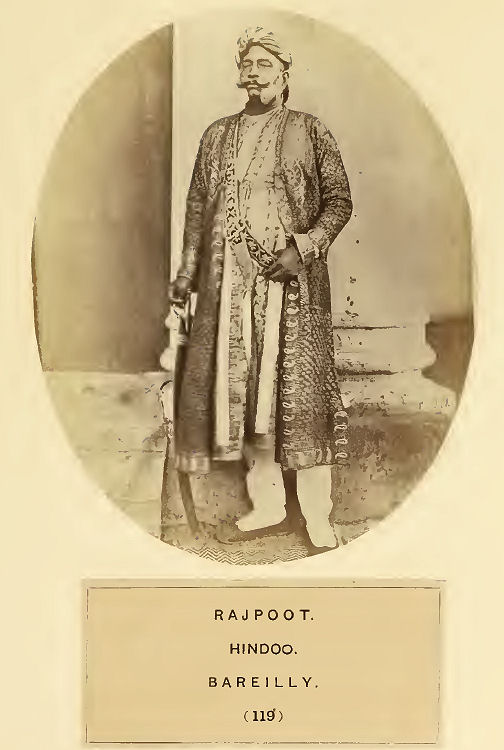
Abb.: 119. Rajpoot. Hindoo. Bareilly.
[a.a.O., Bd. 3]
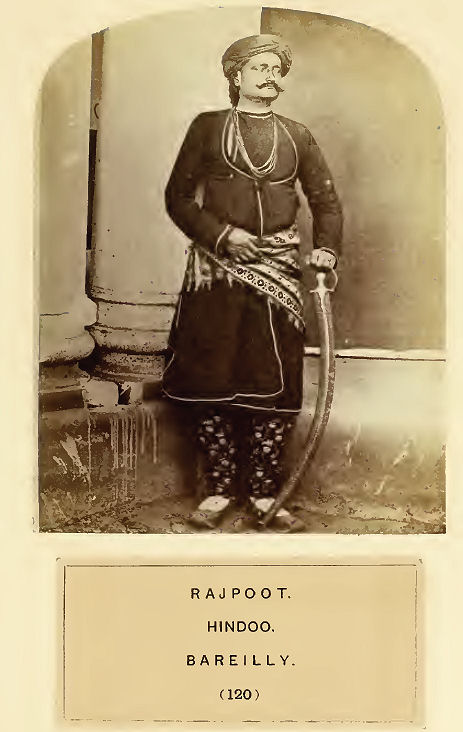
Abb.: 120. Rajpoot. Hindoo. Bareilly.
[a.a.O., Bd. 3]
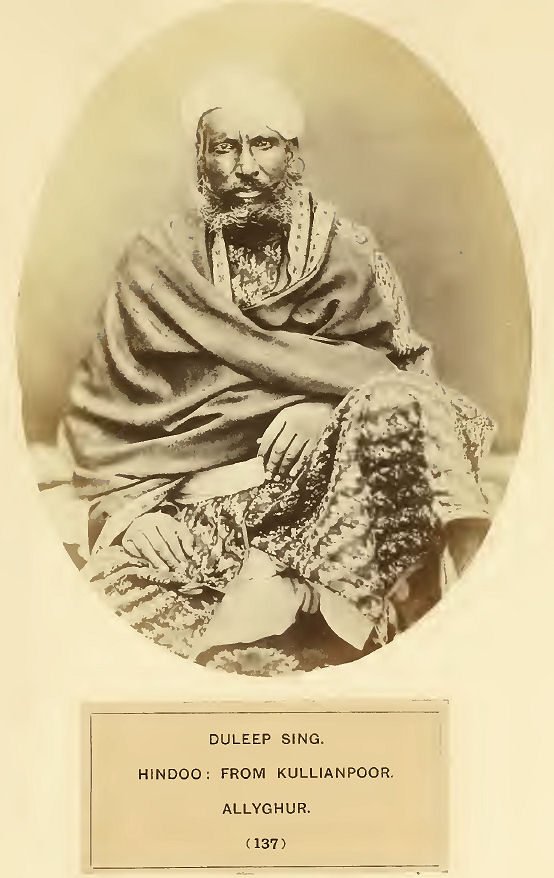
Abb.: 137. Duleep Sing. Hindoo : from Kullianpoor. Allyghar.
(199)
Illustrations of Rajpoots as single figures, have occurred (ante Nos. 119, 120, and 137). The present group is one of Chohan Rajpoots, of which tribe No. 137 was a single specimen, and with it a sketch was given of the legendary history of the Chohans, who arrogate to themselves the highest position among all Rajpoot clans ; nor, except perhaps by the Haras, is this disputed. It is not necessary to recapitulate the particulars of the Chohans already given; but a sketch of the distribution of the Rajpoots of the North-Western Provinces of India, and of the tribe in general, may be useful for reference on future occasions.
Brahmins assert that the Kshatryas, or Kshuttries, are extinct. Rajpoots, however, consider themselves of this grade, which is next to that of Brahmins in the original scale, or four divisions of Hindoo castes, and there is no indication, either from feature, form, or character, that the present Rajpoots of the highest clans, Chohans, Haras, &c., are in any way debased from the original stock. They are still essentially warlike and exclusive ; preserving then traditions of descent by the strictest rules of intermarriage, and the rules of their caste as it appears to have been originally established, as far as was possible under the progressive alterations of social existence and polity. They profess in general but a small reverence for Brahmins in the abstract, and the quarrel between the Rajpoots, or Kshuttries, and the Brahmins, is as old as the Mahabharat, or older. In social rank the Kshuttries claim the highest grade. When Brahmins were only priests, the Kshuttries were rajahs, or lords. They were the conquerors and rulers of kingdoms. As they subdued the aboriginal races and founded local states, the Brahmins followed them, served them in a priestly capacity, and were the depositaries of learning, which the Kshuttries despised. In the Mahabharat, the record of a war between two Kshuttrie races, the rivals are members of a ruling family, the combatants are of their own tribes, and the Brahmins are mere spectators, counsellors, or priests of national sacrifices and ceremonies, evidently holding their original position, which is similar, perhaps, to that of the feudal lords and the church of the early and middle ages in Europe.
Gradually, however, knowledge prevailed over mere power; and as the Brahmins rose by the exercise of their learning, so they reduced the Kshuttries to the condition of dependents upon them for religious exercises, for purification, and for general counsel. The ancient princes became, from their persistent ignorance, priest-ridden; so losing their independent and dominant character, and degenerating into helpless reliance on the subtle doctrines and practices of the Brahmins. As these ancient princes and their bards had become the depositaries of national warlike traditions—their especial glory—the Brahmins gradually introduced into them commentaries and fables of their own, by which means not only were the original purport of the traditions altered to suit Brahminical purposes, but perverted to set forth the glory of Brahmins, and the only secondary position of their rivals. Such alterations of original position have been too common a result of struggles between power and intellect in the history of the world to need notice here ; and in the cases now alluded to, there is nothing presented to the view of the inquirer to vary the course of that result in the present condition of the two sects. They are as they became; the one uneducated, ignorant, superstitious, suspicious, haughty and yet frank, open, and faithful. The other intellectual, learned, subtle, and apparently pliant ; but in respect to religious differences, unapproachable in assumed purity, and consequently dominant. The Kshuttries never pretended to the creation or possession of a national literature. The Brahmins established what is now found existent ; and it is from that, under the application of modern discovery and a better acquaintance with the Sanscrit language, that the original positions of the two sects are being better understood. In one respect, however, they are inseparable. They are the Aryan conquerors of India ; and while the Kshuttries fought their way eastwards and southwards, and the Vaishyas traded, the Brahmins, as befitted their vocation of priests, conducted the religious rites and ceremonials of all, and gradually developing a subtle metaphysical philosophy, and the invention and detail of a pantheon which excites modern wonder, arrogated to themselves a superiority of rank by divine institution, which though often assailed, has never been broken.
To write a history of the Rajpoots, would involve a history of India. At the period of Alexander's invasion of India, B.C. 331, they were found the dominant powers, as well as the warriors of the land. Brahmins then were only priests and philosophers. The Grecian hosts encountered the Rajpoots in the north-west, where they are now in the greatest numbers, and in the greatest purity. But they may be traced into Bengal, where several of the main tribes settled as conquerors ; and as the victorious Kshuttries marched to Ceylon, they left there, and on their route, colonies of their people, -who grew and multiplied. Again, when the Mahomedans had conquered the Deccan and Southern India, and these provinces were garrisoned by imperial armies, colonies of Rajpoots were left in the positions in which their descendants are now found, as garrisons of forts, or in the military stations of that period, and continue, with their character and traditions unchanged, and their purity of descent apparently uncorrupted, up to the present time.
What remain of the original Kshuttrie or Rajpoot kingdoms, are the principalities of Rajpootana, which have survived the revolutions of centuries, and the efforts of the Mahomedan emperors to subdue them. They were often brought low, but never entirely broken. They seem to have possessed not only inherent vitality, but the faculty of bending after a haughty fashion, of winning respect, and thus to have maintained their national existence while others perished. After the Mahomedans, they had to sustain the shocks of Mahratta leaders, who were no respecters of race or creed. But they have survived the disappearance of the Mahrattas, as they did the destruction of the Mahomedan power, and are now the loyal allies of the crown of England. A strange destiny if its course be traced ; and a still stranger instance of how little tribal constitution and character can be affected during three thousand years, whether by successive waves of conquest, or revolutions of local powers, if its original constitution had elements of cohesion, even in human pride and exclusiveness.
The present tribes of Rajpoots are found for the most part in the independent states of Jyepoor, Oodeypoor, Ajmere, Joudpoor, and in the great area between the Sutlej and Indus to the west, the Ganges and Jumna to the east and north, and the Nerbudda to the south, where they form a large and important portion of the general population. The chief clans are the Chohan or Chowhan, the Rahtore, Hara, Jhareja, and Ratoch. Of these the Chohans are most numerous in Mynpoorie, the Haras in Harowtee, their especial province, the Jharejas in Cutch and Guzerat. In Oude the Rajpoots form the almost exclusive military population, although engaged in agricultural pursuits ; and it was from this province that the Bengal army used chiefly to be recruited. The Rajpoots of Oude, as the descendants of those who were led by King Rama to the conquest of Ceylon, are as proud and haughty as the Chohans and Haras of Rajpootana, but are not considered so pure. Among these are the Sirnet and Visen clans; also the Kausika, Gautamiya, all Soorujbunsi, or children of the solar race. The Sirnet (a Mahomedan title), profess to be descended in a direct line from the Bharata or princes of Hastinapoor, near Delhi, the earliest Hindoo kingdom and the scene of the Mahabharat. Again in Bengal are found the Bais, Bhojpooris, Bughela, Rughbunsi, Gowtura, and some others affected more or less by impure descent, but as yet distinct. Of all these the Visens are the purest.
Of the Soma, or Chundrabunsi, the children of the lunar race, there are the Kausika, portions of the Gautama, Chandel and Rahtore, Maharori and Gaharwar clans, with Nagbansi, or serpent children, and many others. It would be quite impossible, indeed, within the limits of an ordinary article, to notice all the clans of Rajpoots, and a mere enumeration of them, without details of their distinguishing legends and traditions, would only be wearisome.
The tradition in regard to the origin of the Chohans has been already detailed (ante 137) ; and some other particulars respecting the clan are mentioned in Buchanan's report on Bengal, and are as follows. The Chohans were rajahs of Chittore, a place memorable in the annals of Rajpoot valour. The last king of Delhi was of the tribe, and thus numbers of his own clan settled in his dominions, where their descendants still exist. According to an ancient manuscript there were twelve rajahs of Chittore, of which Rutna Sena was the last; and, on the capture of the city by the Mahomedans, his four sons retired to different districts. Thus, the Chohans of Gorukpoor claim descent from Nag Sen, the eldest son; another brother settled at Kangra, in the lower Himalayas of the Punjab ; another in the Mahratta country, where several Mahratta families claim descent from him; and the youngest brother at Oodeypoor, whose descendants are still reigning princes. The Chohans, therefore, continue to preserve their high hereditary rank, and with a few other clans, as Haras, Rahtores, and Amorhas, &c., are esteemed the purest of Rajpoots at the present period. It is strange how perfectly the great ramifications of Rajpoot clans are understood by themselves, and how the necessary distinctions are kept up. The great depositaries of clan genealogy are the Bhats, or bards, who, even in a far more minute degree than the old Scottish bards, preserve the history of the families to which they belong, and are, as it were, guardians of its genealogical honour. It is these men by whom marriages are decided, as they are able, it is said, to trace and detect the least taint of impurity or illegitimacy. Of the two, indeed, the latter is the most pardonable ; but the former, by legitimacy or illegitimacy, entirely impossible of reconciliation with the higher castes, and those tainted by it, sink into special classes and clans of their own.
In regard to religion and ceremonial observances, the Chohans have no particular distinctions. As next in rank to Brahmins, their marriage rites are in all respects similar ; and for the rest, they are under Brahmin guidance in all things, and affect the same exclusiveness. The Chohans have not, it is said, been as much addicted to infanticide as other clans ; but the Haras have always been the most inveterate offenders in this particular, and the Chohans being higher than them in rank, and more exclusive, can hardly, perhaps, be innocent. Of late years, although Rajpoots need not deny themselves animal food, and especially the flesh of wild hog, yet those who are most associated with Brahmins have wholly given up the use of it, considering it impure; and by others it is becoming less and less used. Rajpoots, therefore, are in by far the greatest number, vegetarians, subsisting upon farinaceous food, with vegetables, pulse, ghee, butter, and milk. Nor has this affected their strength or endurance. Some of the Rajpoots are decidedly the finest men that India produces; many among them being six feet and upwards in height, and stout in proportion, with strikingly handsome features, fair complexions, and grey eyes—the unmistakeable evidence of purity of descent from the ancient Aryans. Rajpoots, as a rule, seclude their women, but they do not use them ill ; and a Rajpoot matron, as the head of a family, is honoured and respected above all others. Their widows cannot re-marry.
The group photographed shows a party of Chohan soldiers, aimed in the native manner. The figure on the right has a broad shield at his back, which is slung over his left shoulder, and can be disengaged in a moment. It may be of rhinoceros hide, or of raw bullock or buffalo hide, pounded and cast, as it were, in a mould, which is nearly as strong. The central figure is a matchlock man ; the other two, ordinary swordsmen. Every Rajpoot is master of his weapons, and most of them perform daily gymnastic exercises, of a difficult and arduous character, to an advanced period of life. They have no objection to agriculture, but, on the contrary, are excellent farmers. They refuse, however, to hold the plough, and only do this office under necessity, and when unable to hire a ploughman. In Oude they form the great hereditary proprietary of the country, and wherever tribes of them have settled, they have acquired land and retained it.
In recent times some of them have taken up education, and are now attending schools, filling civil and other situations, for which, from their natural intelligence, hardly less than that of Brahmins, they are eminently capable.
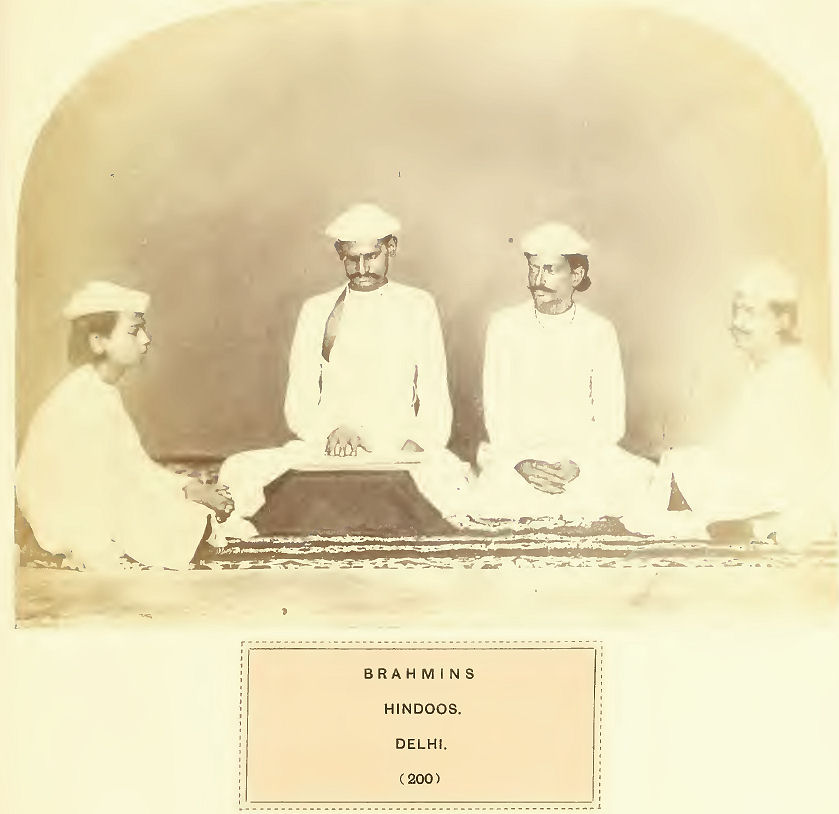
Abb.: Brahmins. Hindoos. Delhi.
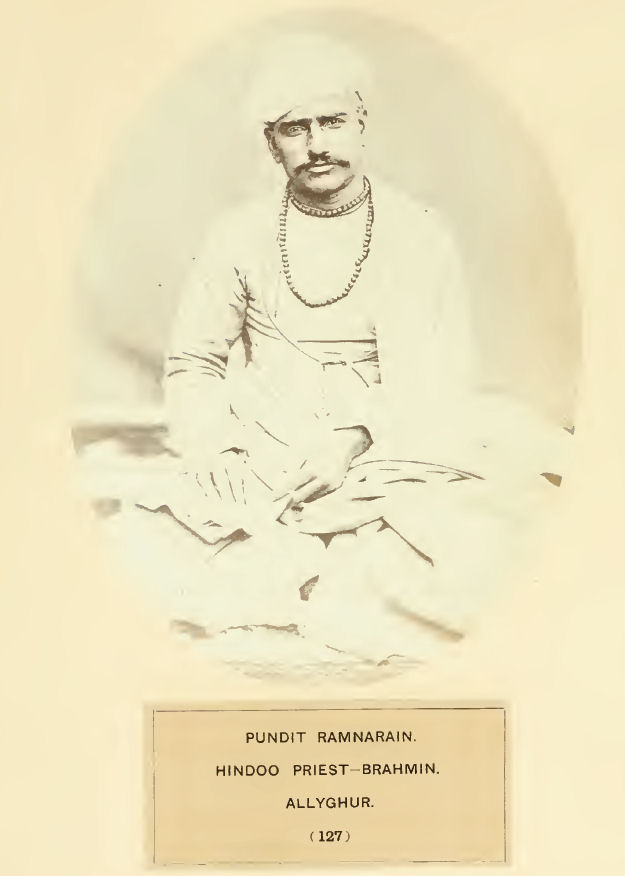
Abb.: 127. Pundit Ramnarain. Hindoo priest -- Brahmin. Allyghur.
[a.a.O., Bd. 3]
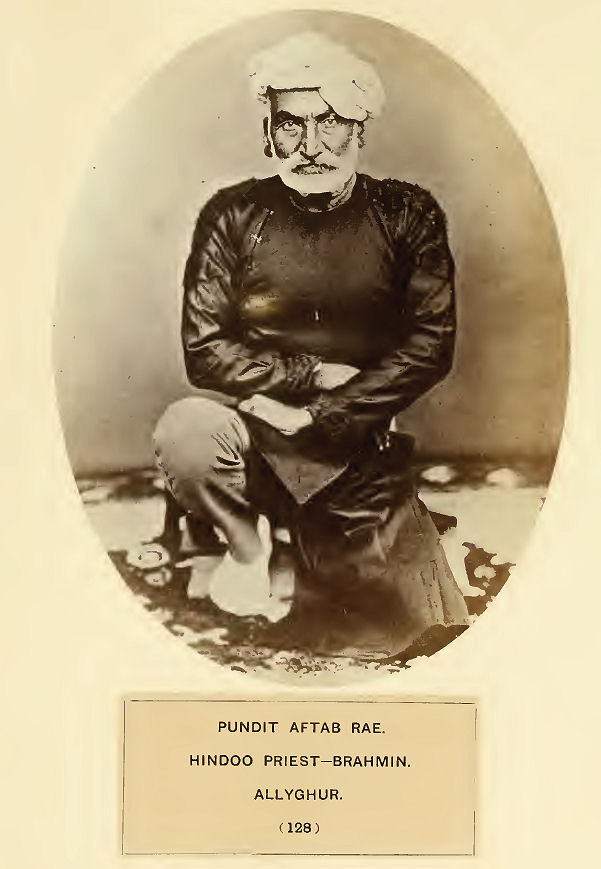
Abb.: 128. Pundit Aftab Rai. Hindoo priest -- Brahmin. Allyghur.
[a.a.O., Bd. 3]
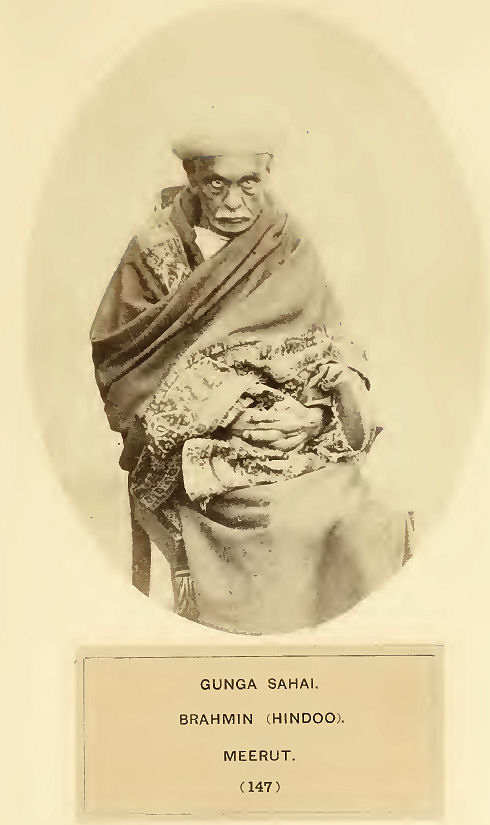
Abb.: 147. Gunga Sahai. Brahmin (Hindoo). Meerut.
[a.a.O., Bd. 3]
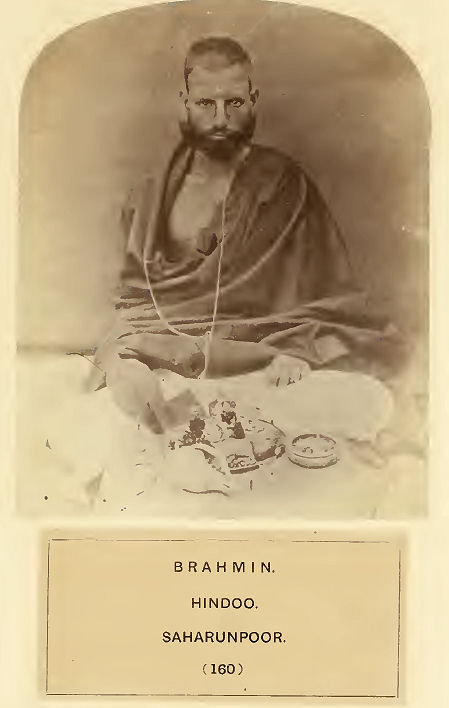
Abb.: 160. Brahmin. Hindoo. Saharunpoor.
[a.a.O., Bd. 3]
(200)
In previous numbers, 127, 147, 160, of Vol. III., subjects of Brahmins have occurred, in which some particulars of them have been slightly sketched. In the present instance a group of four persons is represented. One of these is reading, probably from a sacred book, to a boy who is sitting on his right hand, and is most likely a pupil. The other two men are apparently listening, though the youth on the right of the group may be a scholar also, of a more advanced age than the other. The sects and offices of Brahmins, and their assumed and admitted superiority over the people, as priests in general and particular, form so important a feature in the social polity of the Hindoos, that a brief review of it may not be out of place here.
In the division of Hindoo castes. Brahmins were, they assert, created the head of all. They emanated, says the sacred legend, from the mouth of Brahma, as typical of wisdom ; the Kshuttries, or waniors, from his arms, as typical of strength ; the Vaisyas from his thighs ; and the Sudras from his feet. Since then the Brahmins have been the head of the Hindoo religion, and have played an extraordinary and wonderful part in the history of the Hindoos, who form so large a portion of the intelligent and civilized population of the world. In the preceding article, No. 199, it has been assumed that the Brahmins were, in all respects, at one time subservient to the Kshuttries or Rajpoots ; that is, they were their priests and their servants, and had no pretension to temporal power. It does not appear from the history of India, that the Brahmins in ancient times ever aspired to the rank or responsibility of executive ruling power, or to princedom in any respect. That indeed would have been a violation of the fundamental principles of their order, which are poverty, abstinence, purity of life attained by seclusion and bodily mortification, with the study of holy books. But their exclusive vocation of priesthood, and separation from, and divine superiority to, all other castes, gave them, from the first, a subtle authority over the minds of their fellow men, which ages of existence has hardly modified in any degree, and which is still as powerful over millions of our fellow subjects as it ever was.
No one has been able to penetrate the dim antiquity of the Vedas, the first of Hindoo sacred works, one which, according to Menu's code, none but a Brahmin can read, or attempt to expound to the people ; but from those books the sacred character of the Brahmin was assumed. The Brahmins were the scribes (as priests) of the ancient Aryan race, of which those works are the poetic and sacred traditions; and they were collected by them into their present form. By the institutes of Menu, they were created their guardians and expounders ; and these privileged offices were protected by criminal laws of the utmost stringency and cruelty. A person who read the Vedas not being a Brahmin, should have boiling oil poured into his mouth, and the like. The persons of Brahmins were also defended by enactments framed in a like spirit. No Brahmin could be put to death for any crime, however heinous its character might be. If any lower caste person molested a Brahmin, he was to be put to death. If a magistrate even listened to reproaches against a Brahmin, hot lead was to be poured into his ears. The protection thus afforded under the law, together with then own priestly exclusiveness, preserved the Brahmins in the position they have always occupied in India, and are likely to maintain, for a period which no one can venture to define. It is true that many classes of the lower orders of the population have now their own priests—men of their own body, or selected from mendicant classes, as Bairagees, Jogies, Goosains, &c., some of whom may have been Brahmins. Also, that they are not the exclusive expounders of the Vedas, or of the Purans ; and that any one who pleases can now study Sanscrit, and read them himself or to others, without the fear of boiling oil being poured down his throat. It is true, also, that there are many heretical sects in India, of large number and influence, as the Sikhs, of the North-West; the Jains, and the Lingayets, of Western and Southern India; all of whom deny the sacred character of Brahmins, and defy their power. Nevertheless the Brahmins, while little affected by these heresies, still hold in thrall all other Hindoo sects ; nor can any material ceremony of life be performed without them. In a community of ritualists like the Hindoo, the occasions in which Brahminical aid is indispensable, are almost infinite. They are the mediums of all prayers, oblations, and offerings. A caste priest even might order them to be made ; but they would not be effectual if offered by him, nor would he have means of offering them. Such ceremonies begin ere the child of any inferior class is borm, and will continue till he dies, even at an advanced age. At birth, during childhood, during boy or girlhood, in betrothment and marriage, in fulfilment of vows, in domestic feasts, in sickness, in death, and for the repose of his soul, the assistance of Brahmins is indispensable, under any point of view, or any circumstances whatever. With the regulations of caste, the enforcement of caste rules and discipline, and the morality or immorality of members of castes, the Brahmins do not interfere. Such matters are the province of the caste gooroo, or instructor, or of its own priests. But the Brahmin's ritual supremacy is absolute ; herein he has no competitor, whether in the lowest or the highest castes. Whether in the original establishment of their order, their triumphant maintenance of it, or in the literature which they have produced during the early periods of their power, the Brahmins must be allowed to have displayed a vast continuous force of intellect. In the cultivation of their noble language, Sanscrit, they have produced philosophical and metaphysical works, which are, indeed, rivals of the remains of Grecian philosophers. There are brilliant dramas, works on mathematics, philology, medicine, astrology and astronomy, for these were inseparable, and many other subjects, all showing profound exercise of intellect, original in their aims and execution, and illustrative of the meditative secluded profession which the early Brahmins assumed. They had a monopoly of such knowledge till the Mahomedan conquest ; and it is evident, as in the case of all other monopolies of learning, that of the Brahmins flourished for a while, but eventually became exhausted by its very sameness. The original conceptions were truly very noble ; but these, diluted and weakened by repeated commentaries, and reinforced by nothing new or original, grew to be puerile and fanciful. The consequences of such a result can be easily imagined in the decadence of the ancient Brahminical, and rise of the Buddhist faith, which, in the third century B.C., rapidly overspread all India, and the adjacent countries to the north and east, flourished for a while with amazing power, and in India as rapidly died out. Nevertheless Brahminism was not dead. It had no power to withstand the sudden flame, as it were, of Buddhism ; but worked its own way in obscurity till opportunity arose for action. Meanwhile it had compiled the Purans, which contained a new and picturesque cosmogony of the world, and a pantheon of gods, unknown before, whose loves and quarrels, human sympathies and divine moralities, suited the genius of the Hindoo people of all classes, was believed with avidity, and before spiritual crusades of the Brahmins, aided by the fanaticism of their new disciples, Buddhism was crushed out and died.
The new school of Brahminical faith and doctrine had altered nothing of the old. The dim mystical Vedas, the metaphysics of the first philosophers, the non-idolatry of the first Theism, remained intact ; while the grotesque and prurient tales of the Purans suggested images which became embodied in the idols now worshipped, and in the ornaments of the temples in which they are enshrined. This strange religious revolution occurred nearly at the Christian era, and has not altered since. There are a few professors of the ancient creed who will be hereafter noticed, but by far the greater majority are Puranic Brahmins, the present priests of the people. No new sacred literature has emanated from Brahminism in its present form, and in this respect the sect is now absolutely silent and without movement. It could, in fact, only refer to the precepts of ancient fathers, and follow a course in which every element of originality of thought has long been exhausted. Brahminism is, therefore, unprogressive ; and were it not that the system of caste forms in a great measure its moral support, it might have sunk low in the Mahomedan dominion, and might, even in our own, have received severe blows. There are many who believe its influence is declining, and this may, to some extent, be the case among the educated people of India, that is, those educated in modern principles ; but these are, as yet, so very small a fraction in the millions of the people, that the Brahmins of this, and possibly many generations to come, have little to fear from them, while to the Hindoo masses in general they are altogether incomprehensible. Nor, indeed, even among these classes has any movement, like that of the Sikhs under Nanuk, or the Lingayets under Chun Bussappa, yet arisen, nor does any appear possible. Educated classes are still proud of caste distinctions, and cannot dispense with them, for there is no refuge from loss of caste; and, while their minds revolt perhaps against the ignorance and pruriency of the Purans, they dally with those doctrines and the Vedas, and remain as their fathers were, Hindoos, and thus Brahminical dominance continues to flourish.
In the text attached to No. 160, the ceremonies of a Brahmin's "pooja," or worship, are sketched ; but many other essential rites of his life are worthy of notice. The first, perhaps, is his second birth, or investitude with the sacred cord, which is the greatest ritual event of his life. Before he was born, in the fourth month of his mother's pregnancy, she had offered up prayers for her safe deliverance. In the eighth month these were repeated under a different form ; and at the birth, the solemn burnt sacrifice and other ceremonies usher the Brahmin infant into life, with prayers for his well being. When it is six days old the infant is named. At six months the first rice is put into its mouth, at a pretty household ceremony, at which all relations assist. At two years old, or according to the mother's vow, the infant's first hair is shaved off, and offered to the tutelary household divinity ; its nails are cut, and, if a girl, its ears are bored. The next ceremony with male children is the "Oopanayan," or new birth, and it may occur at any time from ten to fifteen years of age, according to the occurrence of lucky or unlucky days, or the ability of the parents to incur the expense. Up to this time the Brahmin lad is never impure; he is not susceptible of impurity. He may associate with whom he will, and, for the most part, eat what he will, without offence. After the second birth he must abjure all this, and become a professed ritualist.
The ceremony is an interesting one. The boy is at first secluded for several days, bathed, and purified, till the friends and acquaintances of the parents, male and female, assemble at the house on the day fixed, bringing garlands of flowers with them, and accompanied by musicians, themselves chanting certain litanies and holy texts. Every step in the ceremony, the arrival of relatives, and of the officiating priest, the seating of the boy under an awning of plantain and mango leaves, is marked by offerings. Presently the boy's head is shaved by the village barber; he is then bathed, anointed, and dressed in red garments; and, after sacrifice, the sacred thread is passed over his left shoulder, foiling to the right hand under his arm. At this moment his father, if living, or the priest, repeats to him in a whisper the mystic text, the Gayatri, which has received many translations, but which signifies, "Let us meditate on the adorable light of the divine ruler ; may it guide our intellects." The first thread is then removed, and one in the form which is to be worn hereafter continually, of a stronger make, is put on for every-day use.
The boy is now a Bramhacharee and a mendicant. Attired as such with staff in hand, he goes first to his mother, and touching her feet, prays for her blessing as he bows before her ; then to his father, the elders of his family in succession, and the friends of his family, each of whom gives something. Nor is it uncommon in some districts, to see the young Brahmin, accompanied by a few boys of his own rank, and attended by music, go from house to house of his town or village, and beg, as a Bramhacharee is bound to do. A feast concludes the ceremony, and at night the boy is put to sleep on a deer skin, a bed of koosa grass, or on a bare blanket, as emblematic of his poverty and renunciation of the world. For twelve days he has to eat a peculiar plain diet, and at the end of this period the ceremony is complete. The lad is no longer a Bramhacharee mendicant, but has become a "Grihusta," or secular householder. He is also Dwija, or twice-born ; for the sacrament he has completed releases him from the impurity of conception and birth, and endues him with the emanation of divine power, which he is to exercise hereafter. After this ceremony he can be married, and, as far as he is acquainted with them, can join other Brahmins in the performance of ceremonials ; but a perfect knowledge of them, even of the most ordinary rites, and of all the texts and recitations which must be repeated without book, requires long and painful study. Among many of the highest sects of Brahmins, girls as well as boys are brought into the second birth ; but women are not invested with the sacred thread, unless, indeed, they become Bramhacharees, and devote themselves to a life of penance and mendicancy, in which case they shave their heads, wear coarse white garments, and travel as pilgrims to distant shrines, not unusually dressed as men. Such classes, or other classes of Brahmins, may be met with in future illustrations, and further observations may be reserved till then. In the Photograph, the boy on the left appears to be a neophyte under instruction, the person reading may be a pundit, and the figure sitting by him the boy's gooroo, or religious preceptor.The whole have adopted the modem Hindoo dress—the turban, tunic, &c.—bound and sewn after the Mahomedan fashion. This, in other parts of India, though it might be worn on duty or during service, would be considered impure while reading a sacred book ; and the difference between the ancient dress and the modem, will, perhaps, be exemplified in these illustrations, when many other peculiarities of Brahmin sects and life may be hereafter explained.
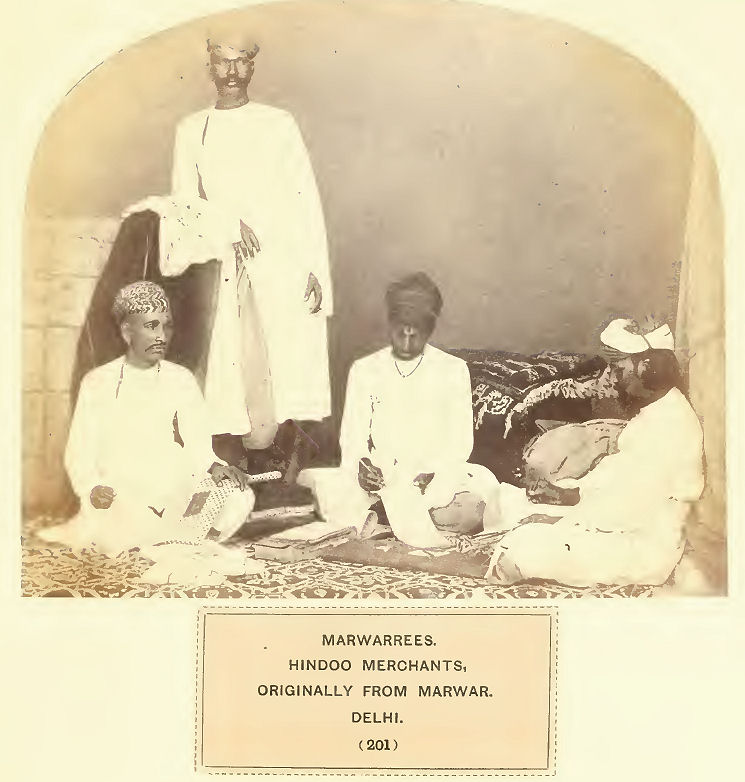
Abb.: Marwarrees. Hindoo merchants. Originally from Marwar. Delhi.
(201)
These, for the most part, are originally natives of Jondhpoor and Jeypoor, in Rajpootana, though they come from all parts of those provinces which bear the general title. They are Vaisya Bunneas, men of good caste, and, as a class, by far the most energetic and persevering of native merchants, whether as wholesale or retail dealers. They have been termed, not inaptly, the Scotchmen of India. Their country is naturally poor, producing little but what suffices for local consumption, and, indeed, hardly that in many respects; and this induces emigration to a great extent. Gradually but surely the Marwarrce Bunnea has penetrated to most parts of India. He is found in Bengal, though not perhaps very numerously, for the Bengali Bunnea is as sharp in business as himself, and, as a pithy Hindi proverb expresses it, "two swords cannot stay in one scabbard." The Marwarree, therefore, has gone south. He has spread all over Malwah and Bundekund; over Nagpoor, Berar, and the Deccan generally; and, if not to Mysore as yet, he is not far from it. At Hyderabad the fraternity is in immense strength. They count among them many, if not most, of the principal bankers, grain merchants, dealers in all sorts of produce, and importers of English manufactures, and sellers of them by wholesale and retail. By the Photograph it is evident they are at Delhi, and the group is employed checking off an invoice of English piece goods with the goods themselves. In Bombay the Mrwarree merchants are as great as at Hyderabad, if not greater, and perhaps the chief speculators in that immense place of trade. Marwarrees make time bargains for opium, for cotton, for grain, for oilseeds, and every possible product of the country; but their principal trade is in opium and in cotton. They have agents in Malwah, who expedite the opium to Bombay upon relays of camels, now most likely by the railway ; and it is shipped at once in clipper ships for China. It is a race, in tact, with opium, from the day it is packed till it reaches the China market; and the Marwarrees speculate for and against time, and gamble, as it were, in this stock with a boldness unknown to other merchants. It is the same with cotton and other staple articles of trade, whatever they may be, and with Government stocks and general securities : there are no speculators so bold, perhaps none so reckless, as the Marwarrees.
It is little to say there is a Marwarree Bunnea in every village of the Deccan, and of Berar, Khandeish, and Malwah. There may be two or three. Men who have nothing but a drinking vessel in their hands, possibly hardly more than a change of garments, and who may be begging their way from caste fellow to caste fellow from their own country, follow one another year after year, and settle somewhere. At first they may be menial servants or shopmen, travelling among villages to collect produce, and to make time bargains, or may serve in any other humble capacity ; but as soon as they can secure a few rupees, as much as mil stock a Bunnea's shop for a day, they begin life on their own account, and so persevere. It would be difficult to say what the Marwarree does not deal in—any thing by which he can make money. Scores of articles of produce, which were before neglected or almost unknown, the Marwarrees have turned into staples of commerce, not only to their own benefit, but to the benefit of thousands of the people. They put aside the hereditary local Bunneas of the country by bold dealing. The old steady Mahratta of the Deccan, or Komptee of Telingana, had few ideas beyond his occupation as a huckster. He went round and round in his daily mill, as his father did before him. Directly the Marwarree settled near him, he began to feel he was undersold, over-reached in business, and hustled aside; that the people, even his own constituents, preferred to deal with the sharp, shrewd foreigner, instead of in the dull plodding round of former traffic; and, in the end, the Manvarree had the best of the struggle, and held his own place triumphant. The Deccan and Berar people, the simple Mahratta farmers, at first thought the Manvarree a great change for the better; but, in the end, they grew to be mistaken. If the old Bunnea was, after his fashion, extortionate, the Marwarree had no scruples at all. If the Bunnea's compound interest was a sharp touch, the Marwarree's was illimitable. If the Marwarree could have calculated it day by day, he would have done so ; was it not in his bond ? If he calculated interest upon interest every month or fortnight, could any one object ? When he calculated it correctly, it was bad enough ; but when the amount was put down almost at hap-hazard, it became frightful. The whole country was, as it were, eaten up by these extortioners ; and a serious movement, which took place against them throughout the whole of the Bombay Presidency, not many years ago, might, nay would, have ended in local insurrection, like the Sontal war, if means had not been taken in time to check the spoliation which was going on.
Manvarrees now know exactly how far they can go without violation of the law, and they exact the uttermost farthing. They are the hardest creditors the people ever had, or ever will have. Woe to any unhappy farmer, who borrows to pay his rent, to marry his children, to dig a well, to pay off an old family mortgage, or to go a pilgrimage which he has vowed if a son were born, or his wife recovered from illness, and allows the Manvarree's "account" to run on. He will put down anything in that account. When the period of payment is up, he will take a new bond, wherein all old accumulations are reckoned as ready money. By-and-by the screw will be put on. The account may not be litigated in court, for the Mahratta farmer has a nice sense of honour, and he will voluntarily pay all he can. One thing is certain, he never ceases to pay, and becomes, in point of fact, little better than a serf.
If this exists under the English system, it is much enhanced under any native government. There the Marwarree is master of the situation, and drives a glorious trade. Village communes, distressed by some exaction, go to the Marwarree, tell their tale, and borrow. This leads to assignments upon individual farmers for shares of the general demand, and the Manvarree triumphs. He has not only the whole commune collectively, or perhaps severally, as constituents, but he has the individuals who compose it; and he takes produce, already under confiscation by the civil authority, at his own price. He bargains for more to cover unpaid portions and interest in advance, and his own terms are the hardest which he can extort. In such cases there is no court to appeal to ; there is no justice to be had ; the Marwarree and the civil authorities are one, and the people are ground accordingly. The Marwarree's only serious enemy in native states, except the Dacoits, is the civil authority. He knows he is watched, and in time comes the screw. It is useless to resist, and he makes the best bargain he can. His clients, perhaps, rejoice that he too has had his turn ; but to what purpose ? What has been screwed out of the Marwarree, must come back in some shape or other from the people, and does come back in time.
Once a Marwarree settles and opens a shop, he becomes a fixture. The only thing that can take him away is a great run of luck, and so much money that he can remove to a great city. In such a case he sells the goodwill of his shop to a new comer, and goes away, very probably, amidst the sincere regrets of the people. He may have become kind, and no doubt has been known to do many a good turn to his clients. He has not been always extortionate. He had grown into part of the community ; perhaps had sent for his wife, and Marwarree children had been born there. Now he is succeeded by another hungry, lean fellow, like what he was at first, and the same scenes are again enacted. The improvident people must and will borrow, and the usual results ensue. It is curious how these successive waves of Marwarree Bunneas have overspread whole districts and provinces, and how soon men who, in language and in manner, are utterly incomprehensible at first, in time grow together. To the last the original Marwanee splutters out his meaning in broken Mahratta, aided by his own rude patois, in a manner that is barely understood ; while in Teloogoo and Canarese districts, his very existence there, much less his association with any village community, is quite incomprehensible. Very frequently the Marwarree's national reputation prevents his settling in any village of a district. The local Bunnea element may be strong, and shuts up its shops by way of protest against the outsider. This scarcely signifies to the immigrant. He will surely find some place where he is not disturbed, and once he settles, he never gives up ; and, indeed, for the most part, the people have found out that it is better to encourage the Marwarree to become one of themselves, to share the fortunes of their community, than to keep him restless and striving. Thus, the Marwarree who can see the best way to permanent advantage, modifies the grinding, grasping, national spirit, and becomes the beneficial trader and local banker, greatly respected, especially when he brings his wife from his own land, and childen grow up about him. Now he is more than respected—he is honoured, nay, often beloved. His natural intelligence spreads among the people, and improvement ensues. His capital helps the whole community, and he is not, so to speak, more extortionate than the people can afford to allow him to be. He is charitable and industrious, ignorant, but liberal in his ideas and proceedings. In short, he occupies a very valuable position, and makes the most of it in a legitimate manner.
It is little known, perhaps, how much the settlement of Marwarree merchants has influenced the local progress of the provinces to which they have emigrated, and how much even their hard, griping proceedings have done to advance and accelerate progress, where they could be controlled, and where the people could be brought to a knowledge of then own right and the protection afforded by the law. Berar, one of the greatest cotton provinces of India, under the extortions of the native government, and the petty Marwarree traders and bankers, had been reduced to the lowest ebb. Under our own administration of the province, it is now a garden, and the Marwarrees have, in a very considerable degree, assisted by their capital in its development. They are now content with legitimate transactions, and extortion for the most part has become a thing of the past. And the same may be said of them in all purely British provinces. To them England is indebted—and this fact is little known—for an immense extension of its manufactures, which are carried by them into localities where they were previously scarce, and exchanged for local produce, or sold retail to the people.
Marwarree agency is not confined to India. The fraternity may be seen in China, in Africa, in Arabia, and in Persia, unchanged in character, and in their one pursuit, that of wealth. For them education has no charms. It is not one of their necessities at all. Many of them can barely read or write enough to carry on business, and a village Marwarree's books have an unenviable notoriety. The character they use is the "Mahajun," a kind of Deva Nagri running hand, very difficult to read, even by the writer. There are many jokes current against the sect in the mouths of the people on this subject. One story is, that a body of them being assembled for the purpose of deciphering a family letter from home, the following awful words were read. ''Your father, 'Aj-mur-gya,' died to-day;" upon which the usual noisy demonstrations of grief began, and the shop was shut up. Some days after, another reading of the letter took place, and the passage was found to signify, "your father, Ajmeer gya, is gone to Ajmeer ;" and the result may be imagined.
Marwarrees, go where they will, never lose their national peculiarities. They are among themselves a kind, hospitable, self-adhering, intelligent, and cheerful people. They are fond of gay dress, especially of the brightest turbans, plain and chequered, that the dyer can contrive to dye, and pieces of one colour are not unfrequently, as in the case of the right-hand figure in the Photograph, tied over others. They many only within their own gotes or clans, and most usually only one wife. They are a fine, handsome race, with strong features ; sometimes, especially their women, very fair, and even ruddy, with grey or blue eyes, the evidence of a pure descent from most likely an ancient Aryan stock. In every point of view, therefore, they are perhaps the most remarkable mercantile race in India.
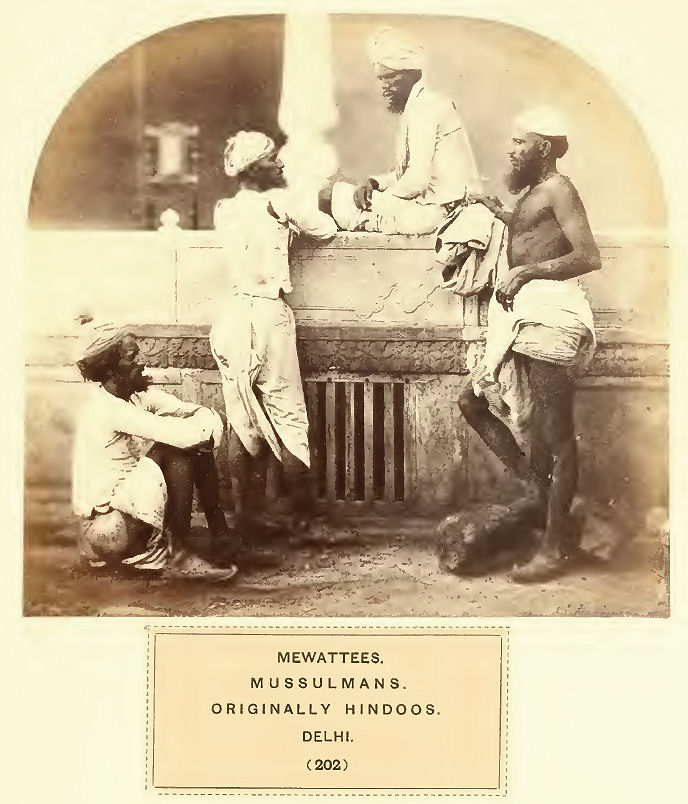
Abb.: Mewattees. Mussulmans. Originally Hindoos. Delhi.
(202)
This is another tribe of Hindoo origin, which, like the Bhuttees, Ranghurs, and others in the North-West Provinces, has been converted to Mahomedanism ; but which, in many respects, still adheres to its ancient customs and professes a very spurious character of that faith. The Mewatees province is Mewat, and they have been numerous enough to fill it and be named after it. At what time their conversion took place is not exactly known ; but it was probably the work of the Emperor Feroze Toghluk, in the fourteenth century, when so many other tribes were forcibly made Mahomedans ; and that Aurungzeeb completed what was then begun. There were other clans of Rajpoots converted at the same time, and the saying attached to these tribes, "Bara pal, bawan gote," signifies that fifty-two different clans resided in twelve places. Among these were the Mewatees. Like the Ranghurs there is a strange mixture of Hindoo and Mahomedan customs still existent among them. In fixing days of marriage, betrothment, and the like, the Brahmin astrologer is resorted to, and his directions followed with implicit credence. In negotiations for marriages also, the Mewatees employ Hindoos ; but the actual marriage services are performed by the Kazee according to the Mahomedan ritual, though all of the ceremonies attendant upon them are Hindoo, especially those with which the women are concerned ; for among them the Hindoo customs are more perfectly preserved than among the men. The Mewatees will not contract marriages within the prohibited degrees of relationship recognized by Hindoos. This is a strong mark of original Hindooism, as Mahomedans allow the marriage of cousins, and families frequently become very intricately connected in consequence. The Hindoo custom of a younger brother taking his elder brother's widow to wife under the Durejah form of marriage is still followed ; but an elder brother cannot take his younger brother's widow in the same manner. Mewatees, as Mahomedans, eat animal food within the kinds allowed by Mahomedanism ; but it is said of the tribe, that wild hog is not yet entirely objected to, cooked in the ancient Rajpoot fashion, and that the women still resist eating beef, which they declare would cause them never-to-be-redeemed impurity. Like most of these half converted tribes, the women have a far greater veneration for, and attachment to, the ancient belief than the men. Both men and women have, however, great faith in particular saints. Those of the Mewatees are Shah Mudar, of Mukhinpoor, near Cawnpore, and Sheikh Salar, of Oude. To the shrines of both these holy persons the Mewatee women take their children at certain ages, according to vow ; but generally when teething is completed, or at from two to three years. The original hair, which has never been cut in these cases, is then shaved off, and offered up with a thank offering to the saint for having guarded the child's life. It might be thought that this custom savoured of Jewish origin ; but it is strictly Hindoo, and one of the strongest evidences of a Hindoo origin and maintenance of ancient custom. Every Hindoo mother vows the first hair of her child to her tutelary divinity ; and when the period of her vow has run, resorts, if possible, to the most venerated temple of that divinity within reach. Should this be impossible, however, the ceremony is performed as home, in the name of the god, and the hair shaven off is sent by a special messenger to the shrine, to be offered up by a Brahmin. This ceremony is never omitted, even by the highest caste Brahmins, as well as all other classes of Hindoos, high and low ; and it is strange, perhaps, that a similar rite as regards the first born is practised by all classes of Mahomedans throughout India, on the sixth or fortieth day after birth. It is difficult to say whether this is an original Mahomedan custom or one adopted from the Hindoo. It is, however, in any case, entirely different from that of the Mewatees.
The Mewatees have not by any means a good reputation as a tribe. They are, according to a local report, "like the Goojurs, thieves and cattle stealers, and have the vices of Mahomedans without the virtues of Hindoos." In the mutiny and rebellion, in some districts, especially around Agra, they were more troublesome even than the Goojurs, adding to their original evil disposition the bloodthirstiness of Mahomedan fanatics. In the latter particular they were led on by their own priests, who are for the most part ignorant and very bigoted ; and, on the occasion in question, preached the "jehad," or holy war, to their followers, exciting them against the Christians and Hindoos of these localities. Their acts of rebellion were, however, quickly suppressed, and the tribe resumed its usually peaceful employments. These are, for the most part, agricultural ; but a few take service as irregular soldiers with native princes, and are found south as far as Hyderabad, in the Deccan, where some of them are in local employ. There are a few also in the ranks of the irregular cavalry ; but Mewatees do not enlist in the infantry. The clan is not migratory, and has the strongest attachment to its own lands ; and although members are found in foreign service, they never take their women with them, and invariably return, after a period, to their own country.
As a race, the Mewatees are one of the finest of the North-Wcst Provinces. The men are tall, muscular, and athletic, capable of great endurance, and have the reputation of being highly skilled in the use of their weapons, both as swordsmen, and marksmen with the matchlock, in which they are instructed from boyhood in their village gymnasium. In colour they are generally fair, if not ruddy; and their women are reported to be beautiful and strong. They are, however, seldom seen, as they are almost invariably secluded. The dialect of the Mewatees is a broad patois of Northern Hindostani, in which the Hindi words of their original Rajpoot sect are largely mingled ; and the women in particular are said to speak almost a pure dialect of Hindi. In general appearance they bear a strong resemblance to Afghans, and, away from their own country, are not unfrequently mistaken for them. Their costume is more Hindoo than Mahomedan, as they seldom, if ever, wear pyjamas or trousers, and the mirzaee or short jacket is only distinguishable from the Hindoo by being tied or buttoned on the left side, instead of the right. Their women wear the full petticoat, bodice, and scarf, neglecting the trousers, which are the distinctive costume of Mahomedans. The men allow their beards to grow, but not to any length ; and the group represented in the Photograph is a fair specimen of the lower classes of the tribe, when without arms, and acting as farm labourers or in other menial capacity.
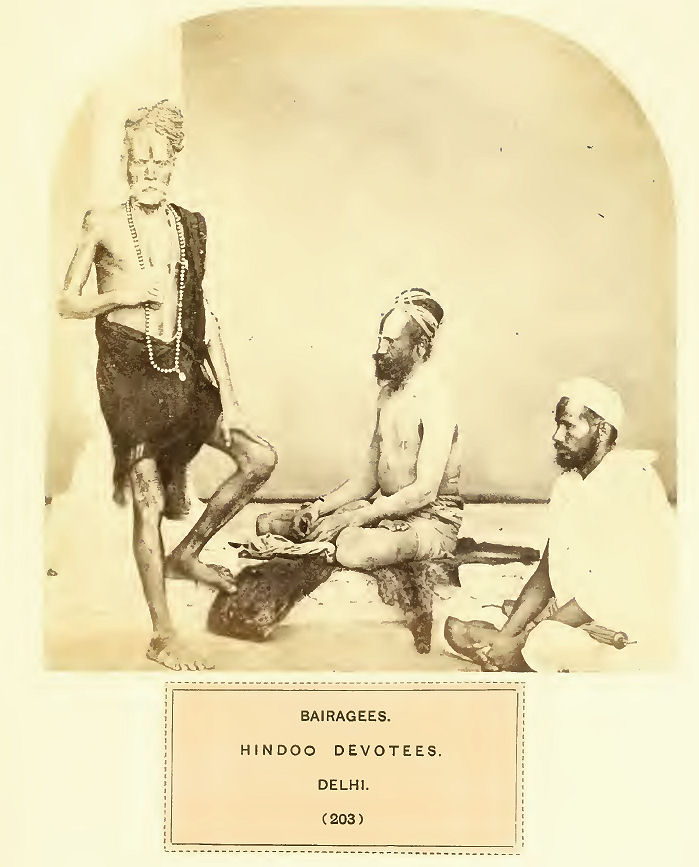
Abb.: Bairagees. Hindoo devotees. Delhi
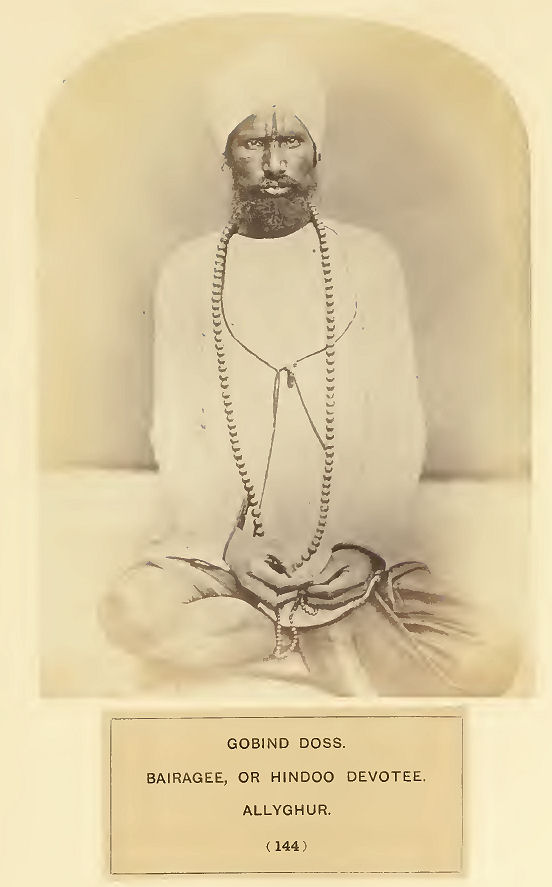
Abb.: 144. Gobind Doss. Bairagee, or Hindoo devotee. Allyghur.
[a.a.O., Bd. 3]
(203)
In a former number, 144, Vol. III., a representation of a Bairagee was given, who was a lay member of the order, or who had ceased, perhaps, to practise austerities of a severe nature. In the present instance, however, two members of the order are given in the guise in which they usually appear, either when migratory as performing pilgrimages, or engaged in local practices of penance. These are men who have for the present, at least, renounced the world, and who perform the habitual penances described in the article No. 144. The central figure may have been a Brahmin or Rajpoot, as he still retains the junwa, or sacred thread of the "twice born," which hangs over his left shoulder. The standing figure has no such thread, and may have belonged to any lower Hindoo caste; and the sitting figure on the right hand may be a visitor, or possibly professing to become a Bairagee. In the two Bairagees there is little of costume to describe. Their matted hair is wound round then heads instead of turbans ; their foreheads are marked with the broad trident of Vishnu, red in the centre and white on each side. The sitting figure has covered himself with wood ashes only ; the old man standing has marked himself with his usual caste marks about the body, and wears a coarse black blanket thrown over his left shoulder.
These men are fair specimens of the generality of Bairagees, but there are others whose limbs have stiffened into various positions under penances, and who have become inexpressibly frightful and hideous in appearance. These classes were described, as they are at present, in the Greek accounts of India. When Alexander sent for a number of them to speak with, and they refused to come, Onesicritus, as related in Strabo, quoted by Elphinstone, went to converse with them. He found fifteen persons about two miles from the city, naked and exposed to a burning sun, some sitting, some standing, and some lying ; but all immovable from morning till evening in the attitudes they had adopted. One of these ascetics, Calanus, became attached to Alexander, and accompanied him towards Greece, but falling sick in Persia, determined to burn himself, and resisted all persuasion to prolong his life. He ascended the pile prepared for him with the utmost serenity, and died singing Indian hymns. Another Indian ascetic burned himself at Athens. Of two others in Alexander s camp, one lay all day in the sun and rain, the other stood on one foot. Such were the ascetics of 2200 years ago, such they remain ; unchanged, perhaps, in any particular of doctrine, practice, or costume. Then, as now, men unable to perform habitual penance, and seduced by the enjoyment of worldly pleasure and riches, may, as some Bairagees do, enter monasteries, and live, if not luxurious, at least quiet, uneventful lives, instructing children, feeding travellers, and doing good offices as far as possible ; but the fierce, fanatical spirits among them, such as those shown in the Photograph, know of no rest till they die. Where that may be, or how, they have little apprehension or care ; nor has it been uncommon for members of these fraternities, weary of life, martyrs to some painful or even fatal disorder, to fling themselves under the wheels of an idol car, to leap from the sacred rock into the Nerbudda, or stand in the Ganges as the flood is rising till it overwhelms them. Self sacrifice among these classes of Bairagees is as frequent now, perhaps, as it was when the Greek philosophers beheld it in amazement, and recorded it as a noble virtue in a heathen. Where they go, what they do, who can tell ? Once a Bairagee has forsaken wife and children, home and friends, he rarely returns. They are dead to him, he is dead to them. Henceforth he wanders to every shrine of Krishna in India if he can, and as age prevents movement, crawls into some monastery, some cave in a lonely ravine, some chapel by the wayside, and lies there till villagers find him, help him if he be susceptible of help, or bury him if he dies. Infirm and worn out, such wanderers, if they live, frequently attach themselves to the community which has protected them, and die at last in the full odour of sanctity.
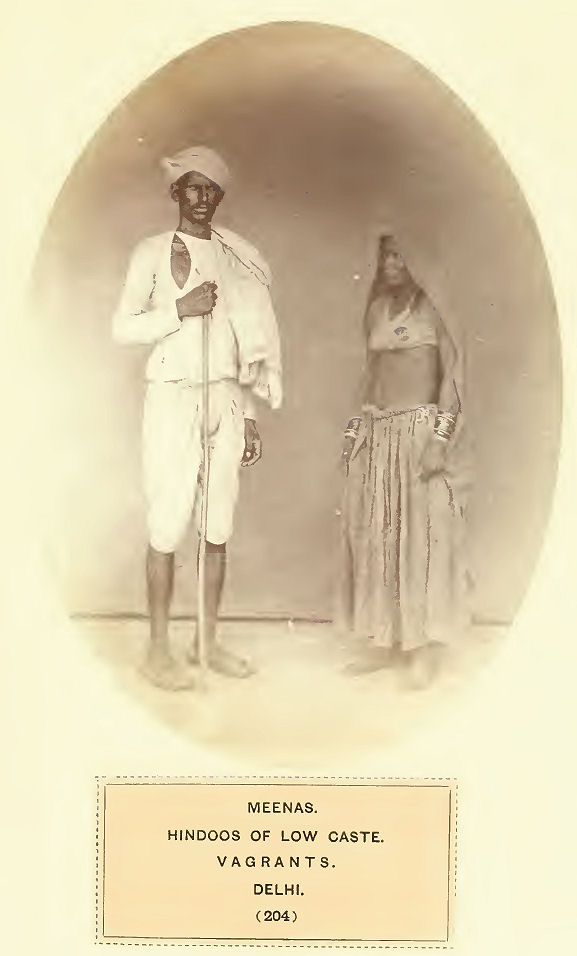
Abb.: Meenas. Hindoos of low caste. Vagrants. Delhi.
(204)
The Meenas are one of the aboriginal tribes which formerly, perhaps, peopled Rajpootana, where they still remain. They are found in Jeypoor, Joudhpoor, and generally all over Rajpootana; but it is only as one of the wandering races of the north-west that they are seen at Delhi. As such they bear the worst of characters. They have been Thugs and. Dacoits, and may be classed with the Sanseeas, the Khunjurs, and other habitually and hereditarily predatory classes, who are as yet unreclaimed, and to many appear unreclaimable. Of late, some attempts to redeem the Meenas have been made with success ; and there appears no valid reason why all these wandering and mischievous tribes should not be collected, and prevented from preying upon the community at large, as they may have done for thousands of years. In their own country the Meenas are watchmen and village servants, and scouts of a low degree. Being thieves themselves, they are capital trackers of others ; and it is surprising with what accuracy and intelligence the "spoor" of cattle, or of men, will be followed over arid tracts and hills, where the impress of a footstep would appear to others than a Meena quite impossible of detection. But wherever he is, migratory or settled, the Meena is a robber. In his own country, where gangs can assemble, distant expeditions, involving the employment of many men, may be organized, and considerable booty be the consequence ; but away from home, the Meena has to trust to his own resources, and he is by no means so quick-witted as the Khunjur or the Sanseea. He has no hereditary profession, and is obliged to work, very indifferently and lazily, as a day labourer or tiller of the soil. Instead of this, the Meenas and their women infinitely prefer to steal, and do so whenever they have an opportunity ; being pickpockets, or cutters away of pockets, which is dexterously done with a sharp knife in crowded bazaars. They can beg also, and can affect the most wretched poverty, with the peculiar whine which is supposed to excite charitable feelings ; and as they are generally suspected of prying about with a view to robbery, they often succeed in obtaining small donations. Some of the women are supposed to possess secrets of charms and love philtres, and the use of particular herbs ; but in most cases they are like their husbands, idle and thievish, and in the lowest condition of poverty and degradation. Meenas profess to be Hindoos, but they are outcasts. Like all of the lowest converts from aboriginal tribes, they are worshippers of Kali or Devi (Bhowani) ; and that not of love or adoration, but of dread, and after a deprecatory fashion, which extends to Gram Deotas, evil spirits, and the like. They fear the ghosts of their dead, and make sacrifices for the peace of their spirits, observing with great care the ceremonies for that purpose, and employing Brahmins, where they can afford to pay for them, for these rites ; and they are abject believers in all sorts of apparitions and ghostly appearances. As a class, they are utterly ignorant and uneducated, and yet by no means deficient in natural intelligence, as evinced in conversation, demeanour, and aptitude for tilling the soil, watching the crops, the menial offices in which they can be employed, &c. &c. The reclamation of the entire tribe is perhaps impossible, owng to its being spread over so many independent states ; and so long as it exists, portions of it will always be migratory, and in effect changeless. In appearance there is little to distinguish Meenas from other low Hindoos. They wear the same costume, both male and female ; but in the female, there is not the same attention paid to decent covering of the body, as there is in classes of a higher grade. Meenas marry in their own caste exclusively, and are not, as a rule, polygamists. Their marriage ceremonies are conducted according to the Hindoo rites, and, as well as the naming of their children, are performed by Brahmins, if the parties are rich enough to afford their services ; if not, according to a simple caste rite of their own. In travelling they have no tents or grass huts, but contrive to get shelter in villages, in outer cloisters of temples. They are great frequenters of small fairs and village markets, where they have the best opportunities for the commission of petty thefts, or get small jobs of labour, by which they subsist. Meenas eat animal food of all kinds, except beef; and they drink spirits to excess, and smoke intoxicating drugs, when they have the means of purchasing them. But it is not often they are able to afford good food, especially when unsettled, and they live chiefly on meal and pulse, which their women beg in the bazaars, aided by what small wages they can earn. Of the Meena tribes—and they are numerous—the Puriars are the chief, who affect a Rajpoot descent, and have been singularly intractable and mischievous in their predatory character. The peculiarities of this tribe will be detailed in their proper place.
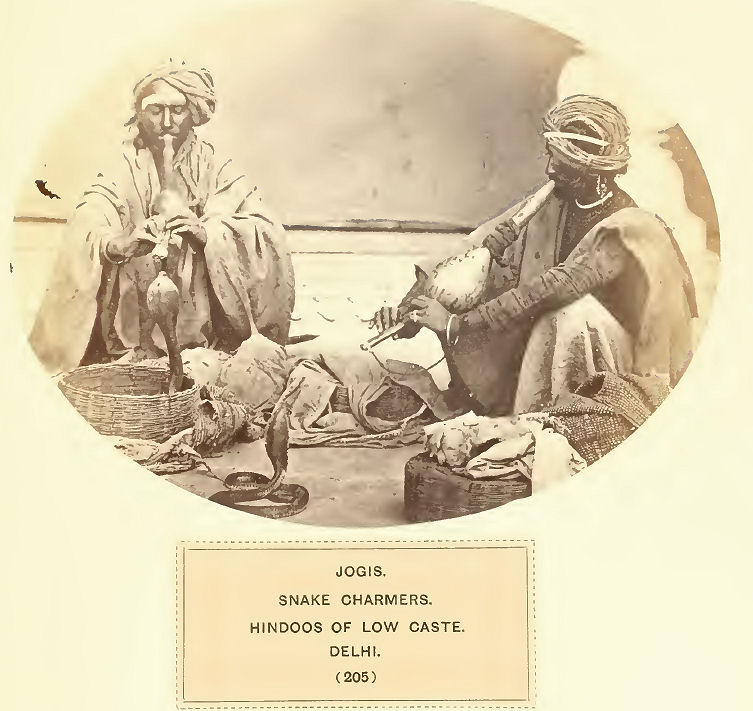
Abb.: Jogis. Snake charmers. Hindoos of low caste. Delhi.
(205)
These Jogis must not be confounded with Jogis who are religious devotees, an Illustration of whom was given, No. 158 of Vol. III. They are a low caste, migratory tribe, found almost all over India, who share the profession of catching, and, to a certain extent, taming snakes, with Mahomedans of the same character. The Photograph displays two of the tribe exhibiting cobra capellas, or nags, and playing to them upon an instrument made of a gourd of peculiar shape, into which a reed with holes is fitted, which has six holes; sometimes there are two reeds set side by side. The sound is like that of a flageolet, and is often mellow and sweet, but there is little attempt made at time or melody. Strange as it may seem, the hooded snakes appear to delight in the sound. They raise themselves, spread out their hoods, and sway their necks to and fro in time to the music, occasionally making darts at the end of the pipe when it is thrust at them. These snakes are caught at their holes when needed by the snake charmers, and not without risk. After playing for a while, the wily reptile will be seen at the entrance of his hole, when the music becomes louder and more exciting ; the Jogi withdraws gradually, and the snake follows, till he is far enough to be caught adroitly by the neck or by the tail, and, in the latter case, the captor runs his hand rapidly along the body up to the head, when the jaws are seized ; the head is then held on the ground, and the poison fangs forced out by a pronged stick. After this, the reptile is harmless, and is gradually educated for exhibition ; but Jogis assert that it takes a long time for them to recover their courage.
To preserve themselves against the effects of snake bites, Jogis have several antidotes known to themselves, among which is the well authenticated snake stone. What its peculiar consistence or properties are, are perhaps unknown ; but if affixed to a snake bite, or sting of a scorpion, it undoubtedly holds fast, and draws off the poison. The Jogis themselves, however, believe that their safety depends upon the "Mantras," or incantations, which are hereditary secrets among them that are never divulged, and not upon antidotes. These snake exhibitors have usually many kinds of reptiles in their baskets, large rock snakes, and boas, armadillos, and mungooses, which are trained to fight with snakes; the bright eyes are often seen watching the snakes' performance, till their own turn comes ; and it is curious to observe with what eagerness and agility these beautiful and graceful little animals avoid every dart of the reptile, until they see an opportunity of attacking in turn.
The Jogis are frequently, indeed mostly, very handsome men, and their women are equally good looking, with regular, delicate features. They are always dressed in garments of a peculiar yellow or orange colour, which they dye themselves. They are worshippers of Siva, and his consort Bhowani, and have many secret rites, the particulars of which are unknown. They also make offerings to Shah Madar, the saint of Mukkinpoor, and invoke him in their performances, as well as gods or spirits of theire own, whose names are rarely distinguishable, and of whom they strongly object to give any particulars. "We know them," they will say, "and they know us. We dare not tell who they are. If they are not with us, could we play with death as we do, and fear it so little ? Do not ask us to violate their secrecy, and become unfaithful, else we should die." Whatever these peculiar superstitions may be, therefore, they are implicitly believed.
Jogis are not dependent upon their snakes alone for subsistence. They not unfrequently possess herds of asses, upon which they transport salt from place to place, dye stuffs and other light produce, which can be carried in small loads. In this respect, although a migratory tribe, they are perfectly trustworthy. They also sell drags and simples, which they collect in the jungles and fields ; and occasionally, when settled for a while, prescribe them to persons suffering under chronic complaints. They are believed to have valuable remedies for fevers, dropsy, rheumatism, and consumption ; and of ointments for wounds, ulcers, &c. ; and their women for the peculiar ailments of women, sterility, &c.
Jogis have often been suspected, from their entirely unsettled life, of being predatory, and of undertaking Thuggee and dacoity, with other hereditary crimes. But, though they have suffered from suspicion, they have never been convicted of offence against the law, and are, in truth, a very peaceable and well-affected class, and industrious after their fashion. Many of the Jogis appear to be in good circumstances, considering their calling in life, and indeed have the means of being so. Their women, who are not secluded, are often seen with a profusion of gold and silver ornaments, and the men with silver anklets, and wrist and throat rings. None of them are without a necklace of cowries, with a string or two passing over their turbans, and others of large size tied on their legs or wrists, with a peacock's feather or two. These are charms as well as ornaments, and much value is attached to them. They are heirlooms, and pass from father to son as possessed of peculiar virtues.
Jogis are by no means habitually intemperate, though they have no objection to spirituous liquors at feasts for caste observances, and other ceremonies of sacrifice. They also smoke ganja, or hemp leaves and tobacco, and use opium; but none of these to excess. As they profess a debased form of Hindooism, they employ the lower orders of Brahmins to name their children, to point out lucky or unlucky days, for moving their camps, or undertaking any new pursuit. They also employ them at marriages ; but by far the greater number of their ritualistic observances are rude ceremonies, perhaps aboriginal, or derived from foreign sources now untraceable.
It is difficult to hazard even a supposition as to their antiquity or origin. They may be, most likely are, as old as the Egyptians, or Assyrians, or Jews, when there were professional snake charmers, as there are now. Jogis and their women are not black, seldom, indeed, even very dark, but bright and ruddy. They have no apparent touch of Turanian blood. Among themselves they invariably claim an immense antiquity, and assert, as they have every appearance of being, that they have been exclusively pure in race from the earliest times. They know they have no rank as to caste among Hindoos, but they are not a whit the less haughty and exclusive. These Jogis are not very numerous, and are widely scattered over India. They travel in small parties or families, and have places of rendezvous, as Shah Madar's tomb at Mukkinpoor, celebrated fans, as Hurdwar, Gya, &c., in many parts of India, where they meet, discuss and settle caste affairs, make their propitiatory sacrifices, perform mystic rites, and again separate. No one knows of these meetings but the Jogis, and they concern no one but themselves. Among them there are hereditary chiefs, who are called Näiks, who are elders of the tribes, if no more. Some of the men are Bhats, or bards, and are the depositaries of legends and traditions. In short, among them there would seem to be maintained a sort of internal economy or polity which has hitherto preserved them as they are for possibly thousands of years ; and it is with a strange feeling that such a class is now looked upon, when it is considered that the same performance, by identically the same people, may have taken place in the palace of a king of Egypt or of Assyria, and that either, or both, and their subjects, may have listened to the same sweet but monotonous little tune which the Jogi plays to his snakes, now loud, now soft, from his gourd pipe, while the railway train whirls onward with a shriek, and away before him stretch the almost illimitable wires of the electric telegraph. What a period between these two ages to be filled up ! and yet that the representatives of the one, and of the other, should meet on common ground is incontrovertible.
206. FAMINE-STRICKEN GROUP.
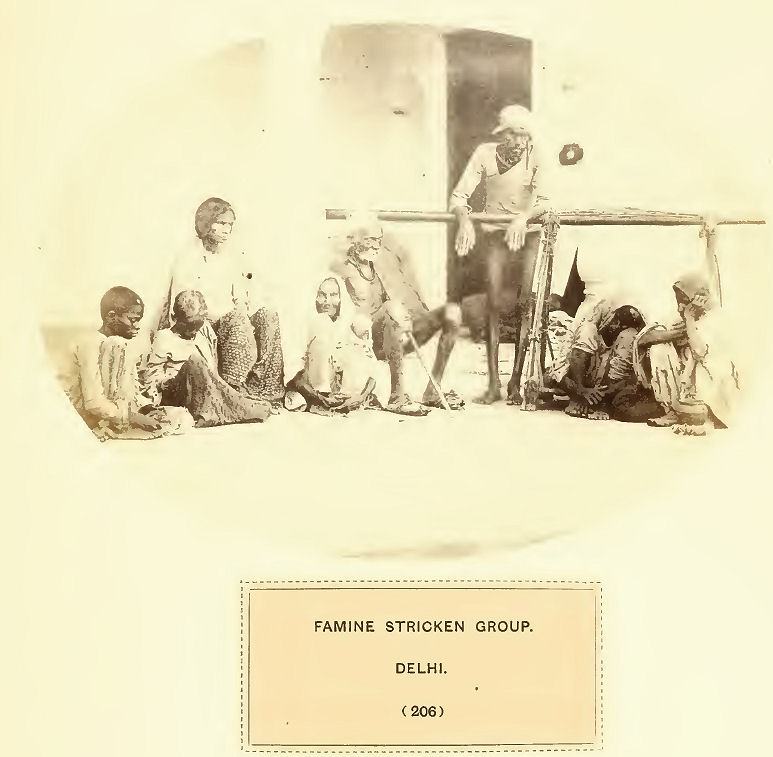
Abb.: Famine stricken group. Delhi.
( 206)
This Photograph tells its own tale ; there is no necessity to describe what is so truly and affectingly represented. The people are Hindoos and Mahomedans together; neighbours, perhaps, in some distant village where misery gradually made them akin, and they have, at last, been forced to abandon all, and crawl into the great city for relief. How many thousands did this in the famines of 1837, and that of 1860-61 ? But what a difference existed in the two periods in respect to the people. The drought and scarcity of grain in both famines were the same, perhaps; but in 1860 there were good trunk roads and railways, which brought supplies of grain in abundance ; and, except in the remoter localities of the provinces, the distress was in a great measure alleviated, if not entirely removed. In 1837, notwithstanding the efforts of Government and of private individuals, the mortality per day in two of the chief cities rose to the frightful amount of no less than twelve hundred souls, principally arising from the crowds of famished creatures who, like those represented in the illustration, had crowded in from the districts around, reaching the scene of relief so worn and wasted by famine that they were too weak to make use of the grain served out to them, and so died, with the food literally in their hands. In India, where the cereal crops depend upon a periodical fall of rain to bring them to maturity, it follows that, whenever there is no rain the crops perish ; and that between the supply of food lost, and that to come, there is an unavoidable interim of from nine to twelve months of total unproduction, and famine ensues. Unless such a locality may have the advantage of an accessible sea coast, or the benefit of a railway, it is impossible to supply food. No draft or carriage cattle can travel beyond the limit at which there is fodder for them, and it has too often happened that this embraced a wider area than even famine itself. It is not even too much to say that the great extension of local trade has added to the risk of famine, and to its pressure when it may ensue. The stores of grain which existed formerly in every village, and were preserved from year to year with little variation, are now carried away to supply distant demands; and where cotton and oil seeds, and other staples of trade can be produced, the area of land sown with cereals has proportionably diminished. Added to these causes, the population of India has largely increased under long continued peace and better sanitary precautions. In the year 1770 the great province of Bengal was desolated by famine. Upwards of ten millions of people perished : large tracts became deserted and relapsed into jungle and forest : and for many years afterwards very little progress, comparatively speaking, was made in local prosperity. That was the year in which the English Government undertook the local administration of Bengal ; and no adequate means could be devised by which the horrible mortality could be stayed, if, indeed, the progression of it was at any time sufficiently understood. The famine in Orissa in 1866, was another instance of how, even with the means of modern civilization and the desire to afford relief, little in comparison with the dreadful necessity could be effected. The coast of Orissa had no harbour where vessels could he and discharge their cargoes at that season, and the province was unapproachable by the usual roads on all quarters by land, owing to the absence of forage : again, therefore, thousands of the people perished, until the distress could be relieved. No one who followed the course of local inquiry in regard to the means adopted for relief, or the anxiety which existed in England on the subject, can doubt the earnestness of purpose which distinguished both, and the determination to watch in future any indication of the recurrence of similar calamity with a view to timely relief. Such famines as have been mentioned, and there have been many others of equally dreadful effect in other parts of India, may occur again where actual prevention is impossible ; but in the extension of irrigation by canals from great rivers, and in the construction of roads, and especially railways, there exist means of alleviation which were impossible before ; and there can be little doubt, under complete recognition of the necessity, that the Government of India will not be remiss in using them to the utmost, by anticipation of the results which inevitably follow improvident delay.
ENDE